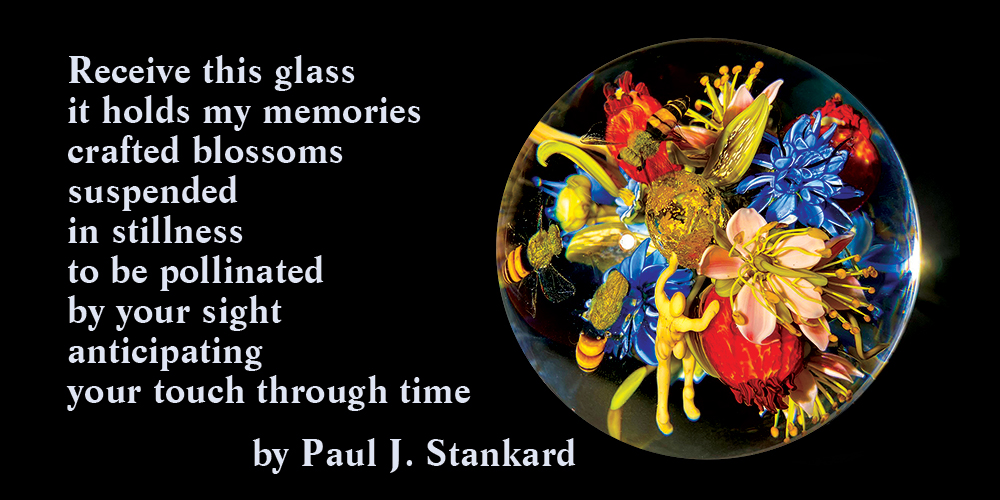The Art of the Flame, an exhibition honoring the illustrious glass artist Paul J. Stankard, opens this month with 68 works spanning his 50-year career as a flame-worker. The first forty years of Paul’s career in glass were marked at an exhibition entitled A Floating World at the Museum of Arts & Design in New York. The catalog opened: “To devote forty years of creativity to a single medium and a restricted subject matter is either an act of love or an obsession”. In Paul’s case it is both, and we believe his artistic impulse will continue way beyond the 50 years we are celebrating at WMODA.
The Wiener Collection
In preparation for this exhibition, curator Louise Irvine visited Paul Stankard along with Arthur Wiener in July. You can read about their visit in a previous Highlights blog Brilliant Botanicals. As fellow collectors of a similar age, Paul and Arthur got along famously. Like Arthur, Paul loves surrounding himself with beautiful things. Someone once told him you’re not a true collector until you need to warehouse the stuff! During the visit, Arthur was honored to acquire many unique and personal pieces for the WMODA exhibit. Throughout his career, Paul gifted some of his finest paperweights to his wife Pat and they illustrate the development of his work and personal aesthetic. Some of these are now on display as part of The Art of the Flame exhibit.
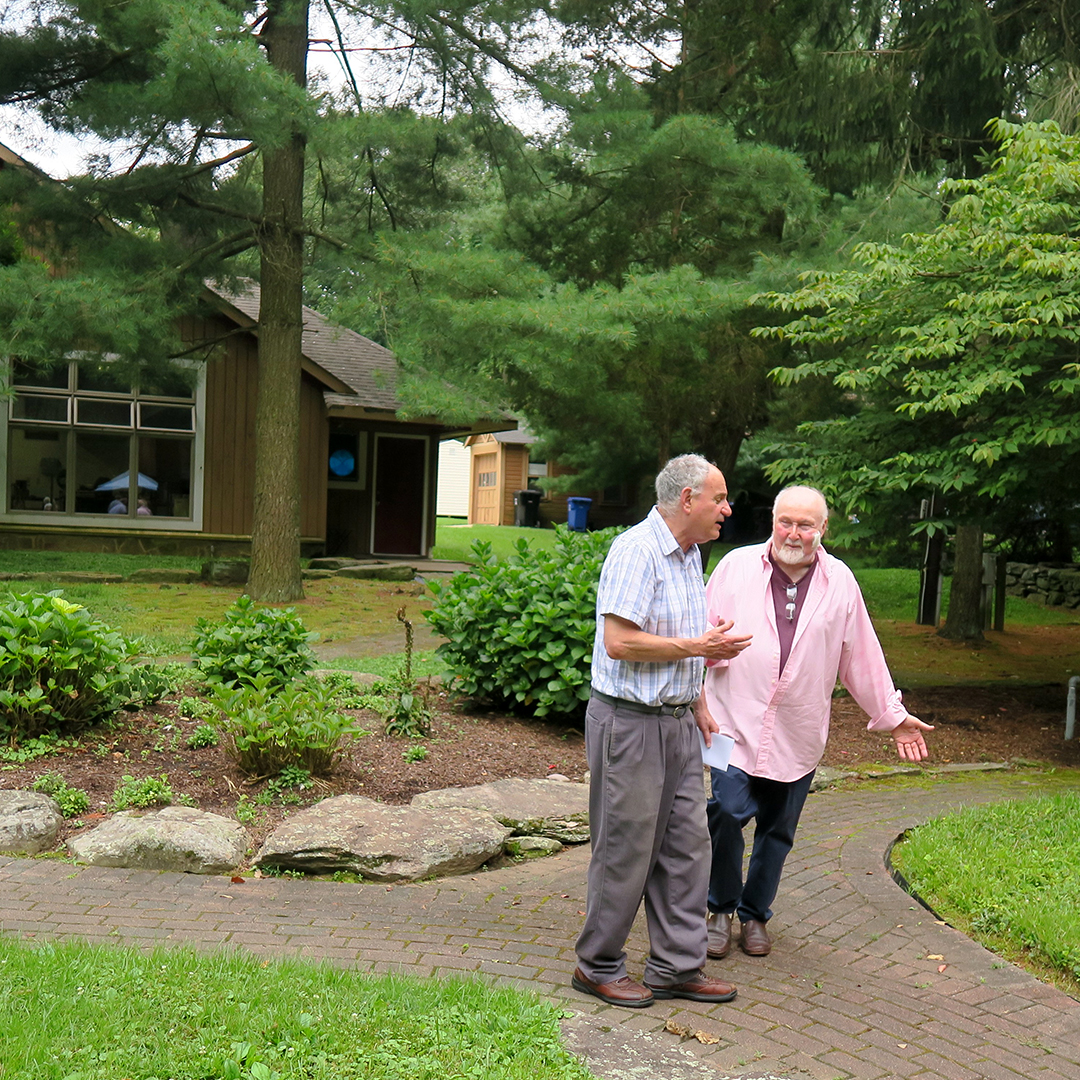
Arthur Wiener & Paul Stankard
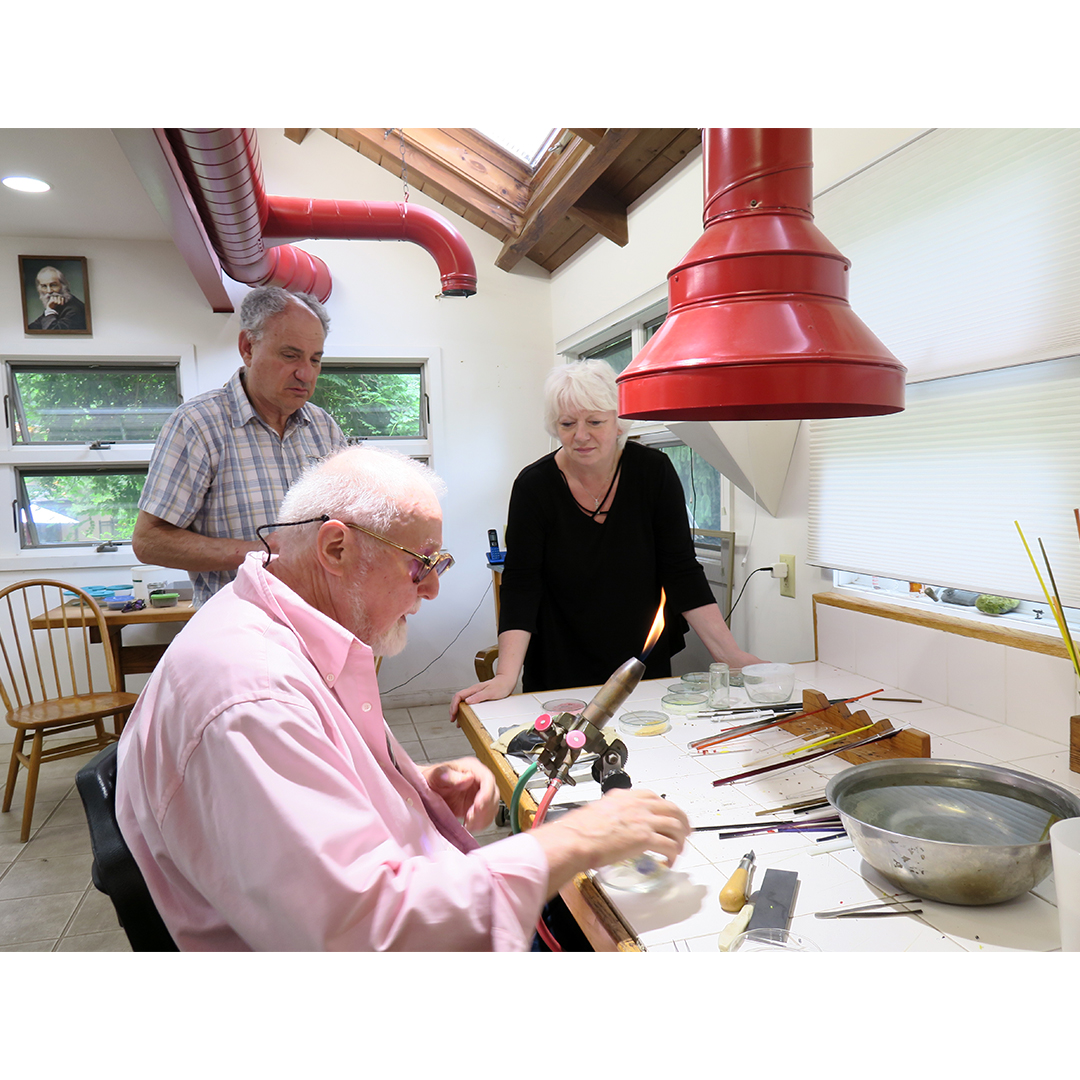
Arthur Wiener, Louise Irvine & Paul Stankard
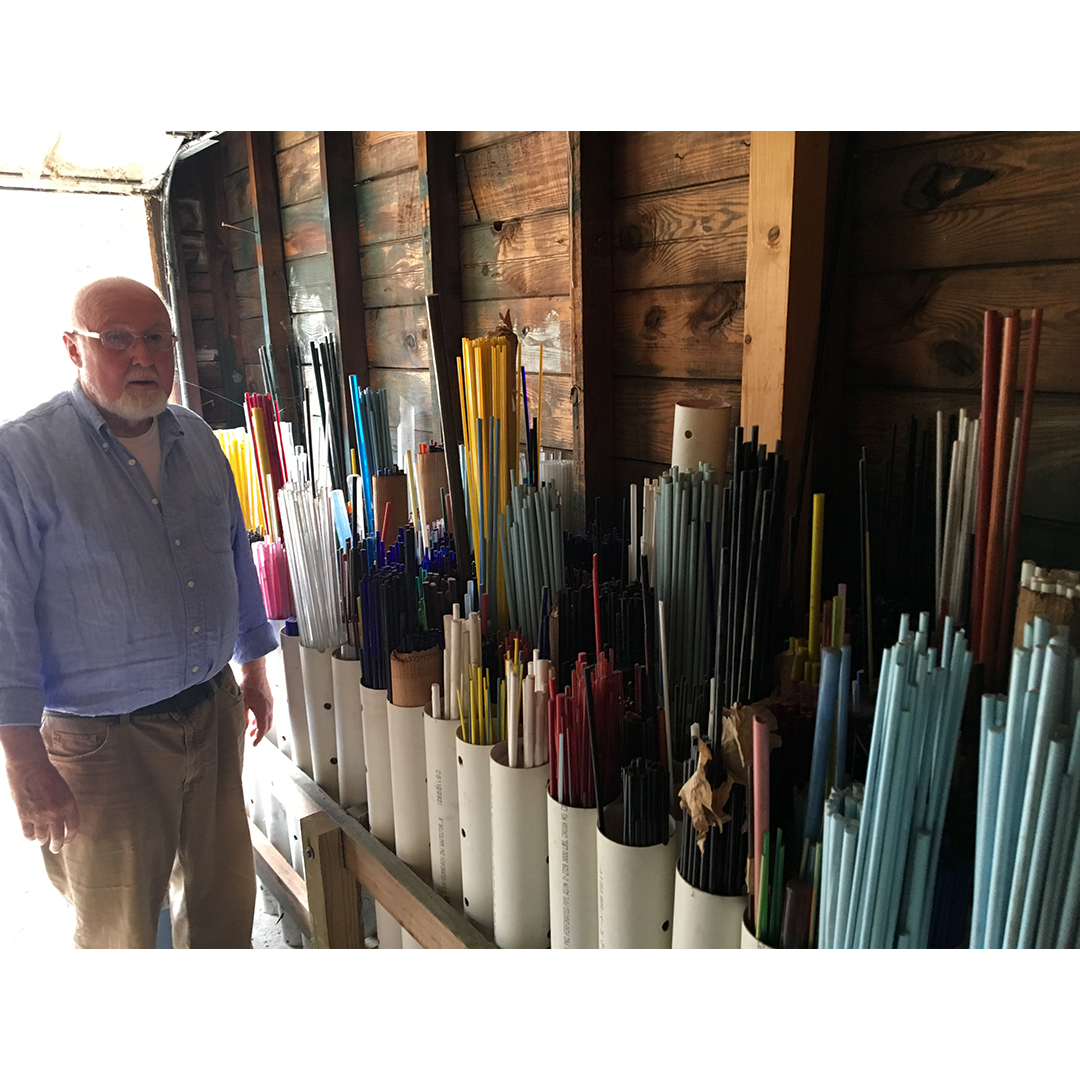
Selecting glass rods
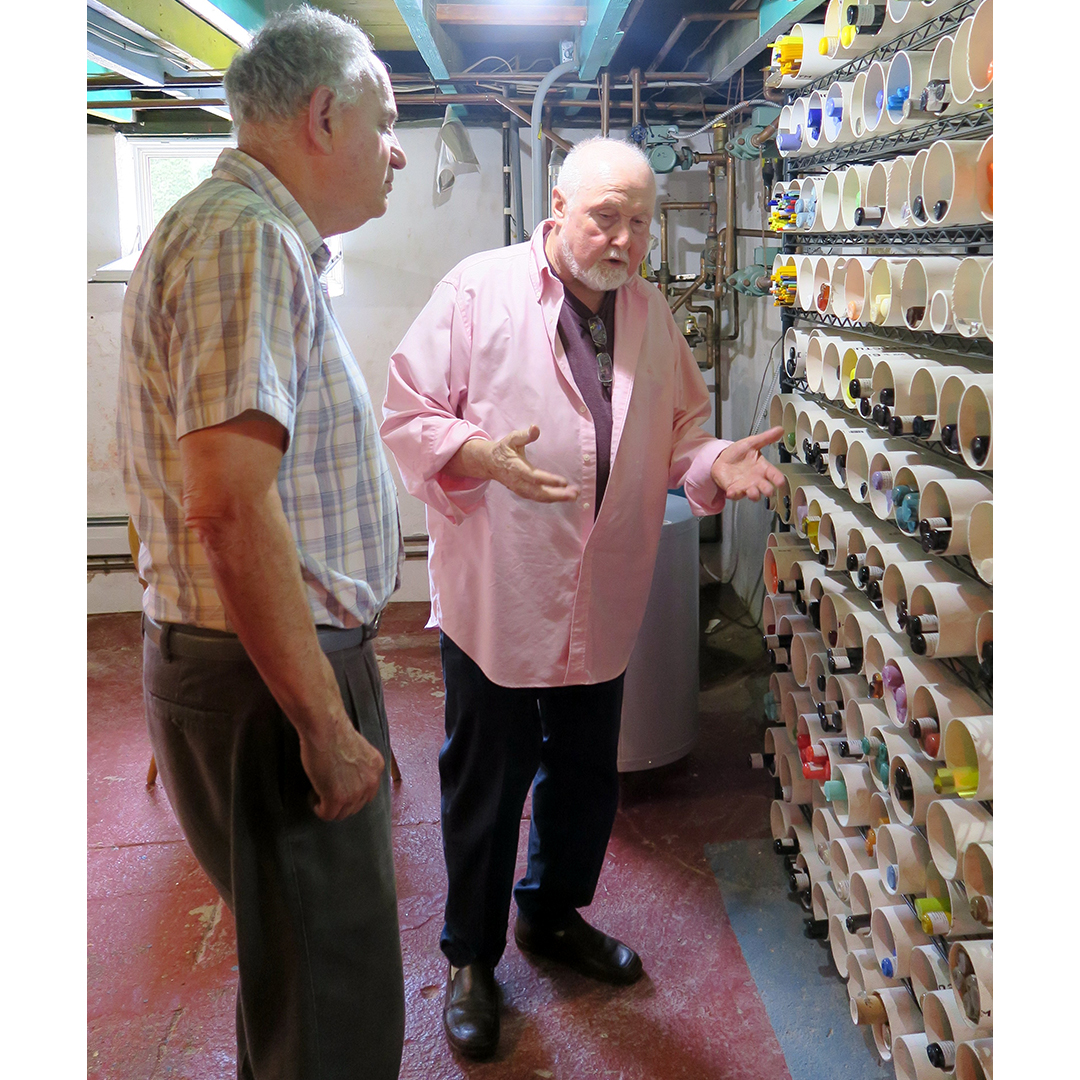
Paul Stankard & Arthur Wiener with glass rods
“I think of my work as referential. These are not literal flowers, though it is important to make them believable. The point of my work is not to make specimens but to evoke the experience of nature.”
Paul J. Stankard
The Art of the Flame
In his New Jersey studio, Paul melts thin rods of colored glass with a flame-worker’s gas-fueled torch. Perfect petals, pistils, stamens and stems are created with the blue flame and arranged with tweezers into complex clusters of blossoms, berries, and roots. Paul encapsulates these visions of nature into molten glass forms, which are cut and polished to form paperweights, orbs, columns and cubes. His tiny glass flowers and insects are executed so perfectly that they almost seem real. However, his miniature works of art are often fantasies, integrating his interest in botanical realism with spiritual mysticism and the cycle of life.
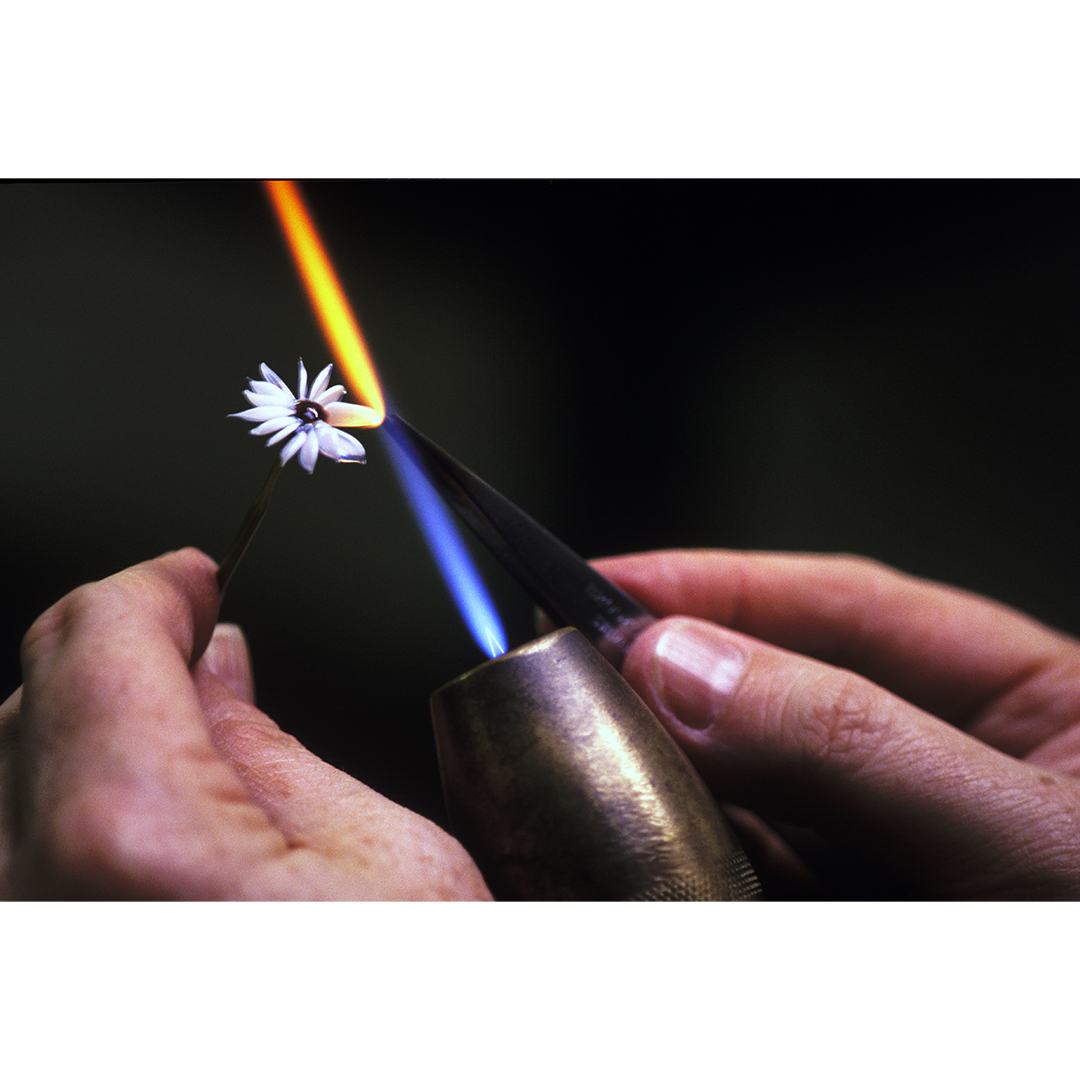
Flameworking a flower
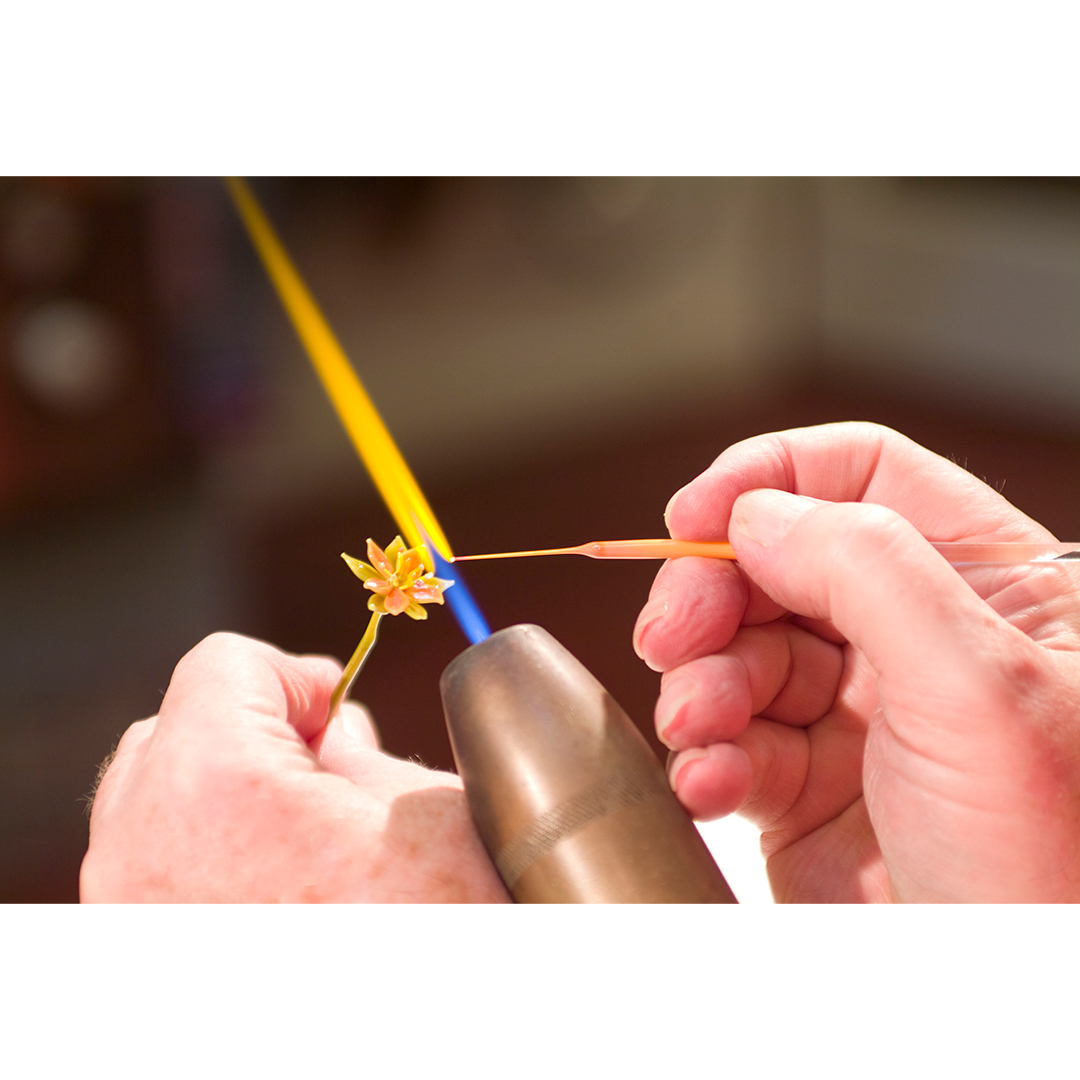
Flameworking a flower
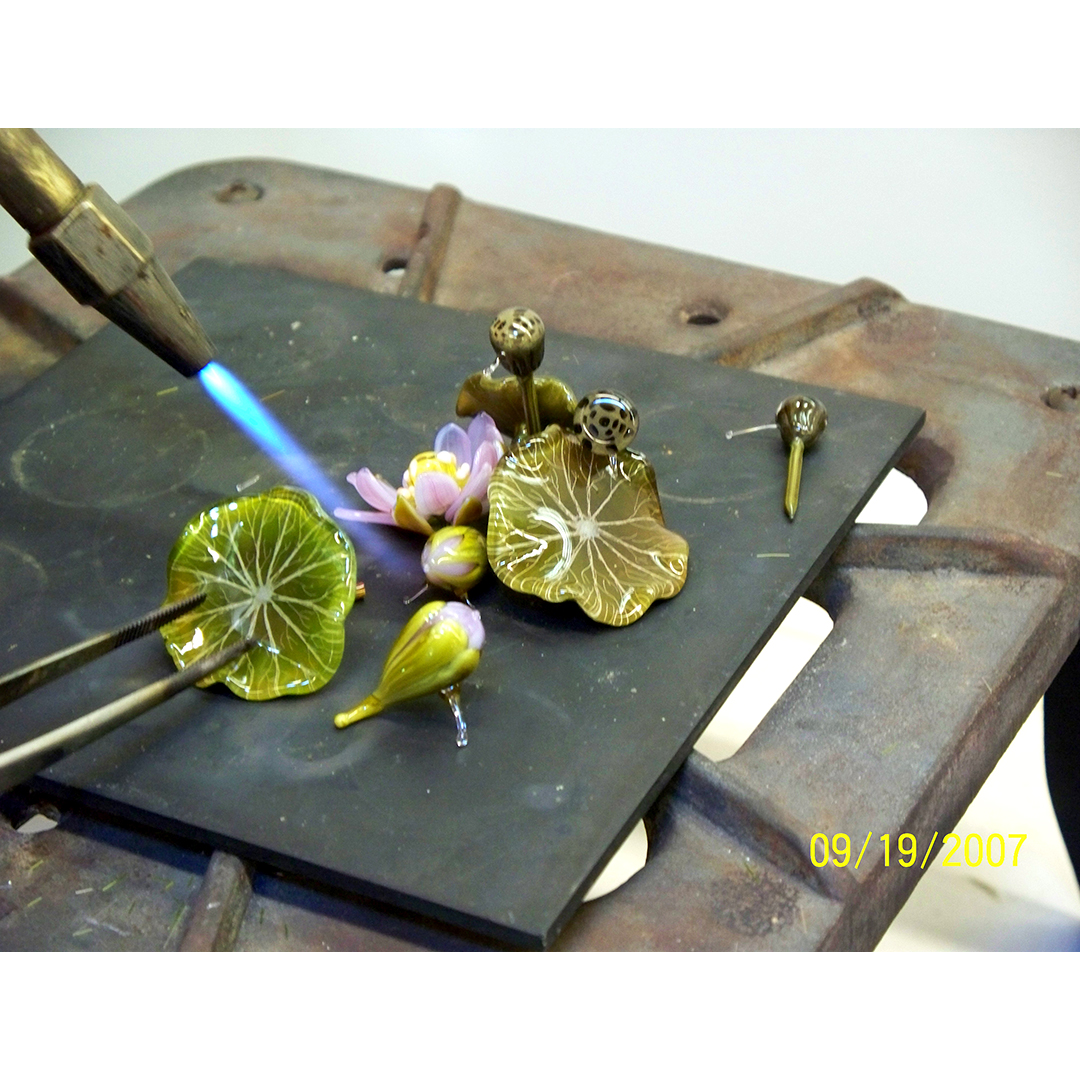
Assembling floral cluster
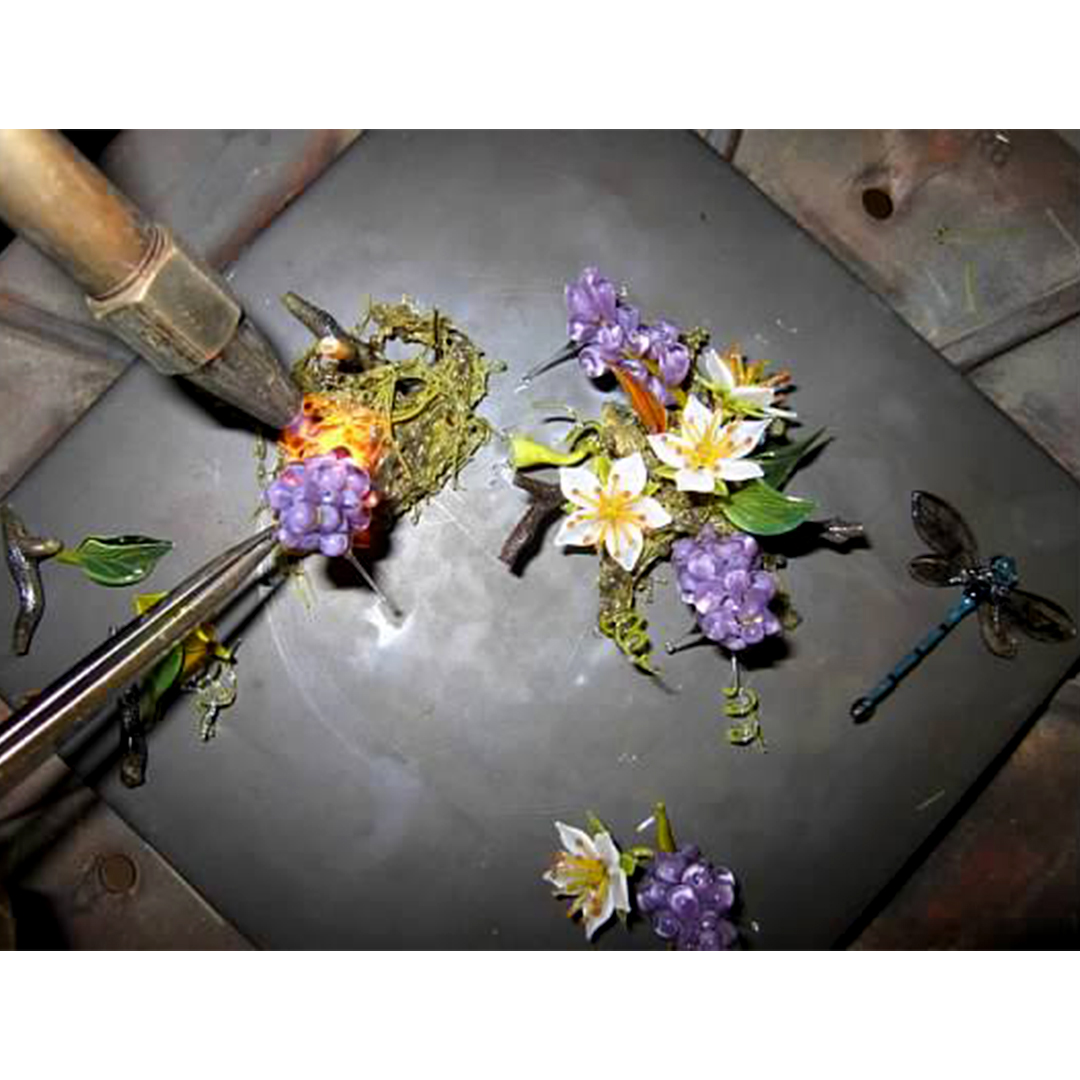
Melting on a hot plate
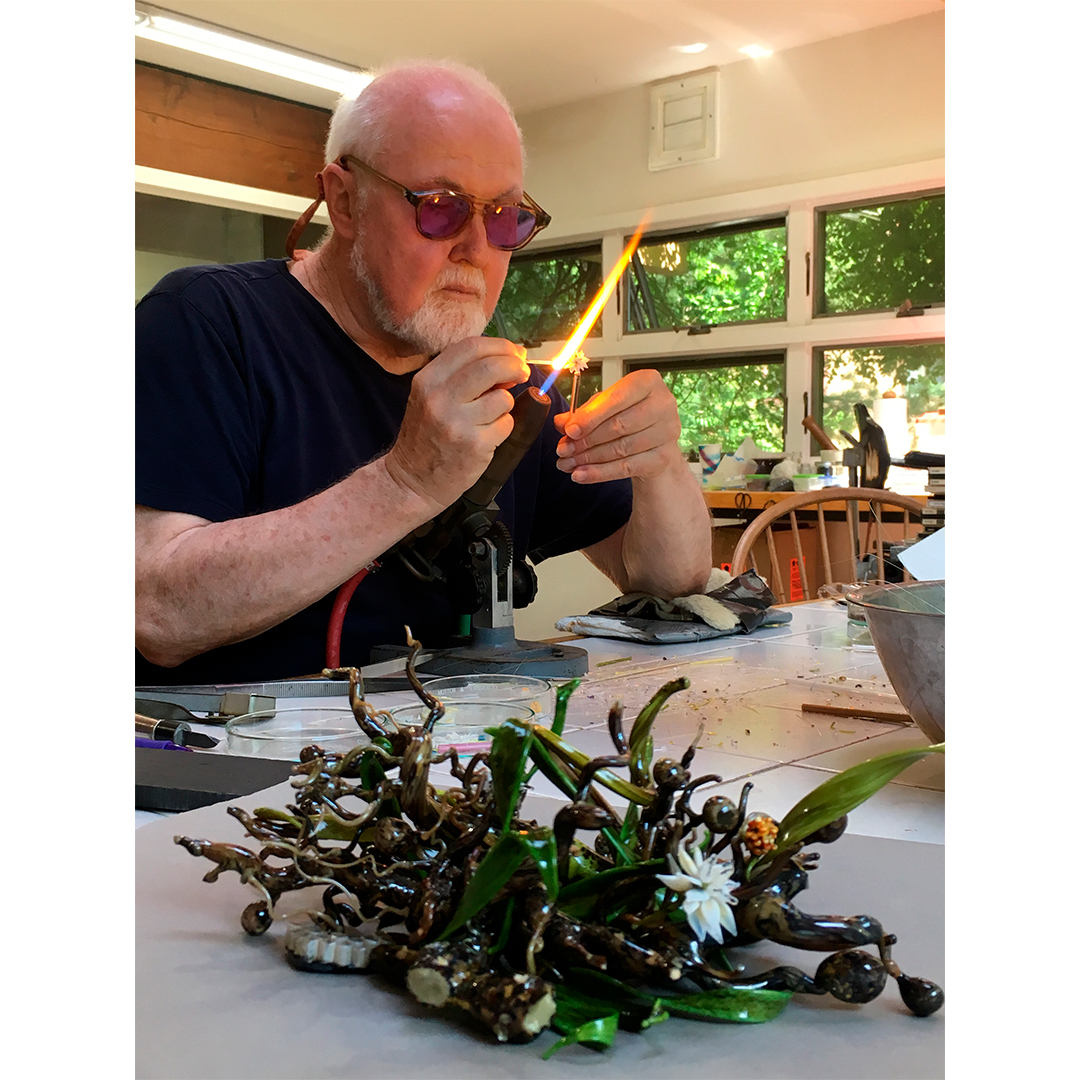
Paul at Work
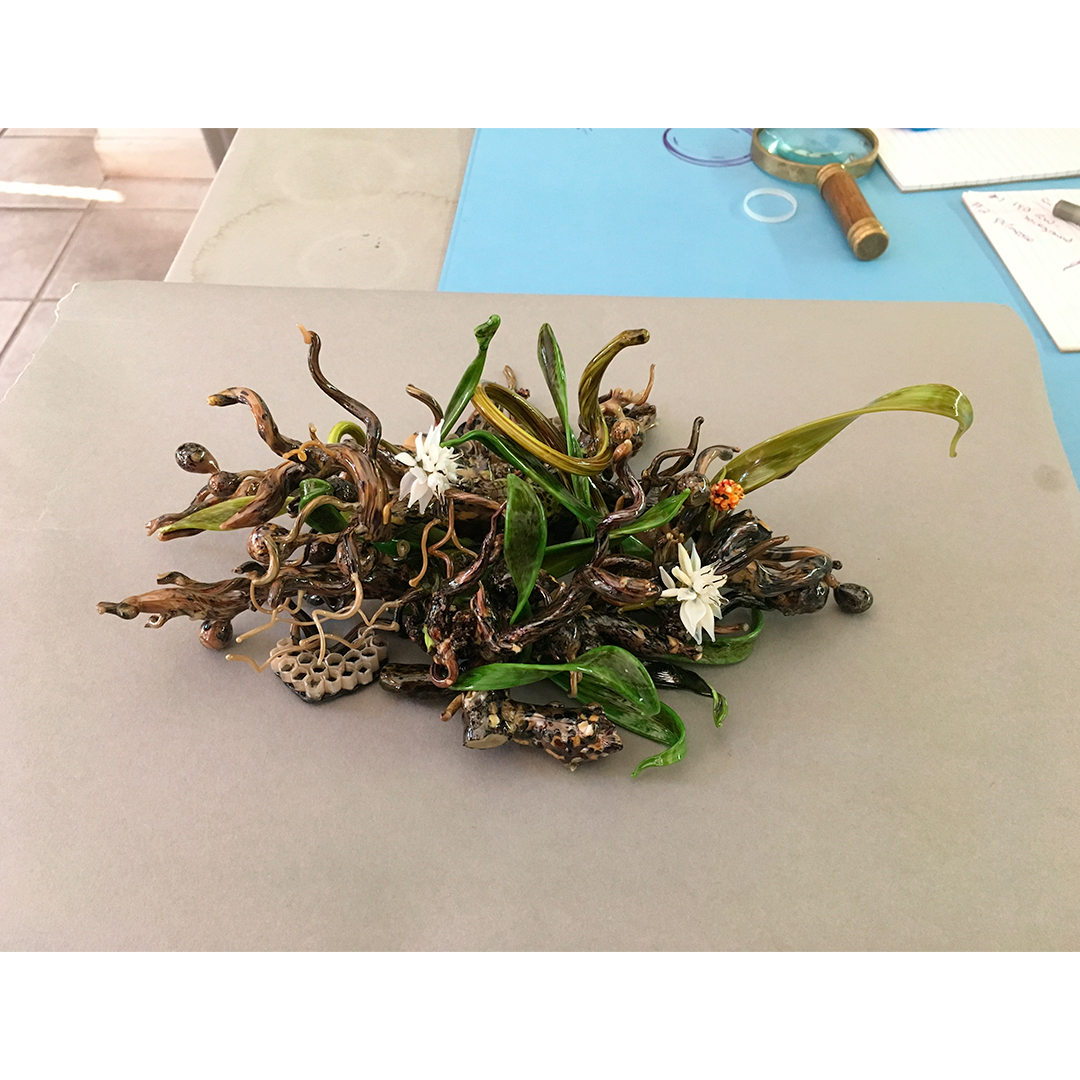
Cluster to be encapsulated
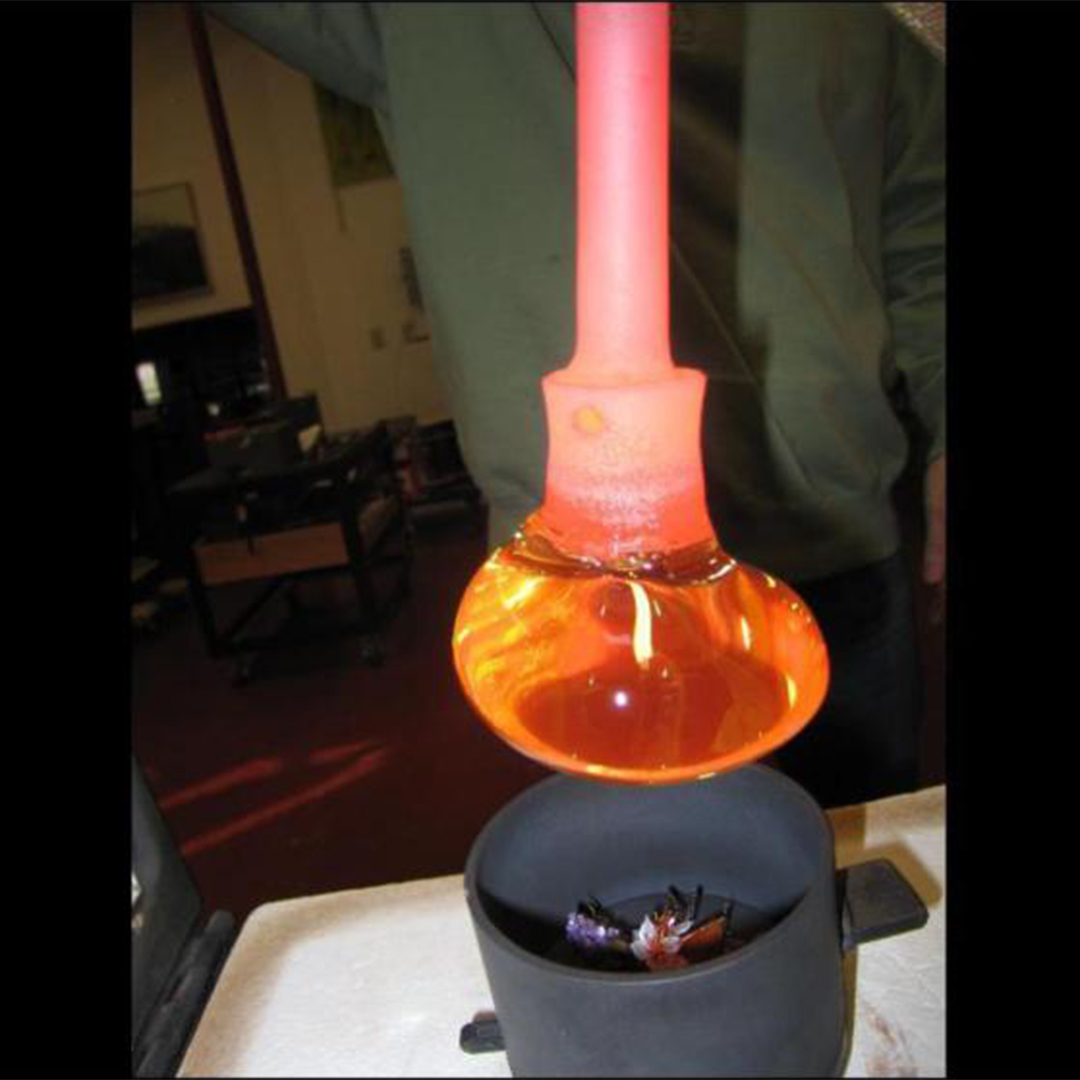
Making a paperweight
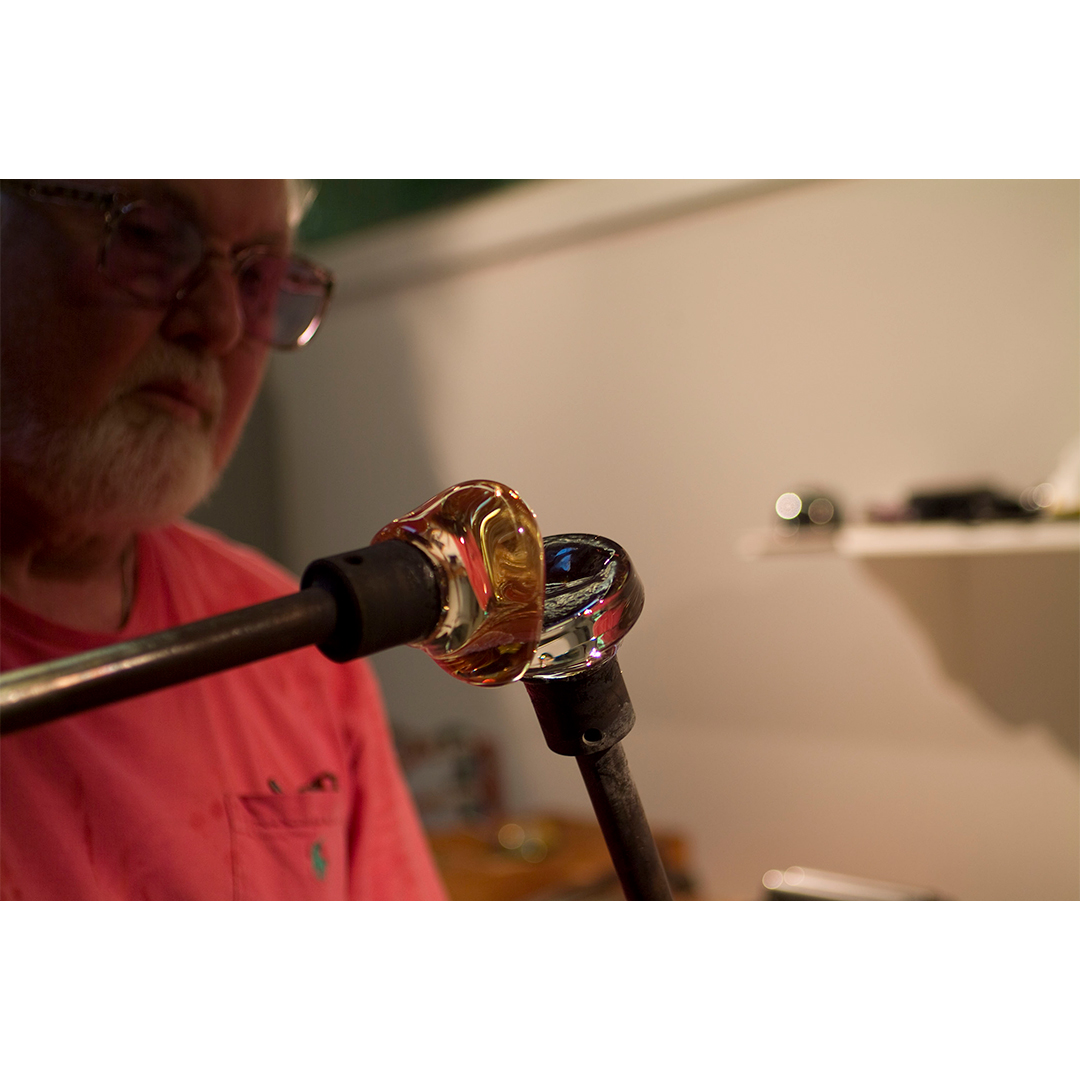
Making a paperweight
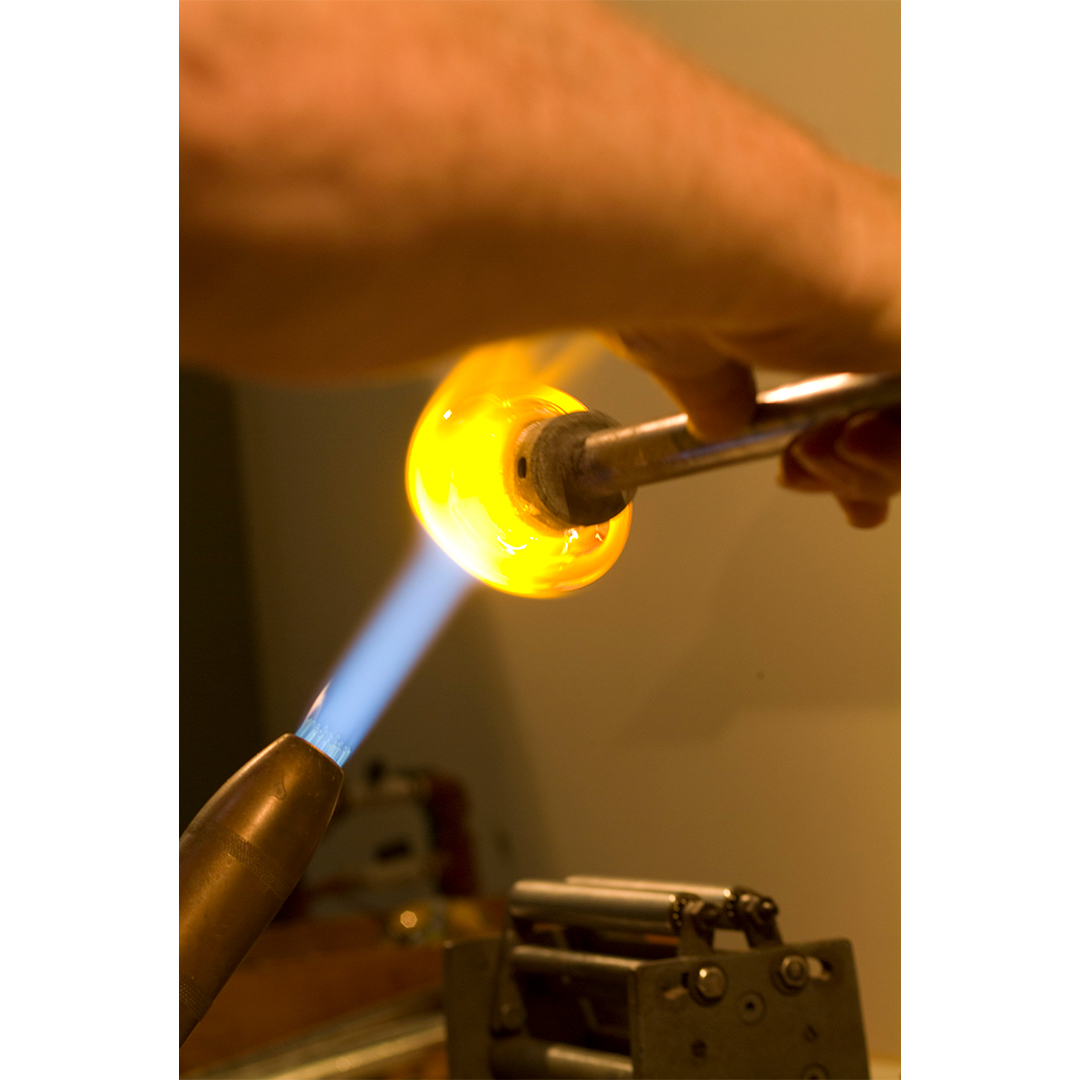
Making a paperweight
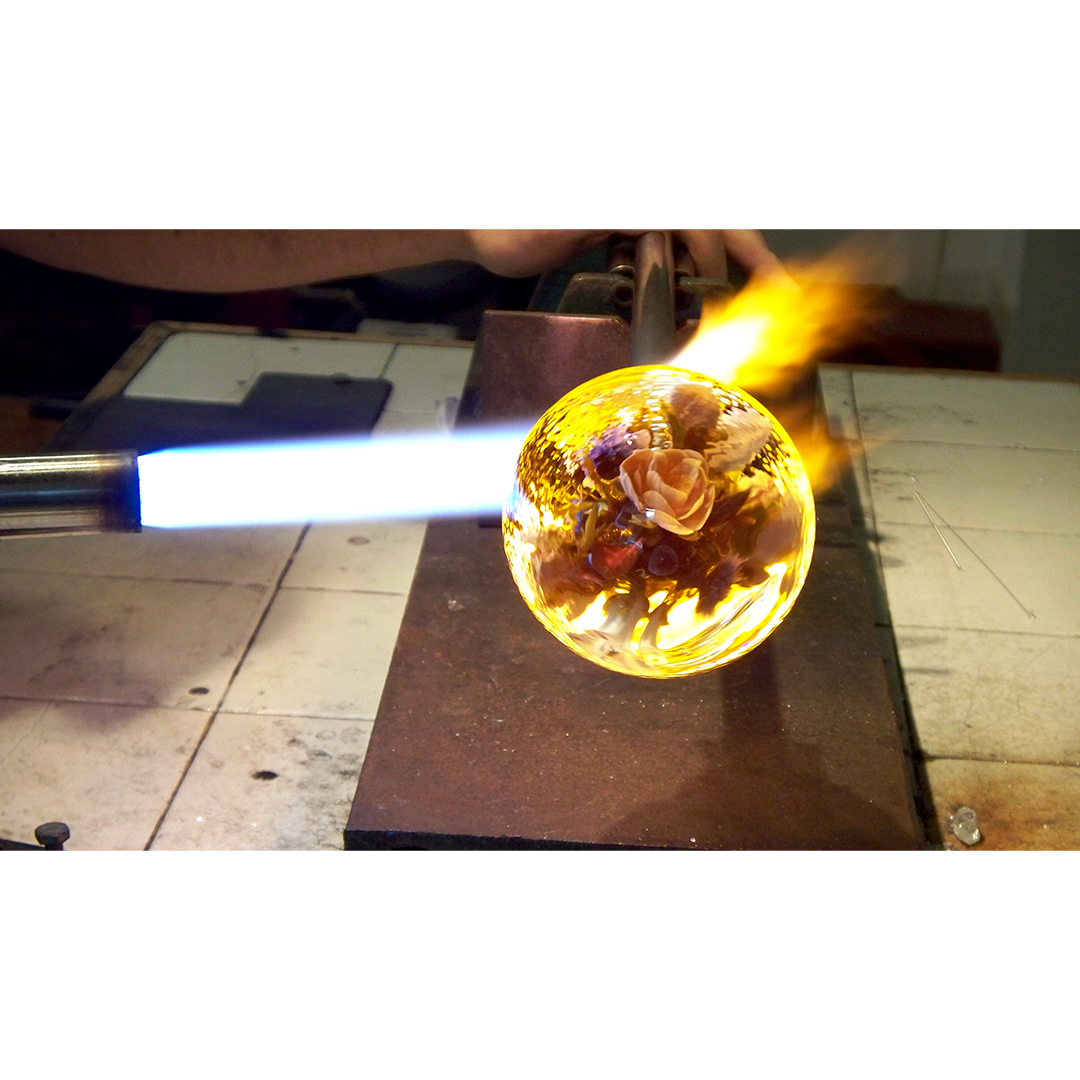
Creating an Orb
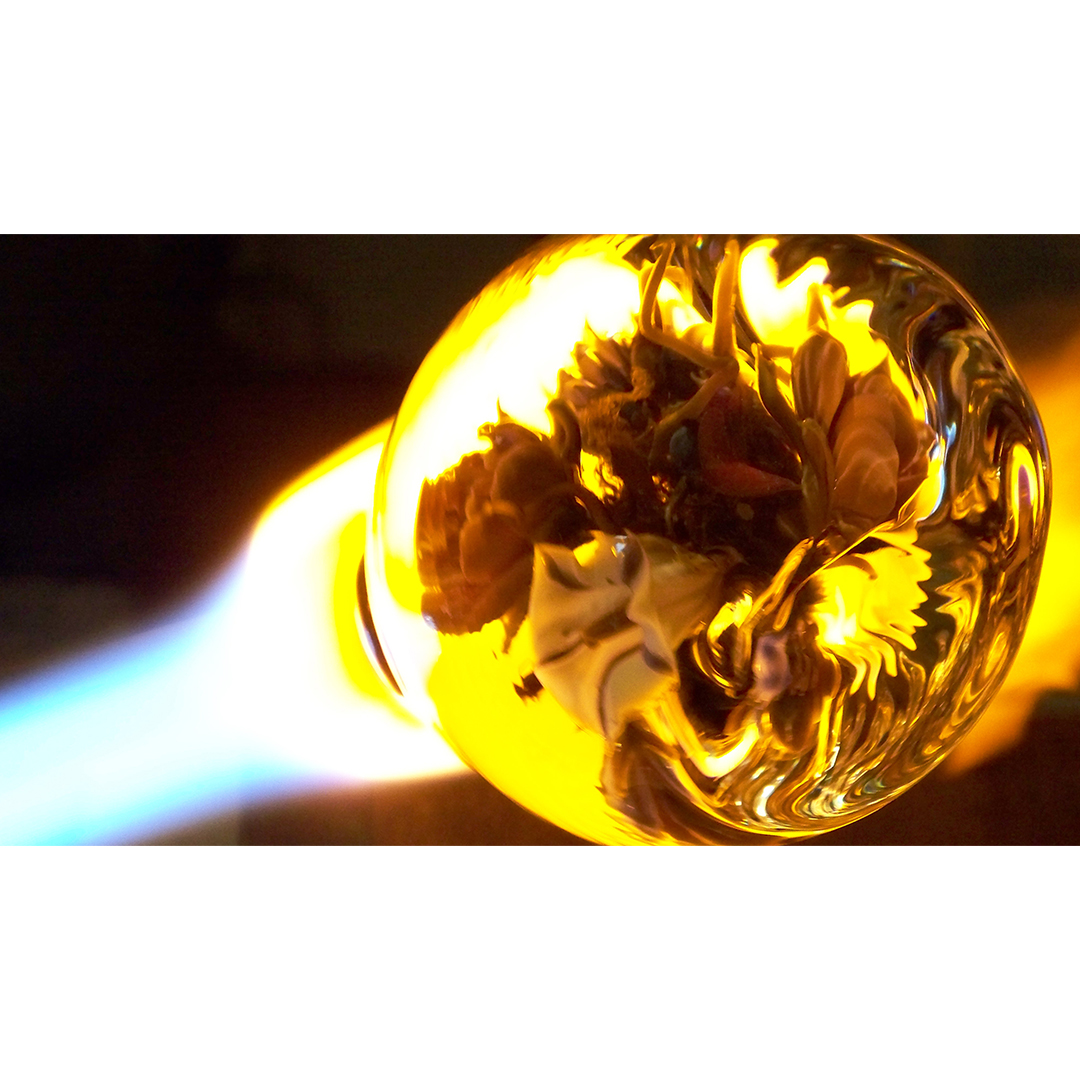
Refining an Orb
“I marvel at what you can see, standing in the woods, being completely quiet, observing. I find a spiritual sense of timelessness.”
Paul J. Stankard
Fragment of a Dream
Paul was born in rural Massachusetts in 1943 and he has many fond memories of childhood rambles in the countryside. In 1958, the family moved to New Jersey where Paul struggled at school as an undiagnosed dyslexic. However, he found his vocation at Salem Technical Institute when he enrolled to study scientific glass making. Graduating in 1963, he began making glass apparatus for laboratory research. As Paul honed his skills in the industry, he became interested in South Jersey’s glassmaking tradition, particularly floral paperweights, such as the Millville Rose, which artisans crafted in their spare time. Glass paperweights had fascinated Paul since childhood as the tiny worlds encapsulated in glass stimulated his imagination. “A paperweight is like some fragment of a dream.” Truman Capote
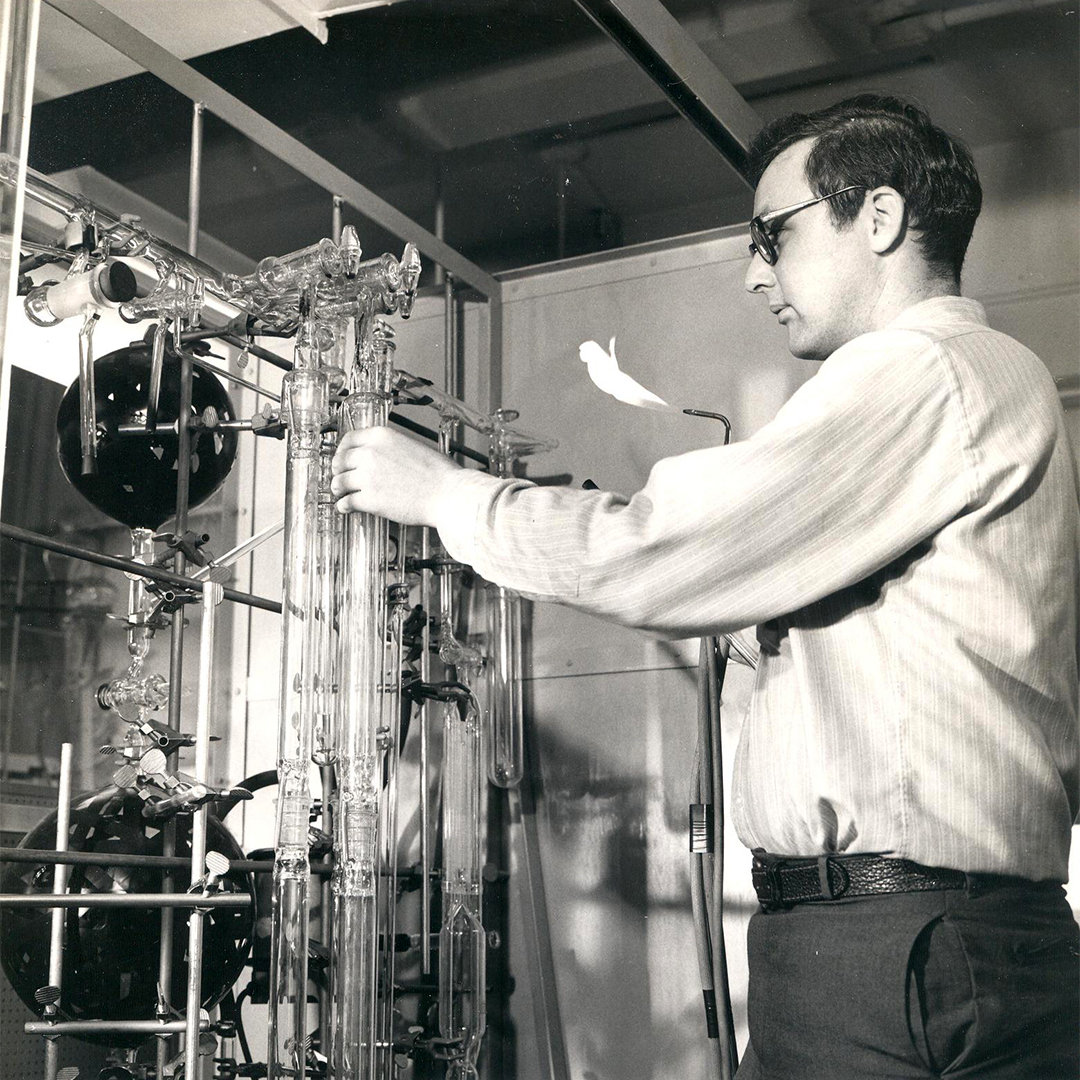
Paul Stankard making scientific glass

Paul Stankard making scientific glass
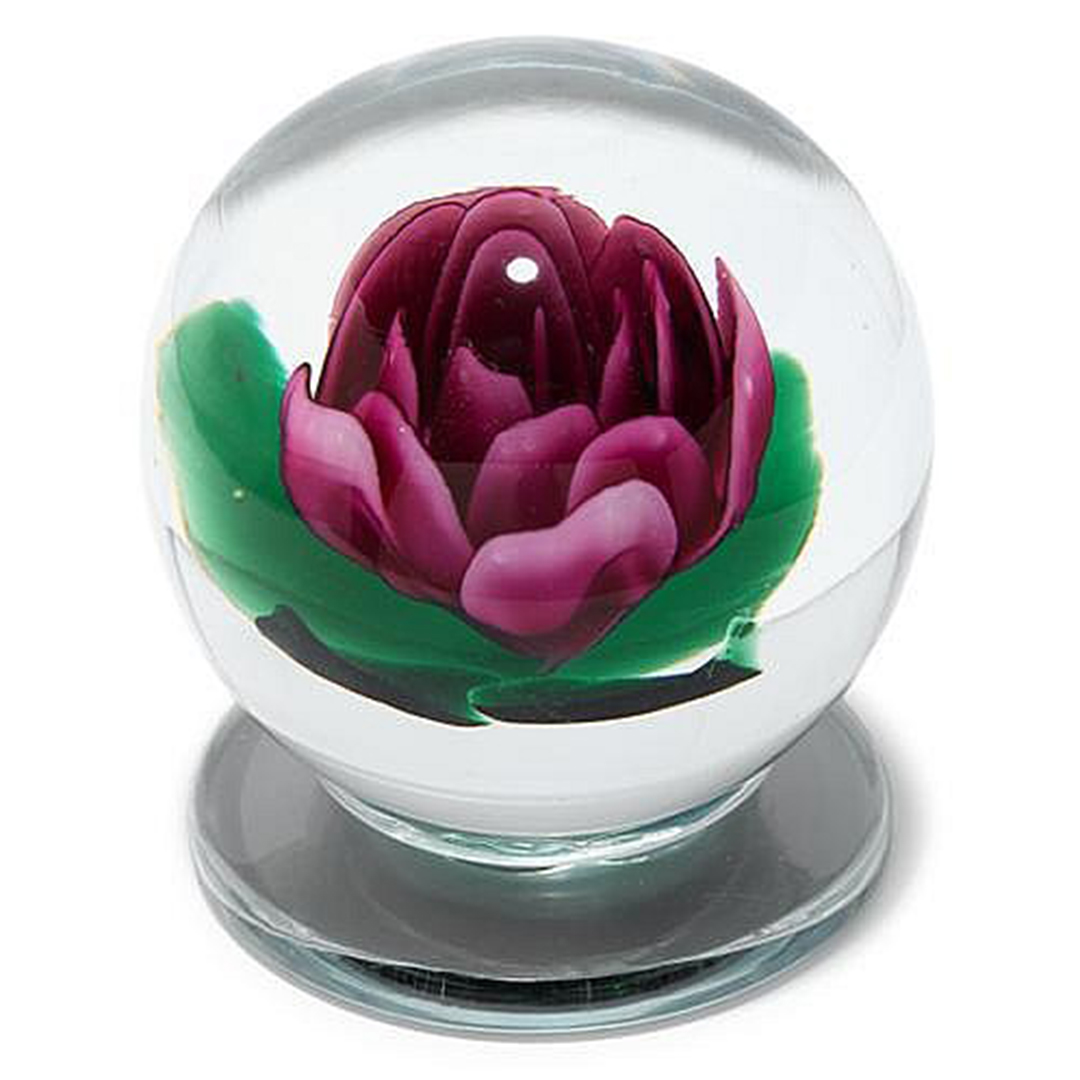
A Millville paperweight
"I began studying antique French paperweights to determine how to build on that tradition, closely observing the details of native flowers to interpret them in glass and listening to great works from the Western canon on audiotapes."
Paul J. Stankard
A Passion for Paperweights
In 1969, Paul set up a studio at home and began using his precision glass making skills to produce paperweights. He focused initially on animal subjects before capturing his observations of native flora in glass. He studied the mid-19th century masters in France, such as Baccarat, Saint Louis and Clichy, and determined to rival them. His early work was discovered at a board-walk craft show in Atlantic City by Reese Palley, self-proclaimed “Merchant to the Rich” who sold Boehm porcelain and other objets d’art. Thanks to Palley’s gallery exhibitions, mentorship and financial support, Paul was able to devote himself to creating glass art. Encouraged also by his wife, Pat, he left his industry job in 1972.
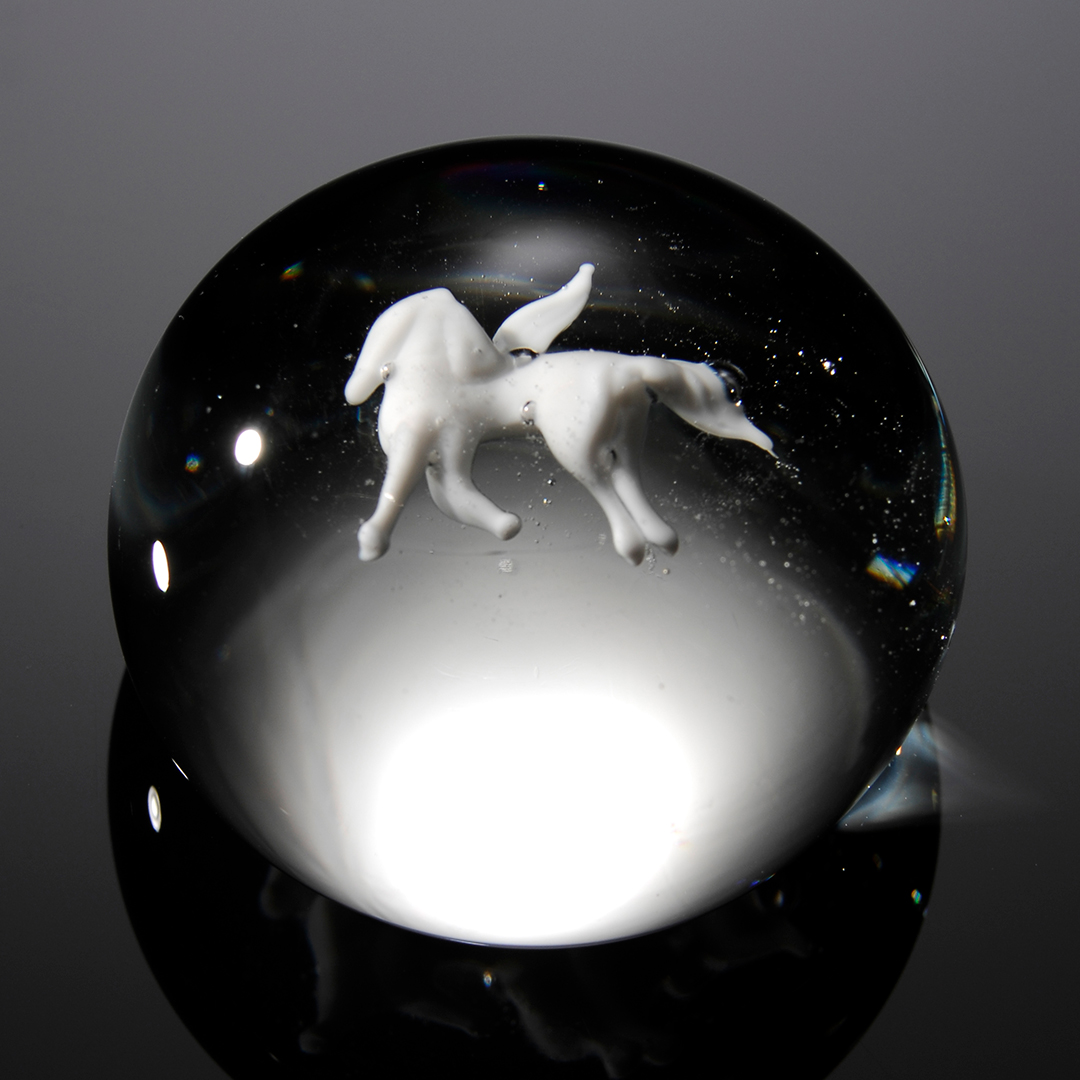
Pegasus paperweight
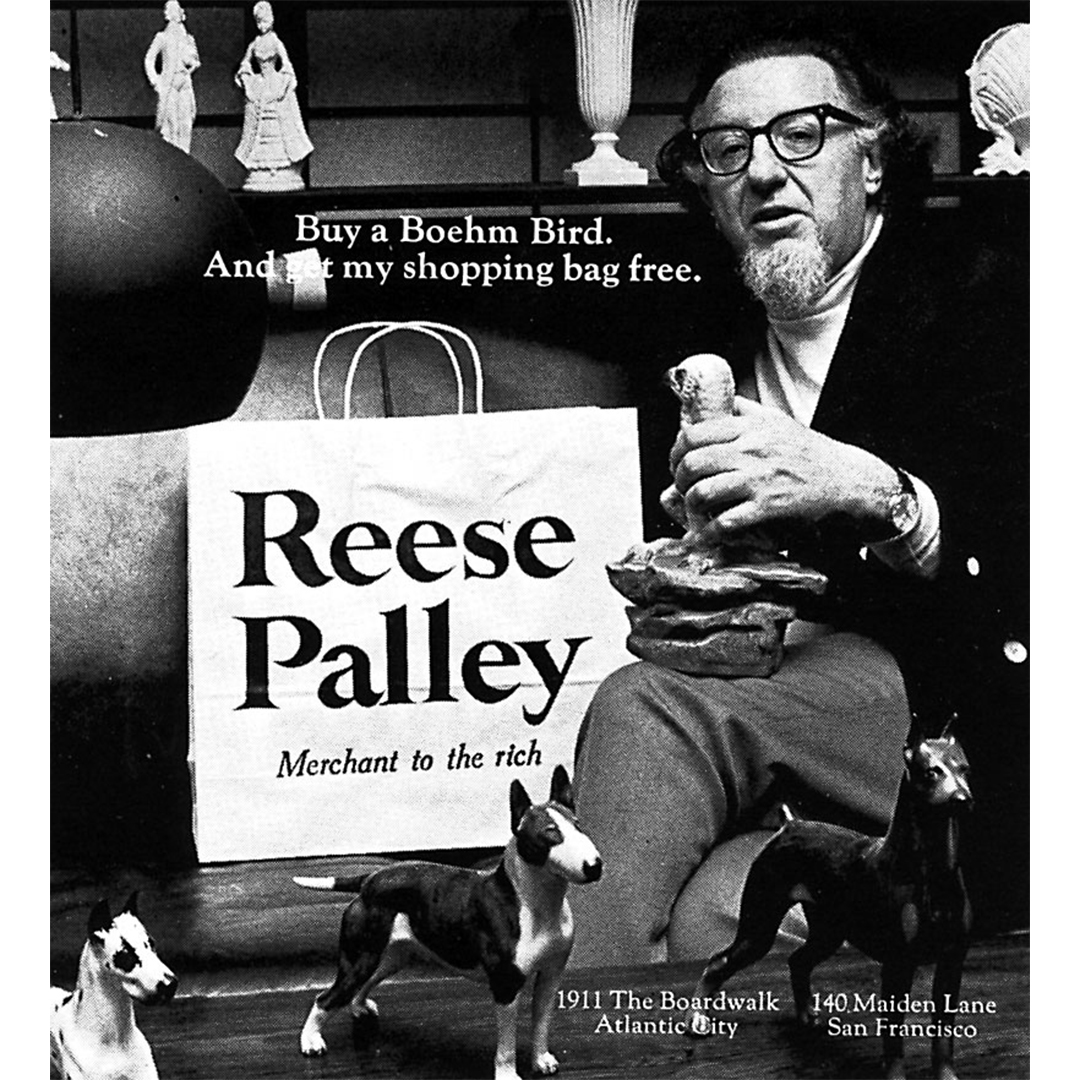
Reese Palley “Merchant to the Rich”
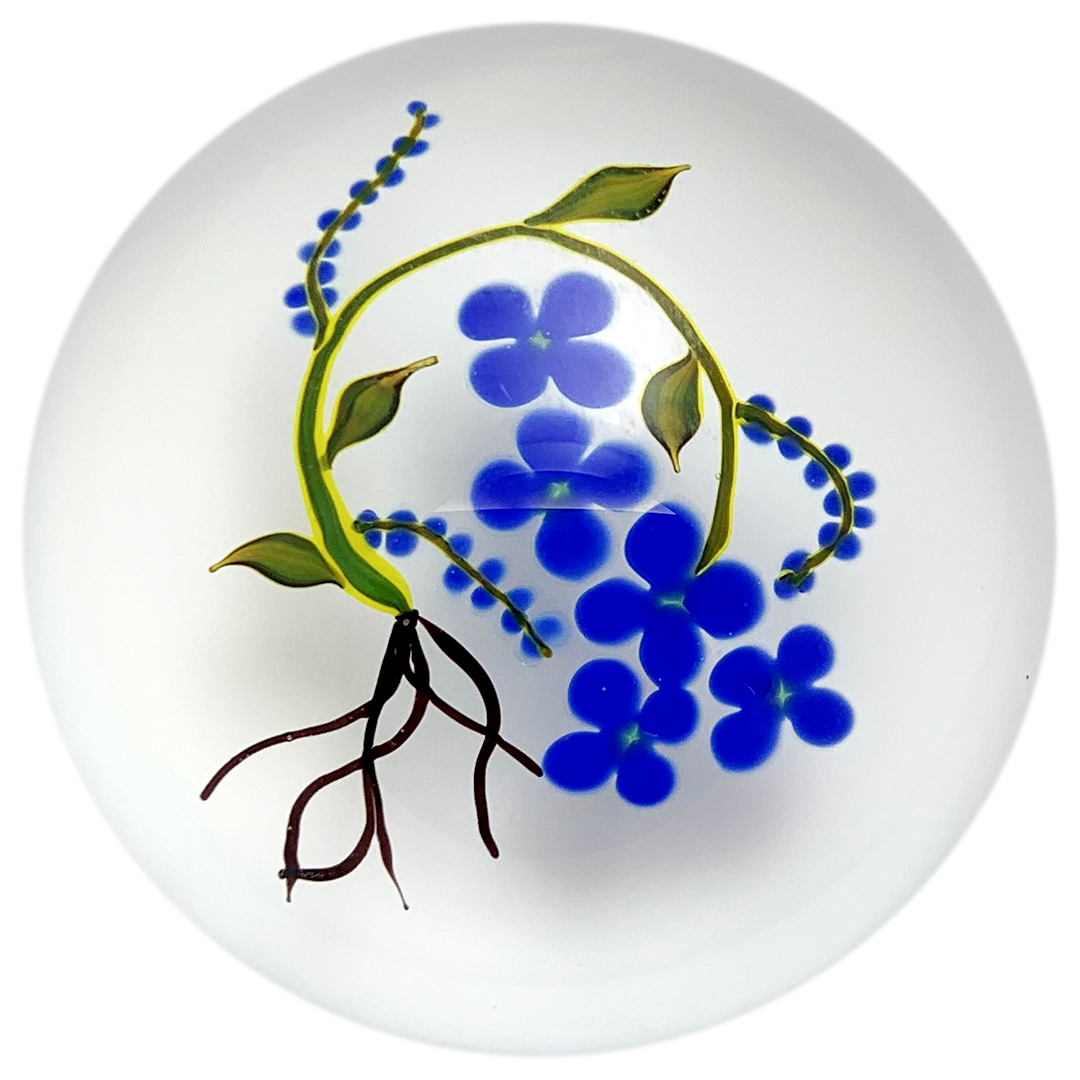
Forget-Me-Nots paperweight
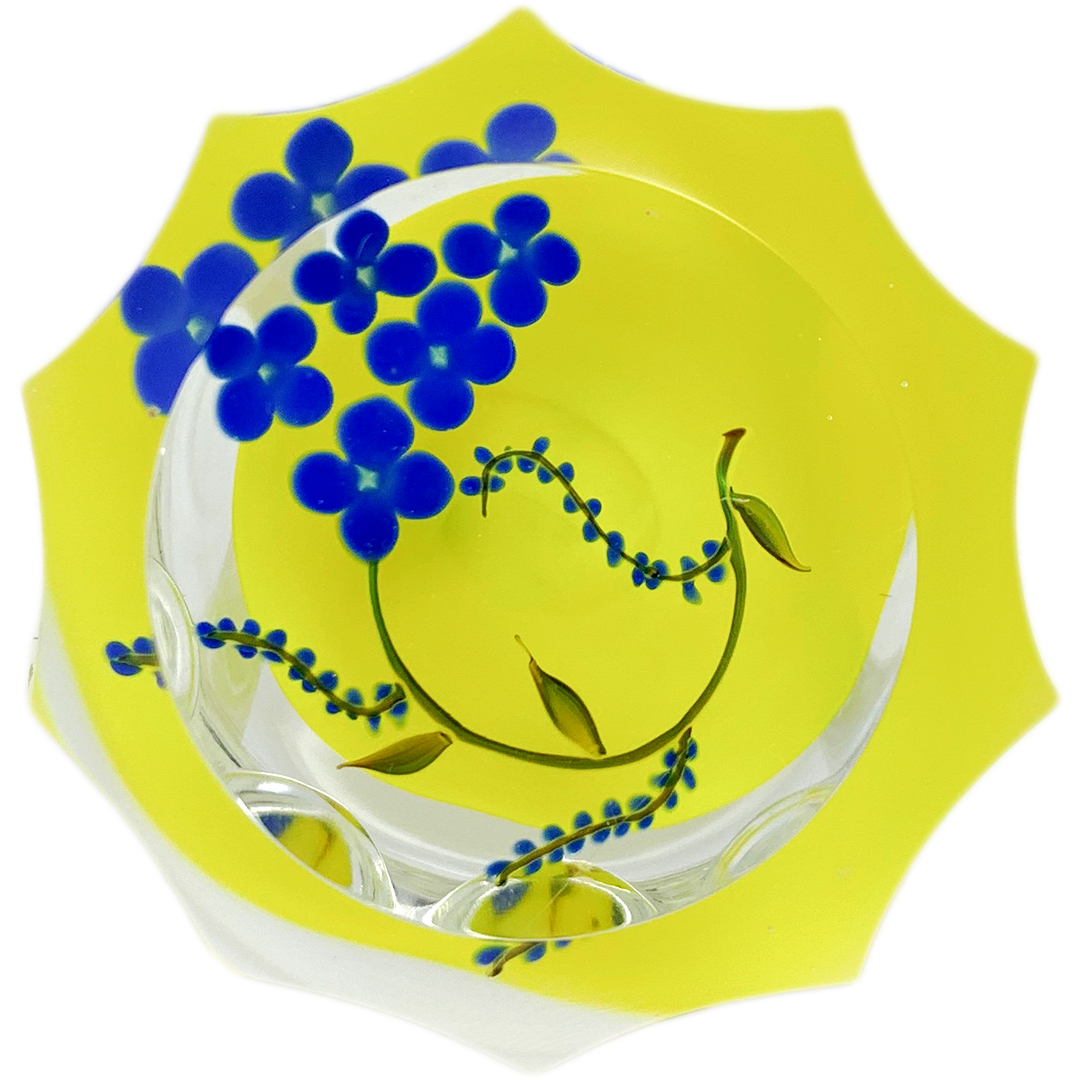
Forget-me-Nots faceted paperweight
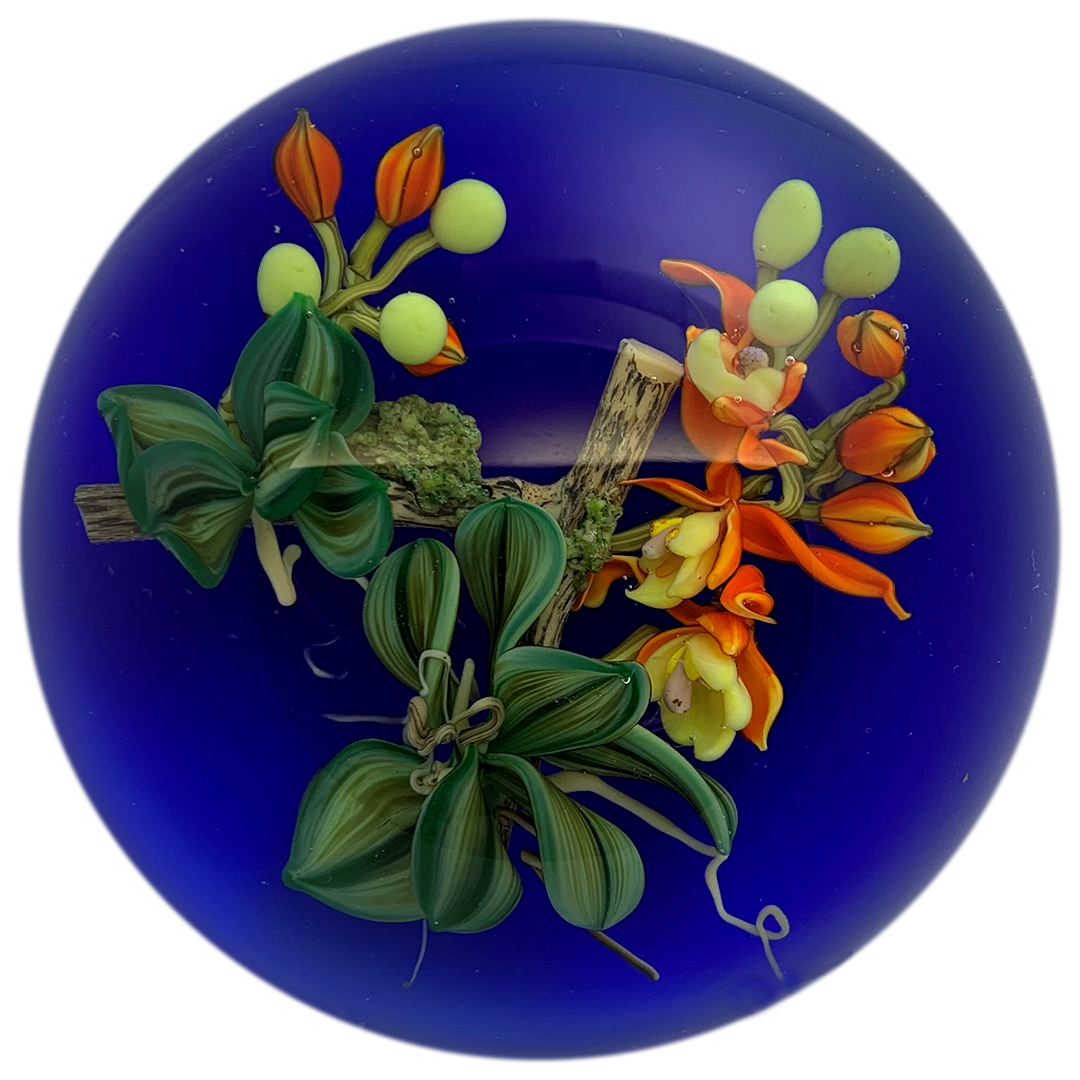
Orchid paperweight
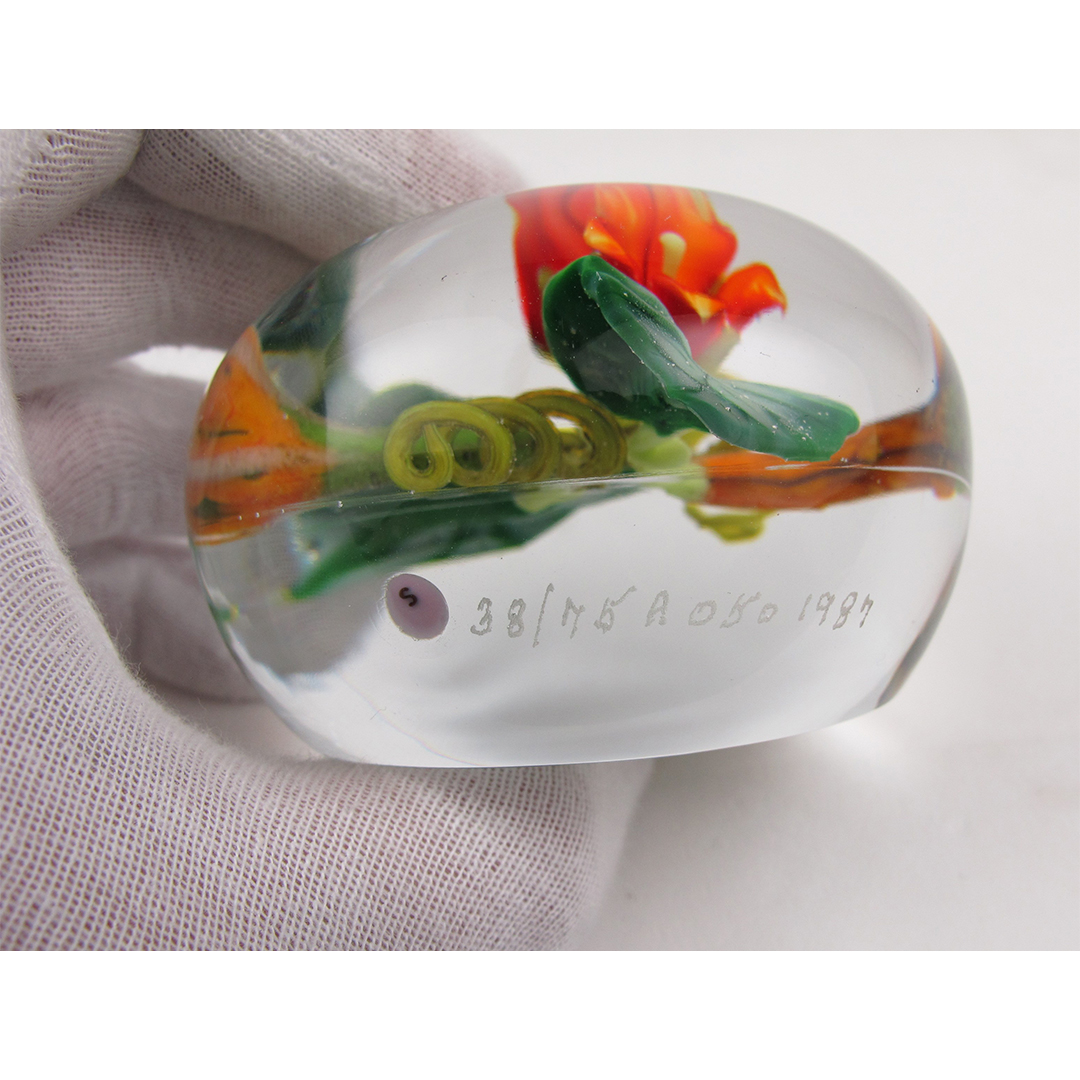
Limited edition paperweight details
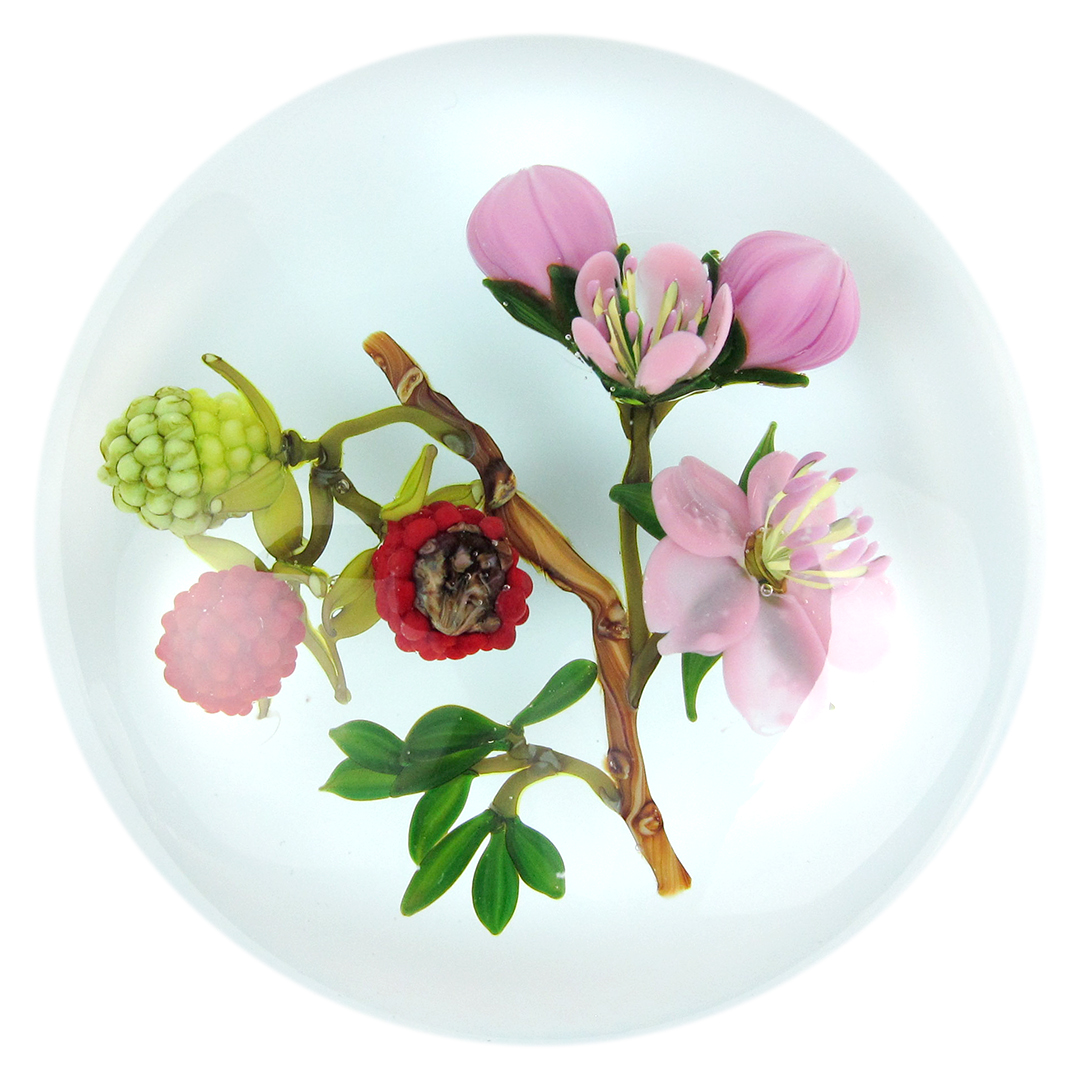
Flowers and berries paperweight
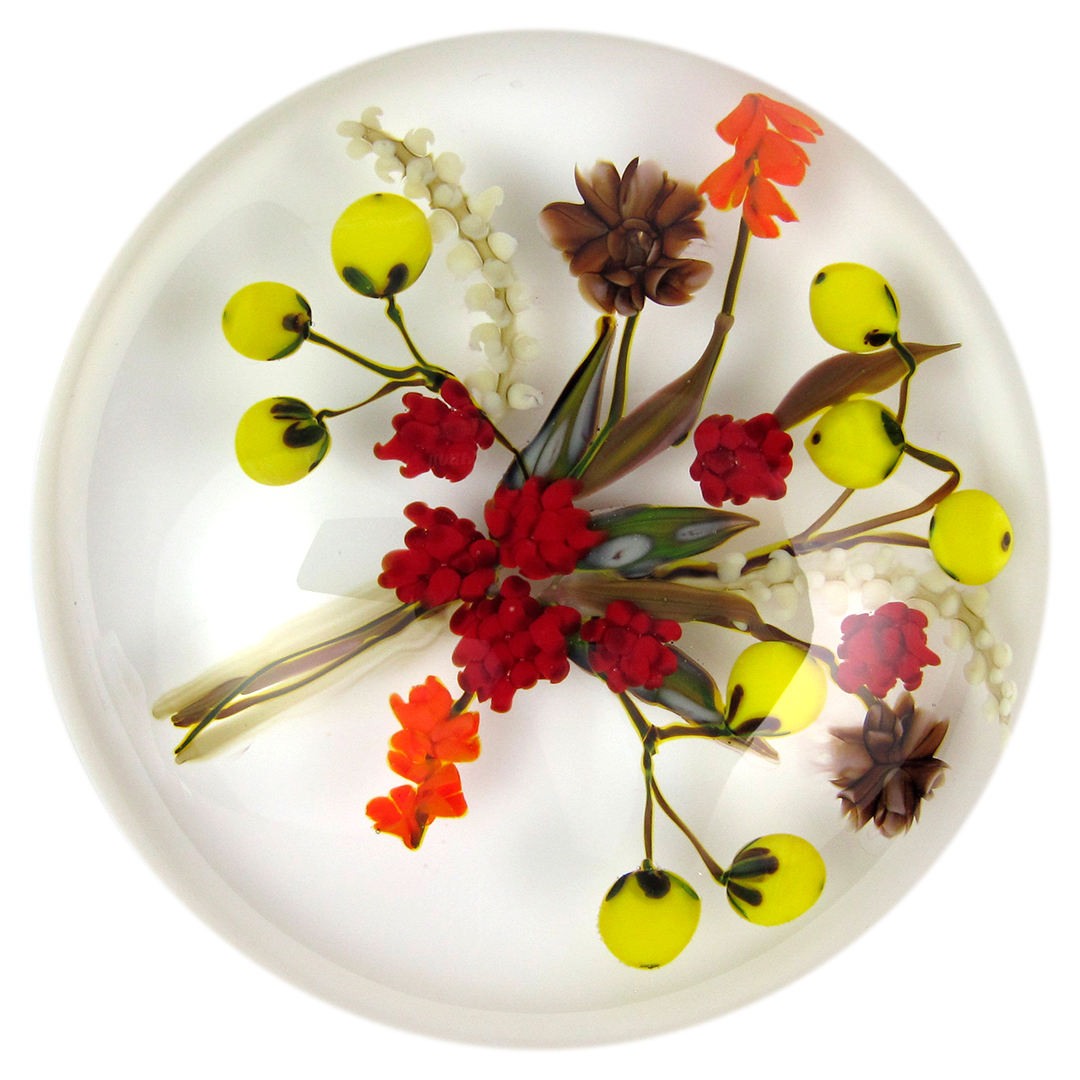
Flowers and berries paperweight
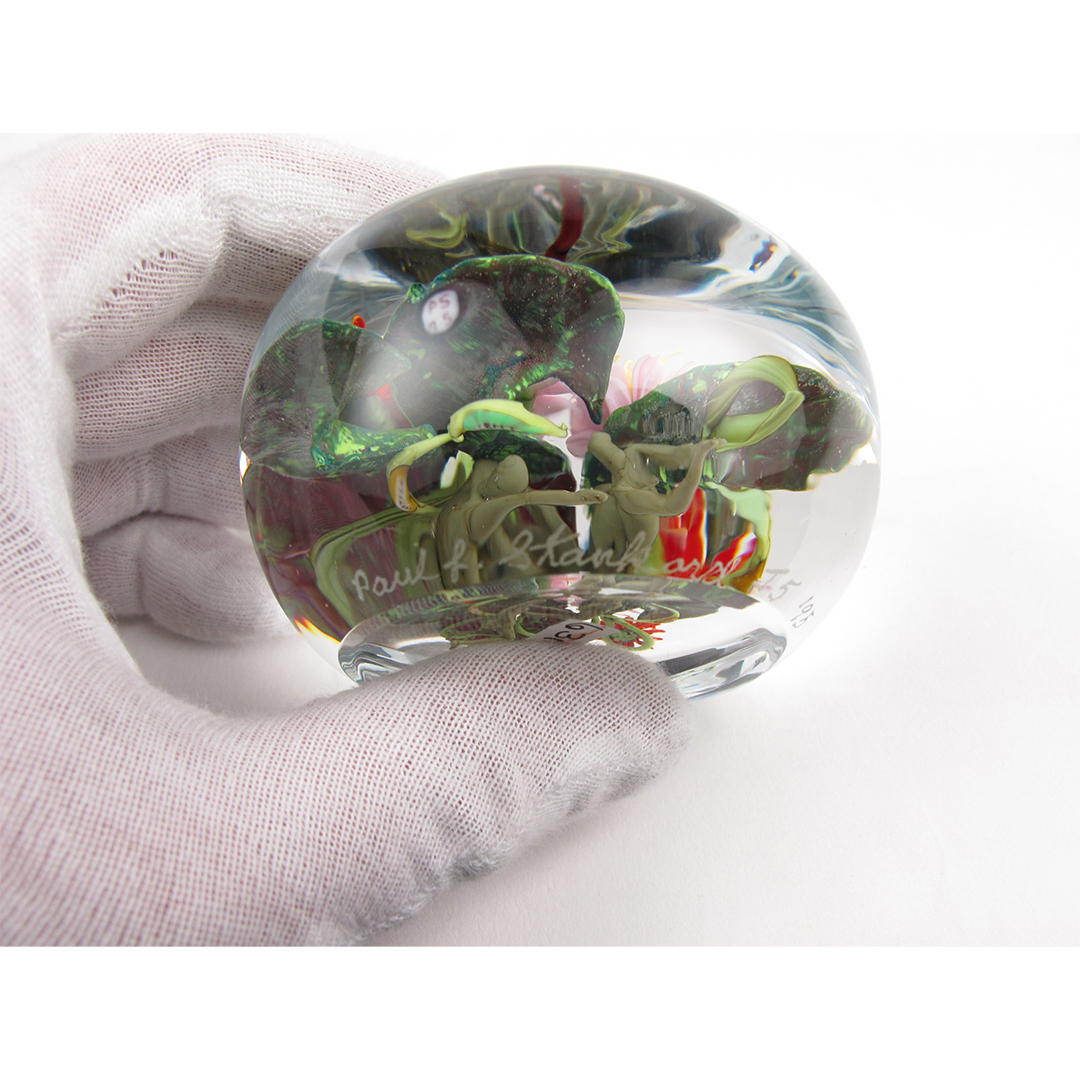
Paul Stankard engraved signature and signature cane
“If my work poses questions for the viewer, I feel it is successful. That’s what art is all about. I would like my work to be ambiguous. It’s not about being botanically accurate.”
Paul J. Stankard
Father of Modern Paperweights
Collectors of antique paperweights began to acquire Paul’s work and he was commissioned to produce limited edition designs from the Smithsonian Institution and the Art Institute of Chicago. Although each design edition represented a specific flower, every paperweight was different as Paul would not confine himself to a static arrangement. As paperweight societies, publications and exhibitions flourished during the 1970s and 80s, Paul was acclaimed the “father of modern paperweights.” In the 1990s, Paul developed his Environmental paperweights which are divided in two by a plane of sand. All is not what it appears to be on the surface. Flowers blossom above the ground while below complex anthropomorphic roots and earth spirits teem with fertility.
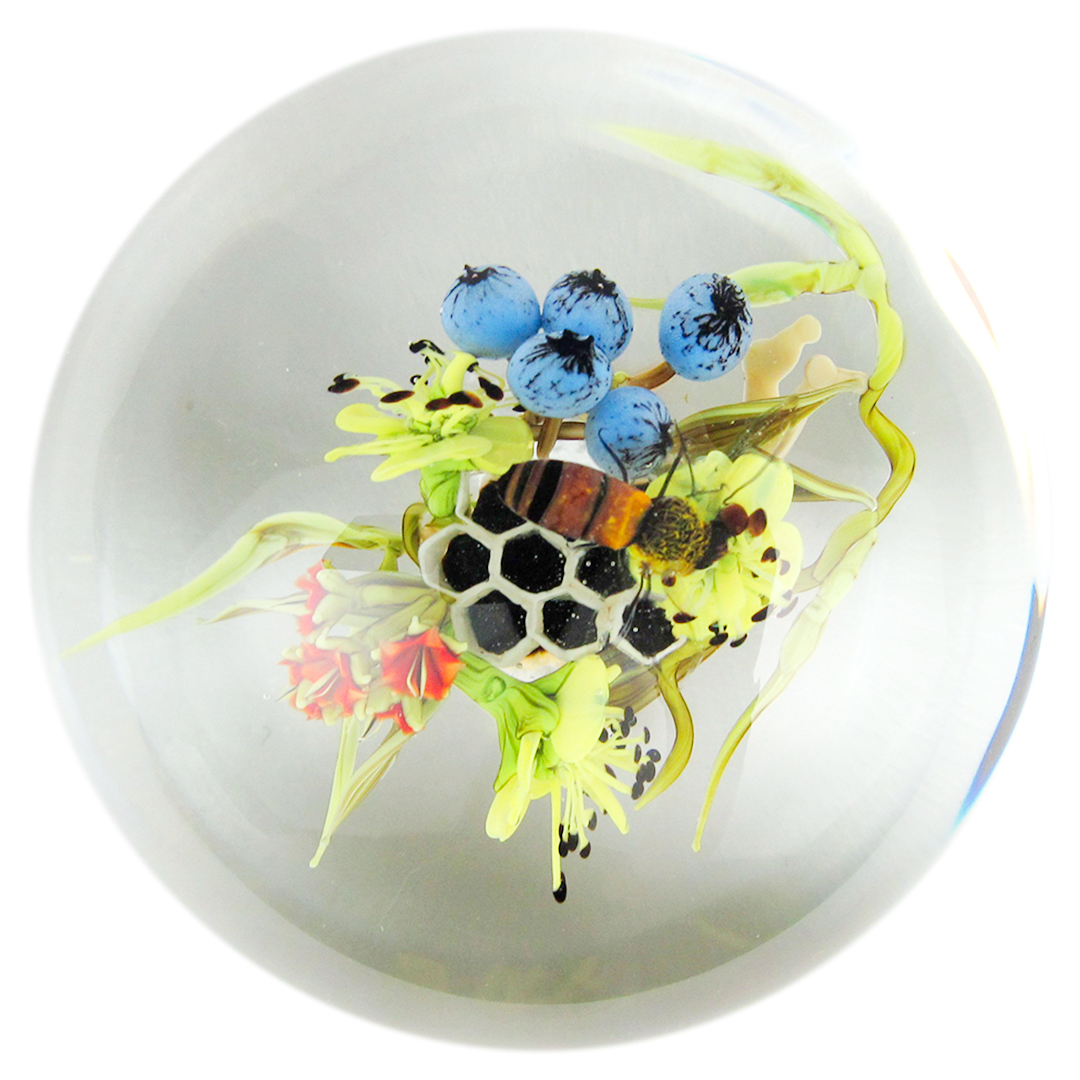
Berries & honeycomb paperweight
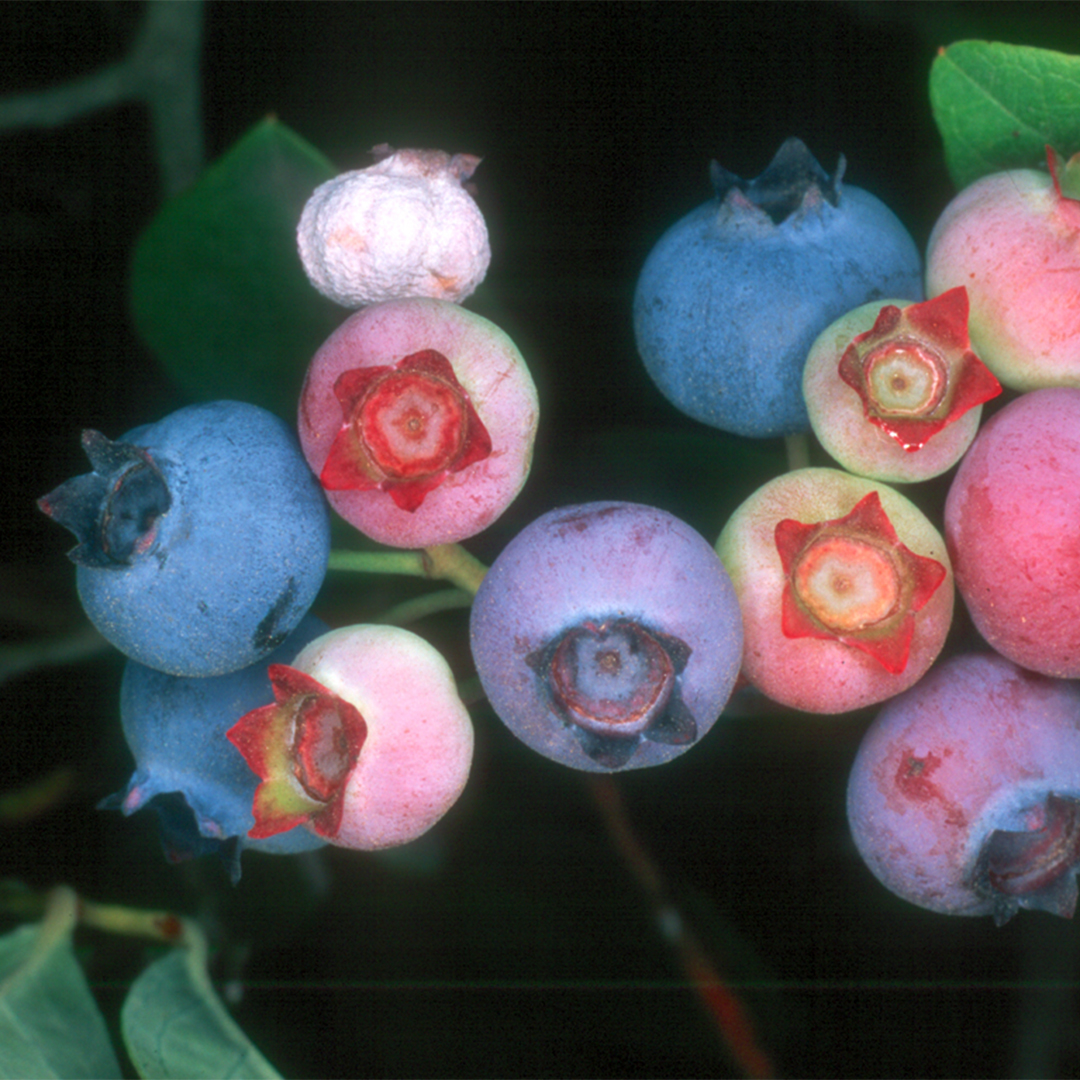
Berries
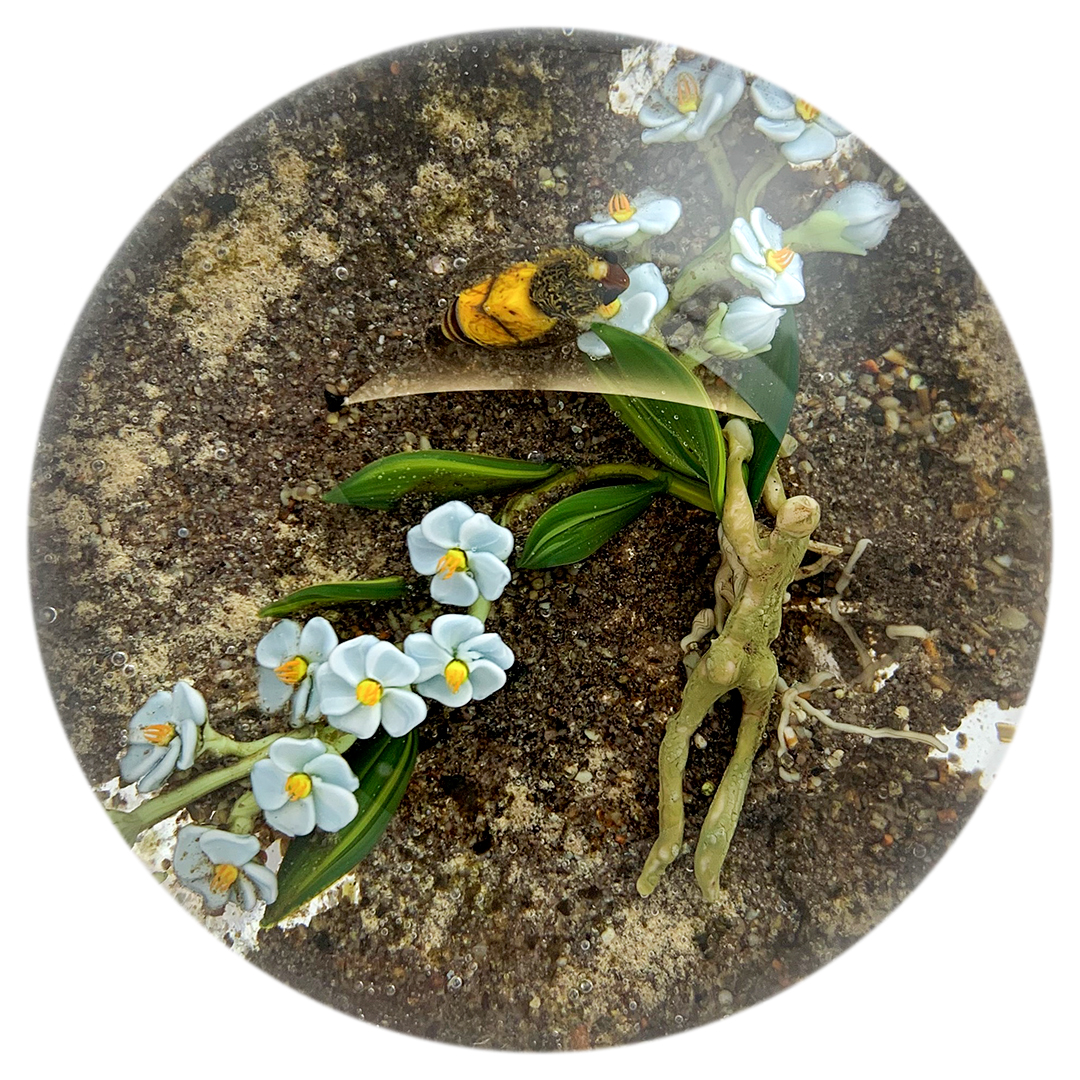
Forget-Me-Nots & root person paperweight
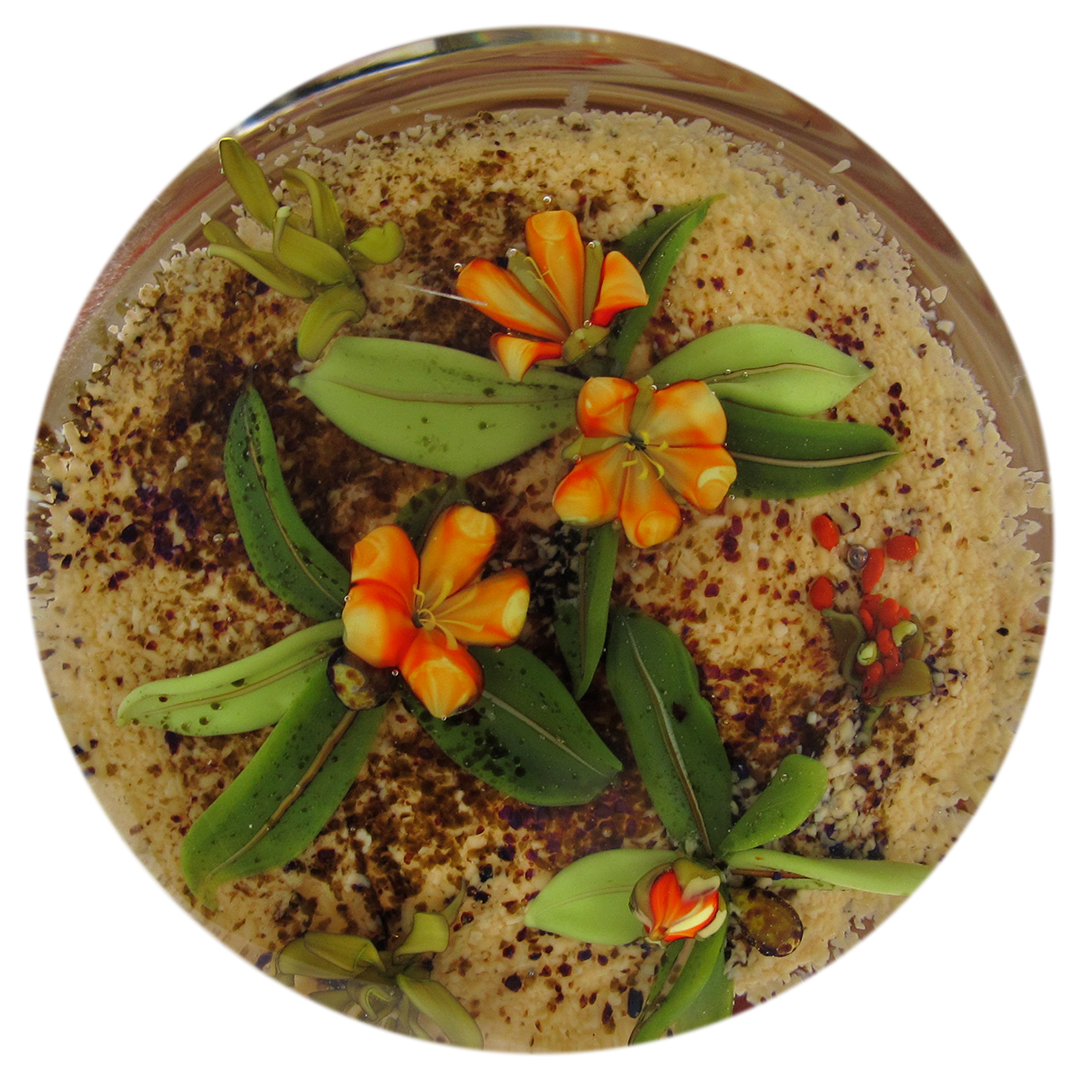
Environmental paperweight top
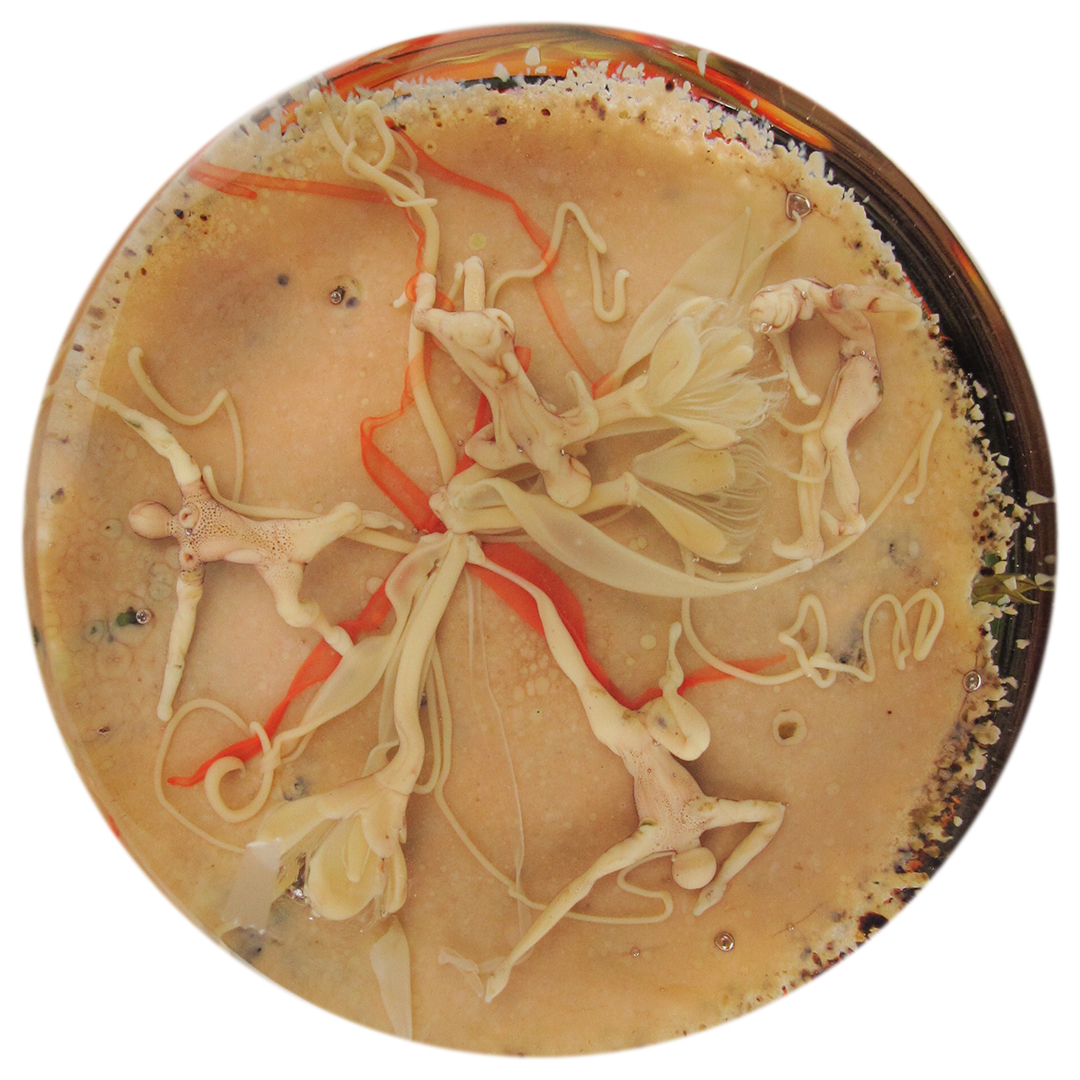
Environmental paperweight bottom
“I want people to go beyond the wizardry of whether it is real or glass. It is about respect for living things.”
Paul J. Stankard
Botanical Brilliance
In 1979 seeking new artistic challenges, Paul began to express himself with different glass forms and made a conceptual shift to sculptural art. In his Botanical series, he depicted life above and below the earth and allowed his metaphysical ideas to take shape. His floral clusters gracefully suspended in upright, angular glass blocks present different perspectives on his miniature worlds. A dramatic formal effect was achieved with his cloistering technique where layers of colored glass are coldworked and laminated to filter or absorb light. New elements in his cloistered columns and cubes included golden orbs and bowls, representing spiritual offerings, for example a golden bowl of tiny cherries suggests “Life is just a bowl of cherries”.
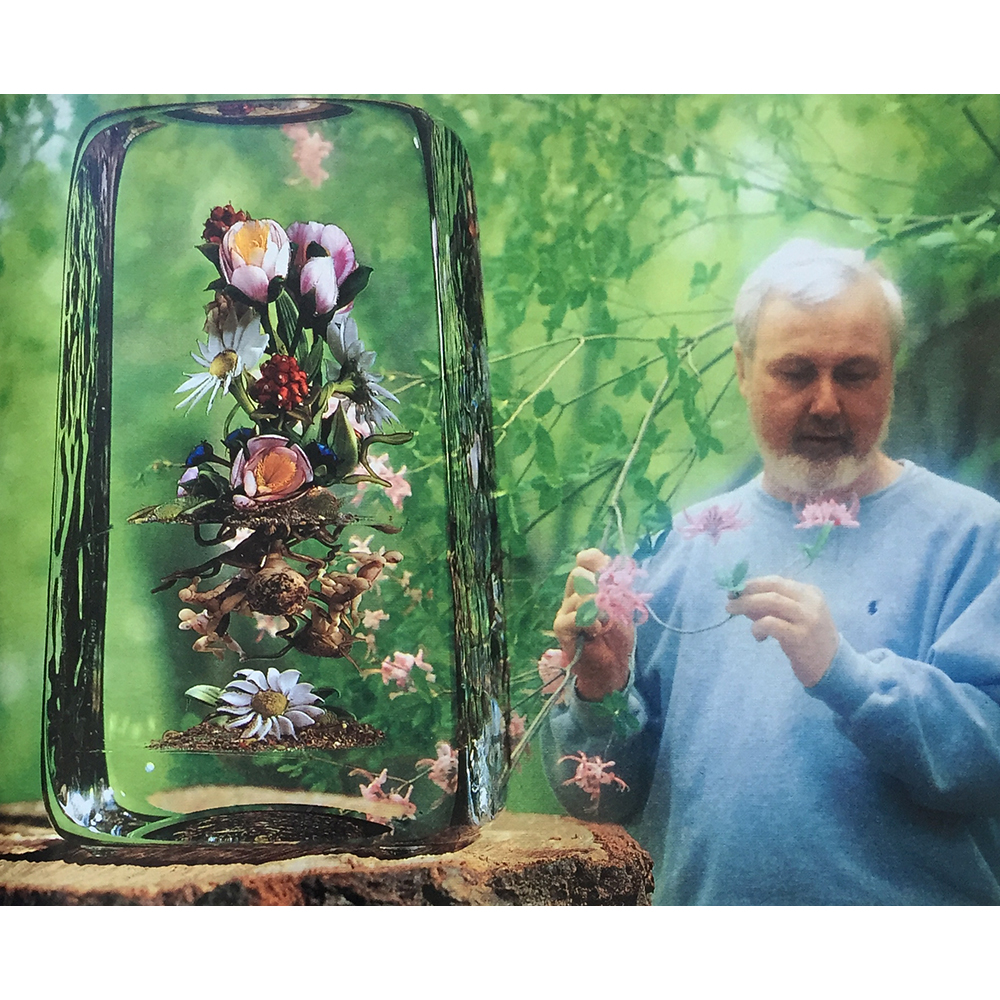
Paul Stankard with Pineland Bouquet Botanical superimposed in National Geographic 1993
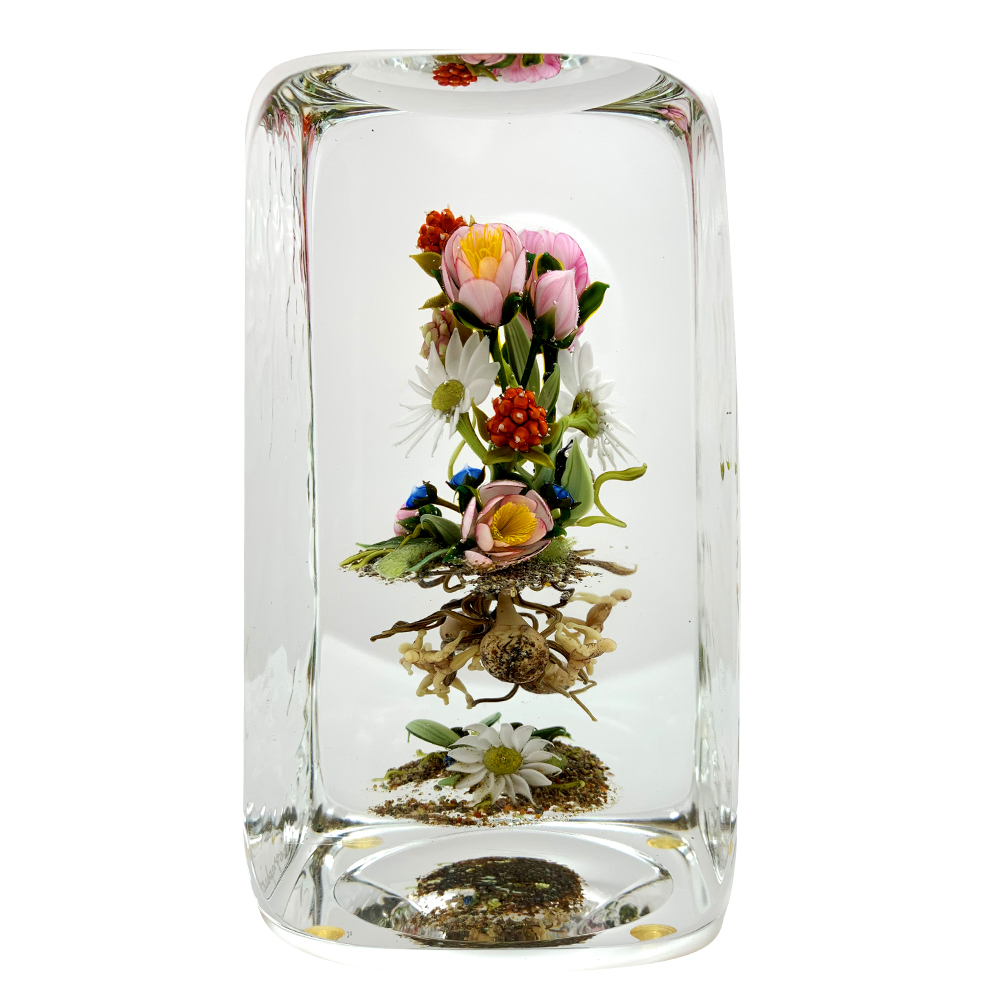
Pineland Bouquet Botanical
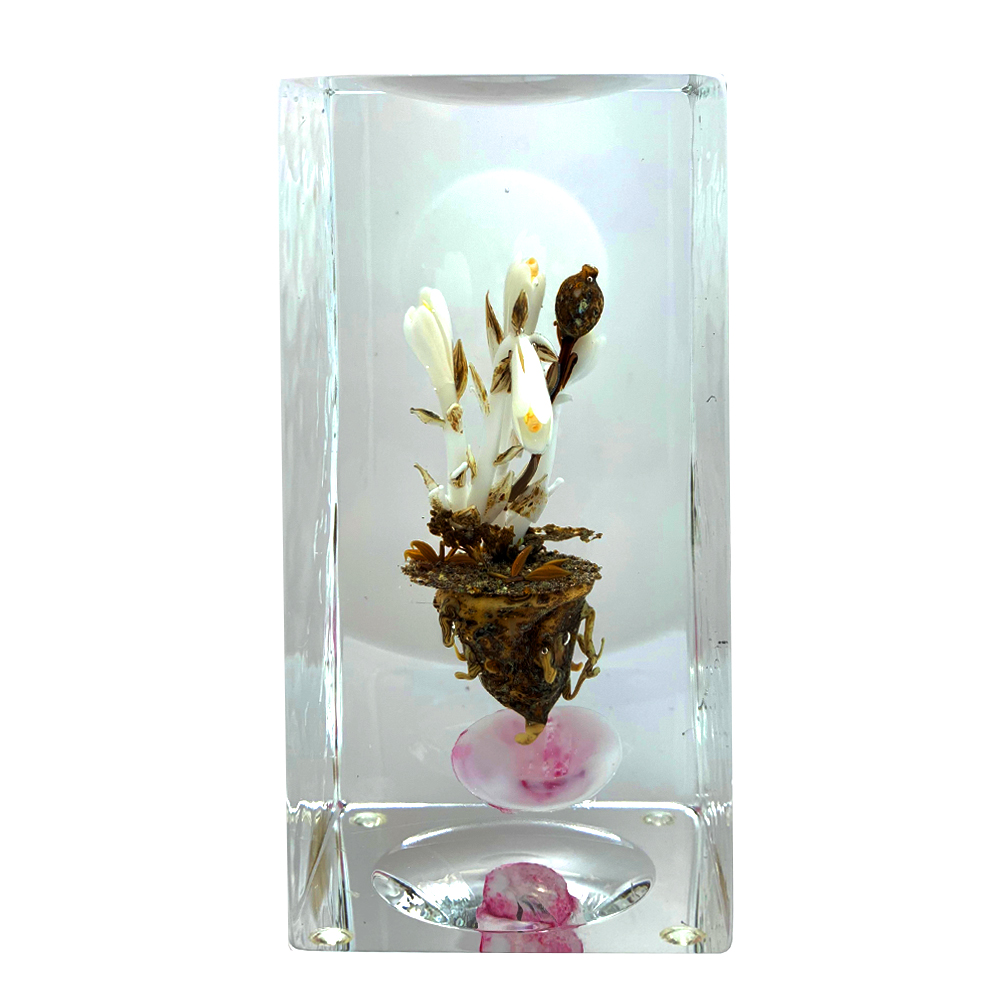
Botanical with Indian Pipes
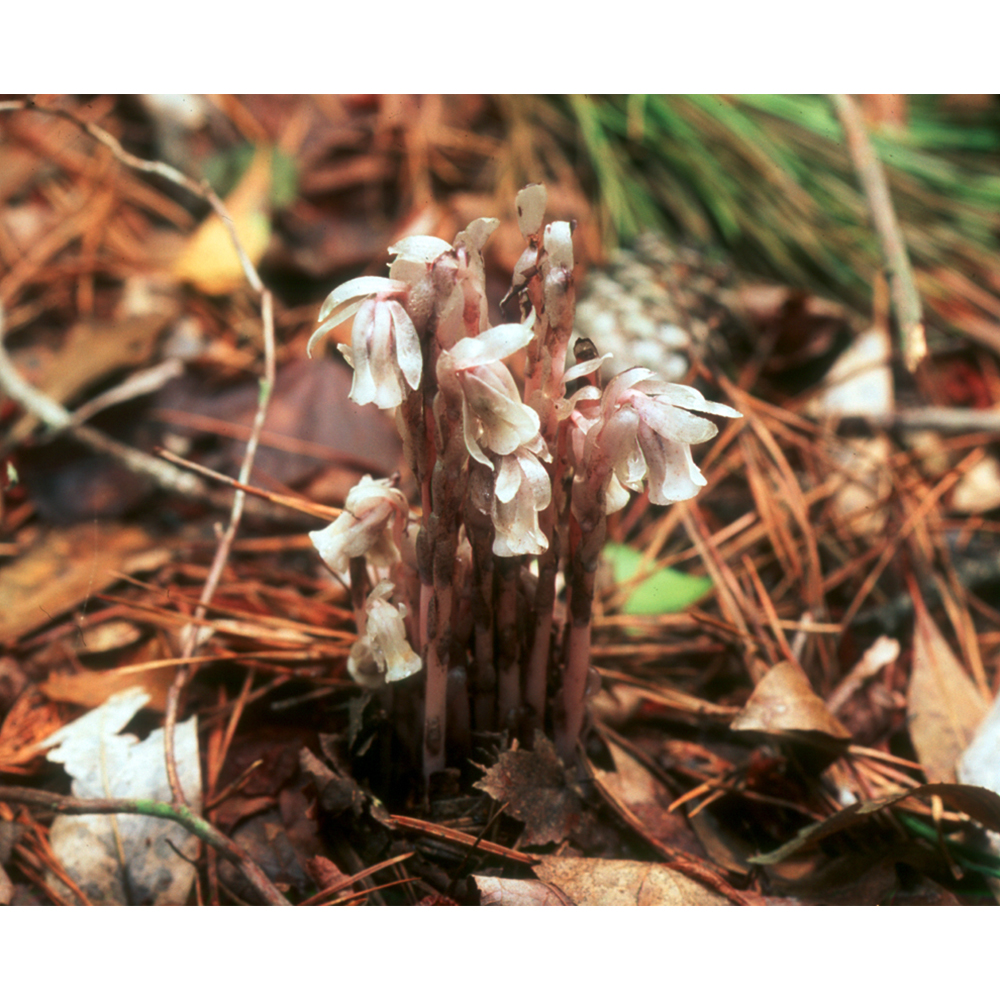
Indian Pipes
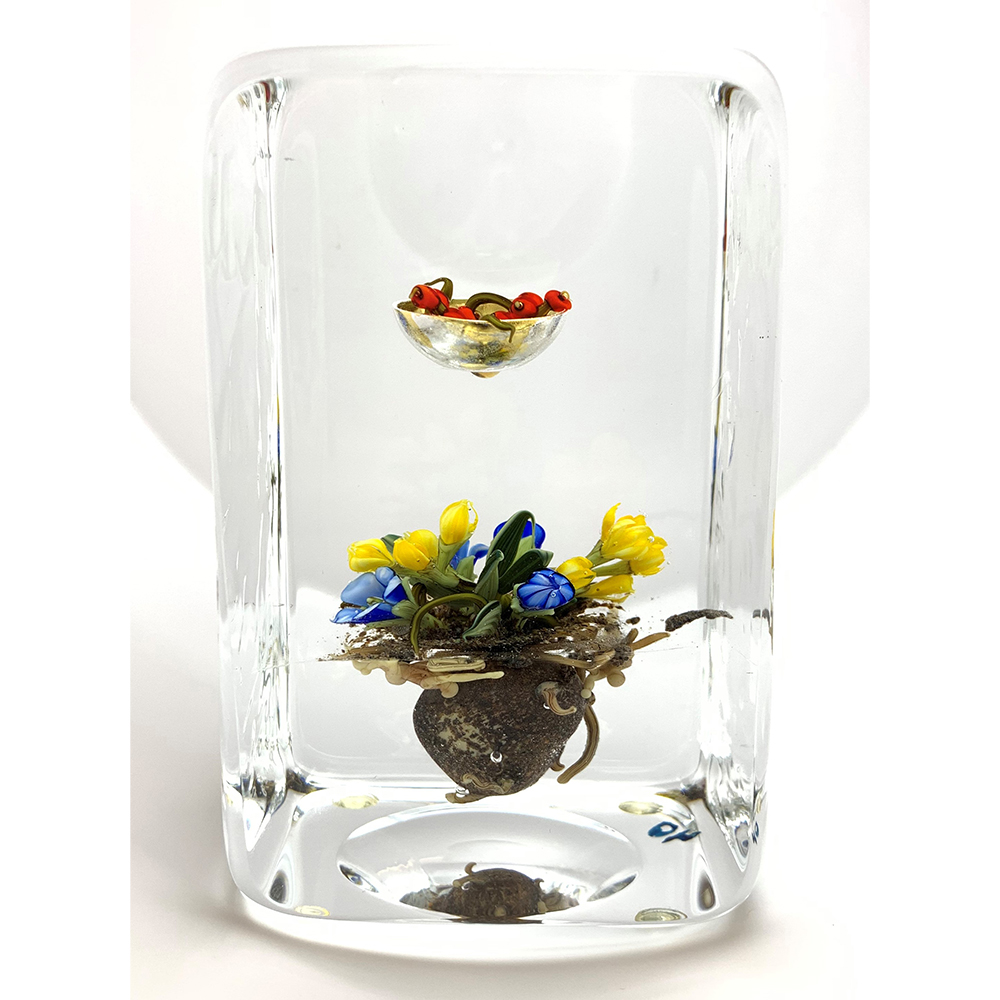
Botanical with golden bowl of cherries
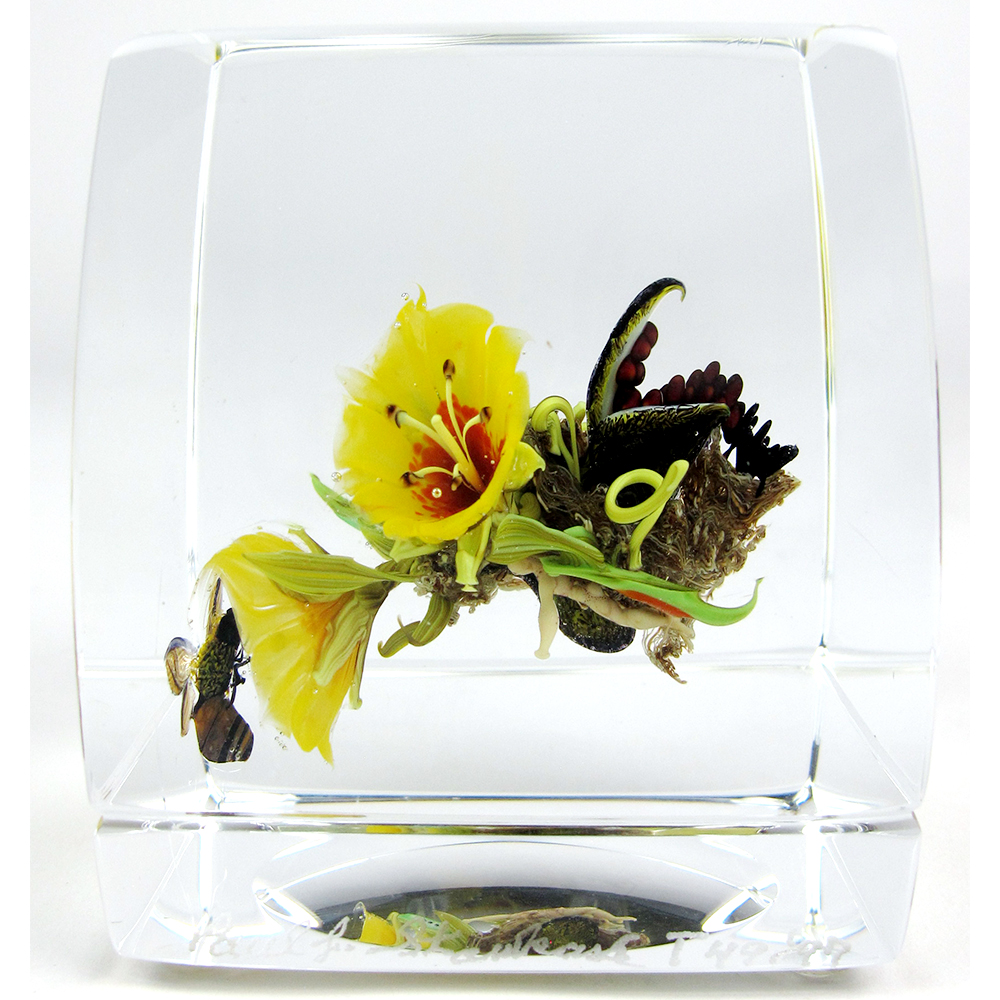
Cube paperweight
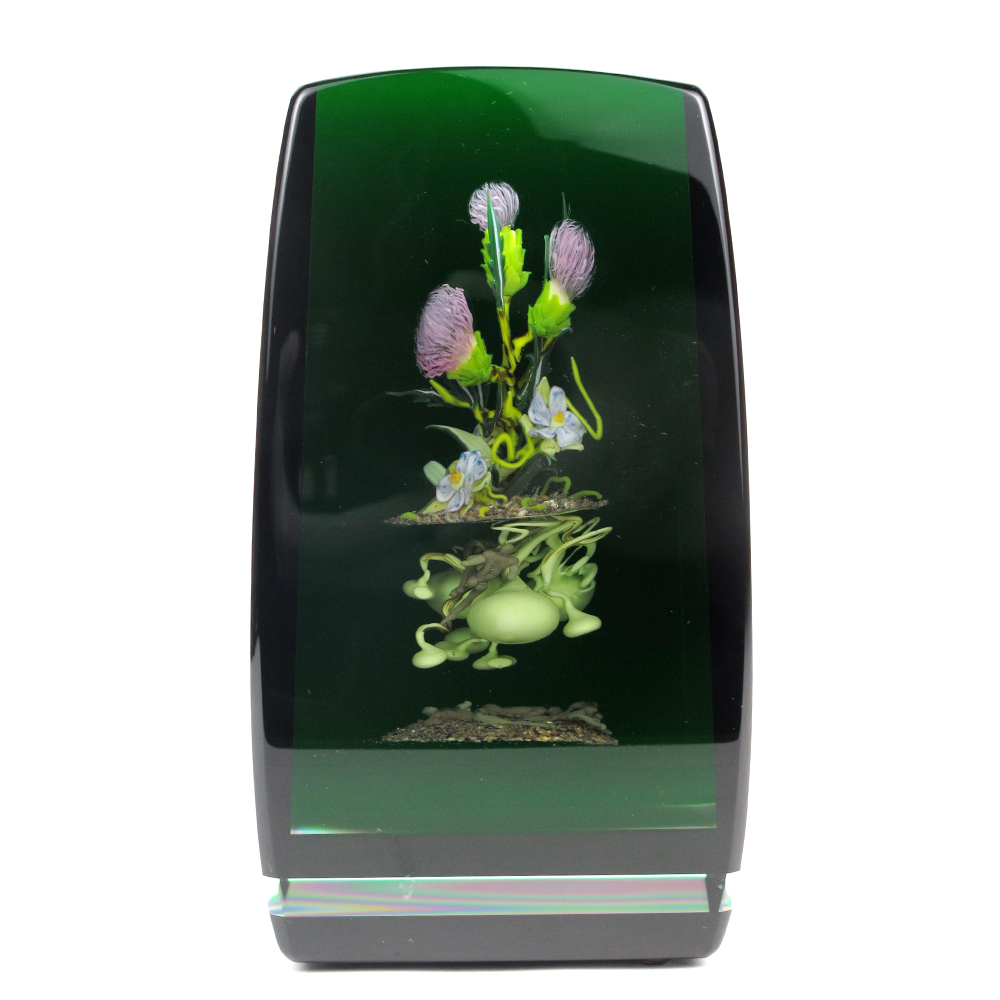
Green glass Botanical
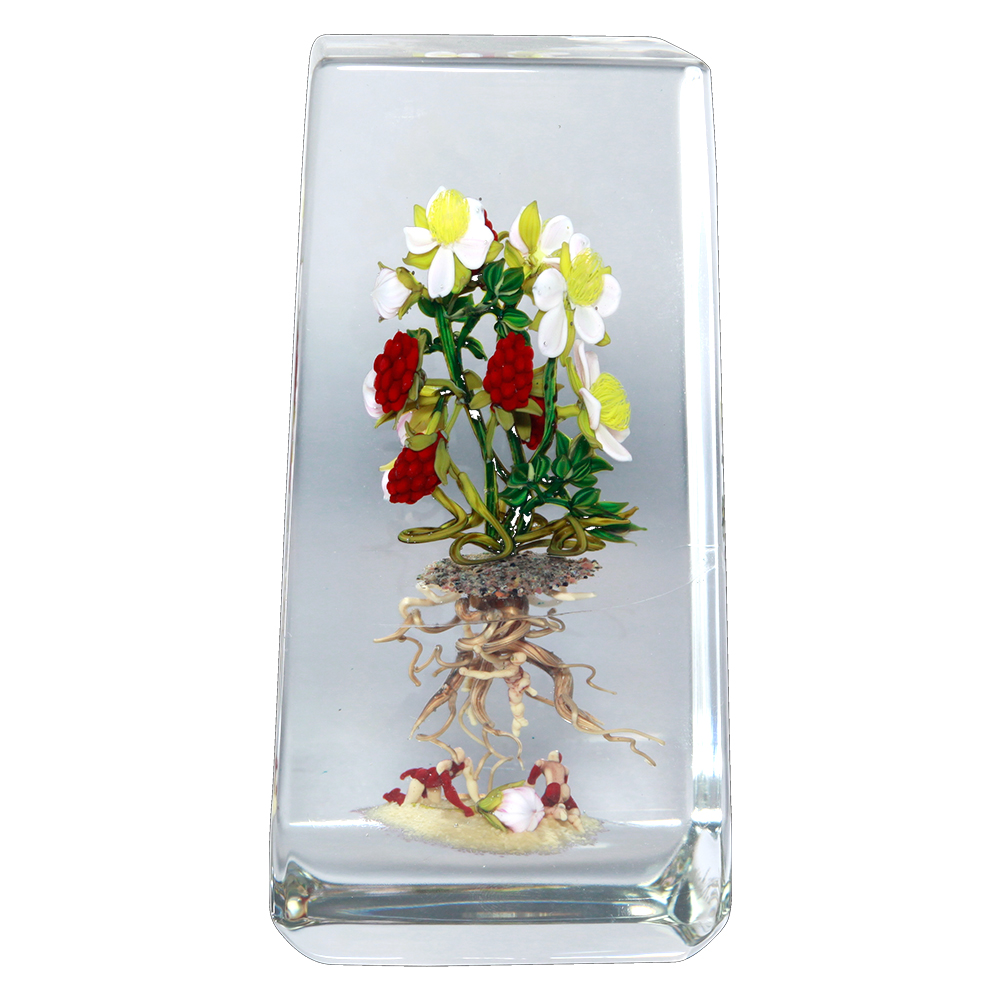
Botanical with root people
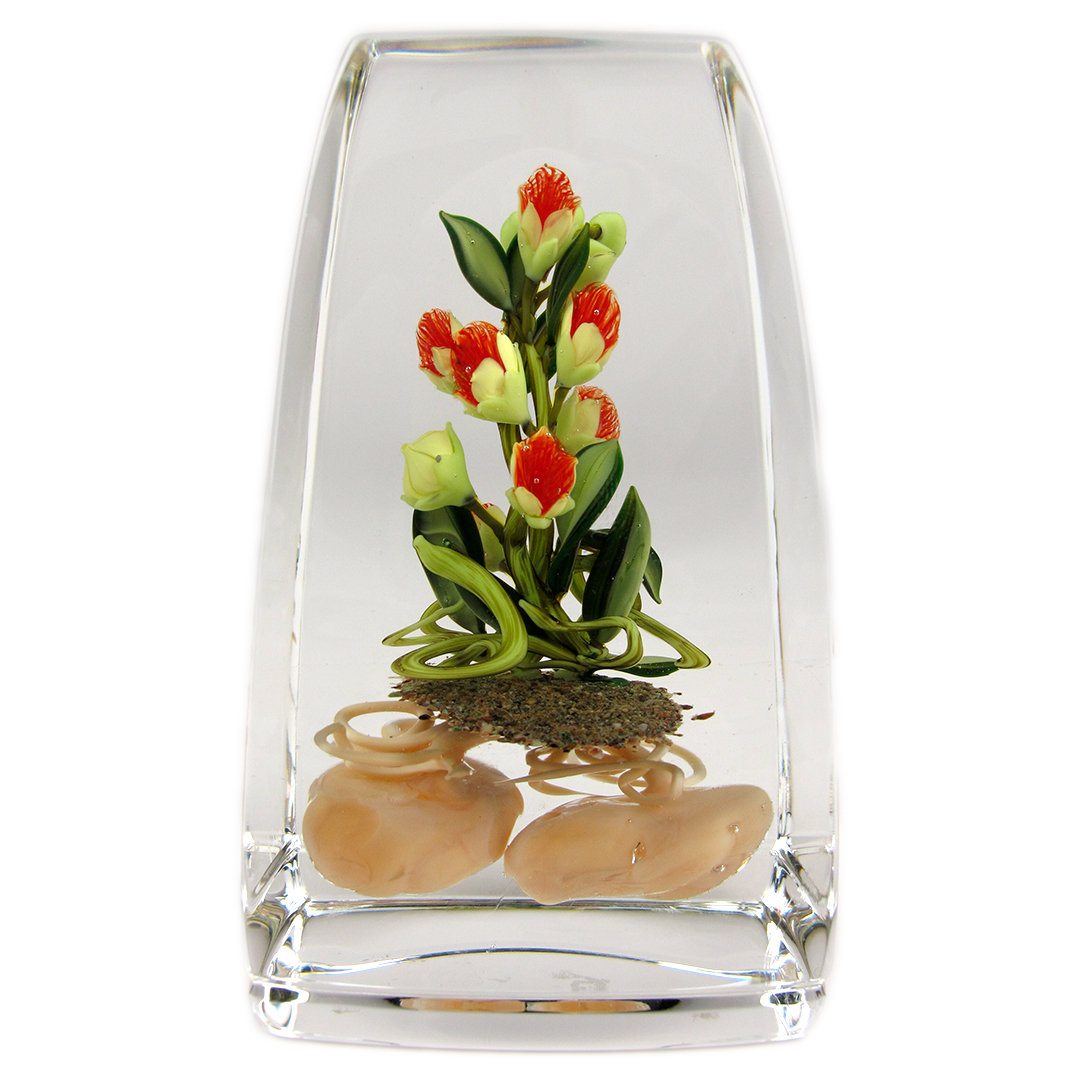
Botanical with bulbs
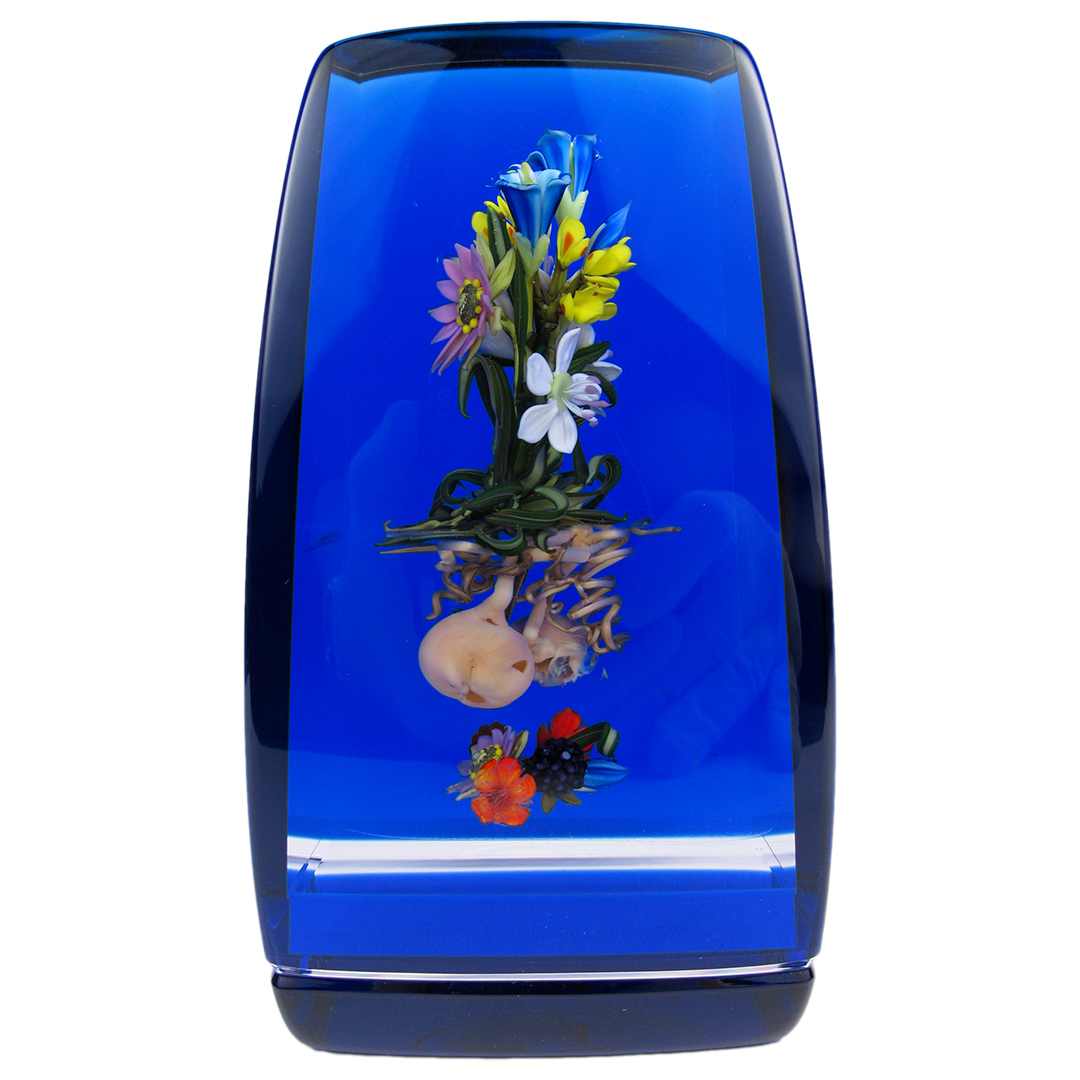
Blue glass Botanical
“I am always searching for new ways to share my feelings, to share what is important by suggesting the spiritual dimensions of nature. By doing my work well, with a high level of craftsmanship, I feel that I am showing respect for God and nature.”
Paul J. Stankard
Into Orbit
In 2002, Stankard began creating glorious orbs like crystal balls symbolizing his spiritual love of the earth. He loved the fact that the orbs had no purpose other than to be viewed and that he had moved away completely from functional paperweight forms. The orbs allowed the encased compositions to be viewed from all angles and the optical quality glass magnified the images. It takes Paul at least a week to make the floral assemblage and then three days for the orb to be to cut and polished. Paul is his own greatest critic. In 2007, to protect his artistic legacy, he destroyed around 400 experiments, or what he considered to be failures. We are fortunate to have some of Paul’s experimental work, which survived the cut.
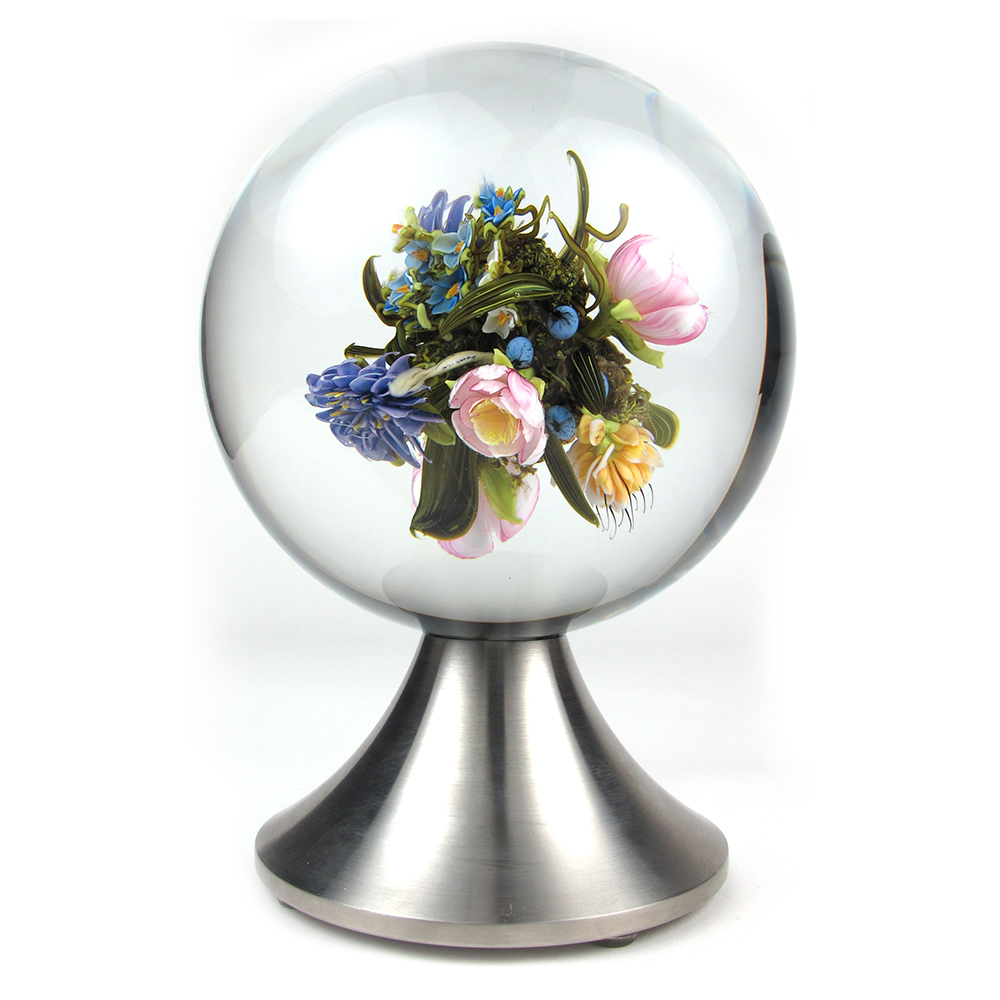
Orb on stand
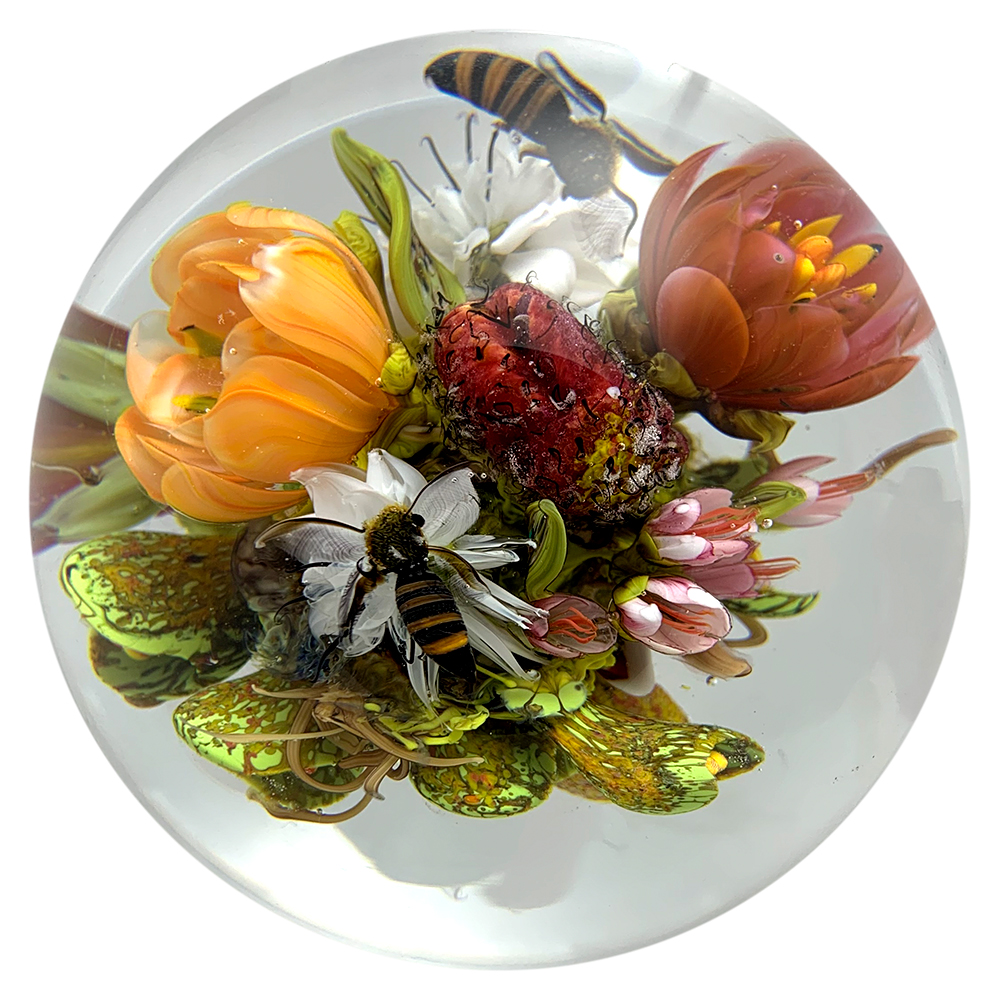
Emily Dickinson Secret Garden Orb
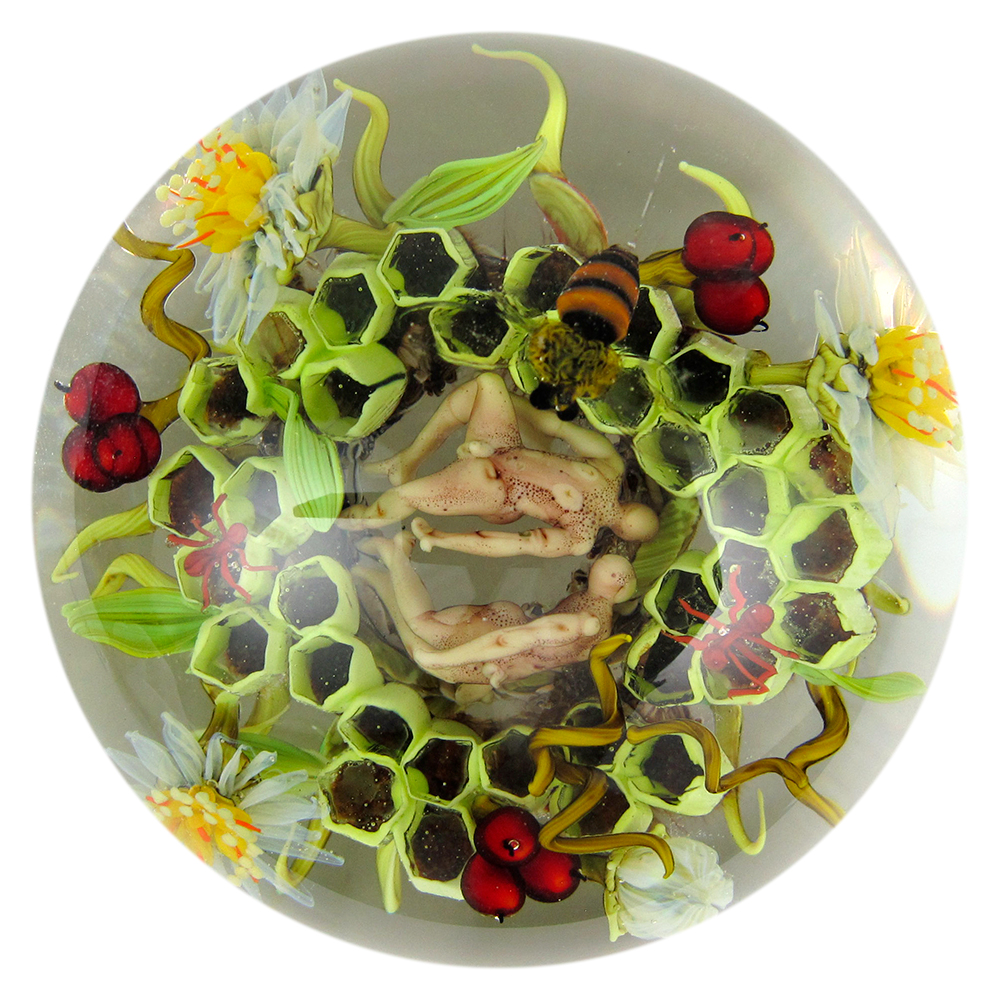
Experimental paperweight with root people
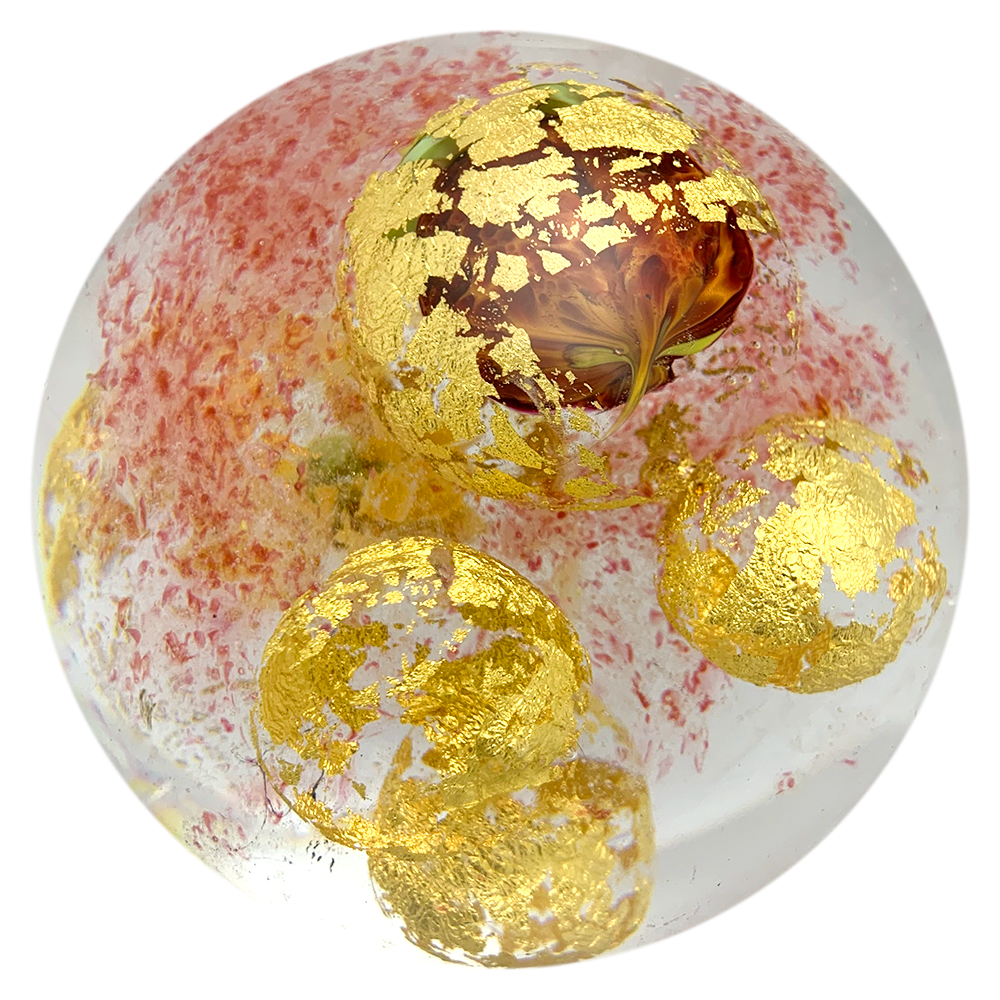
Floating golden orbs in crystal Orb
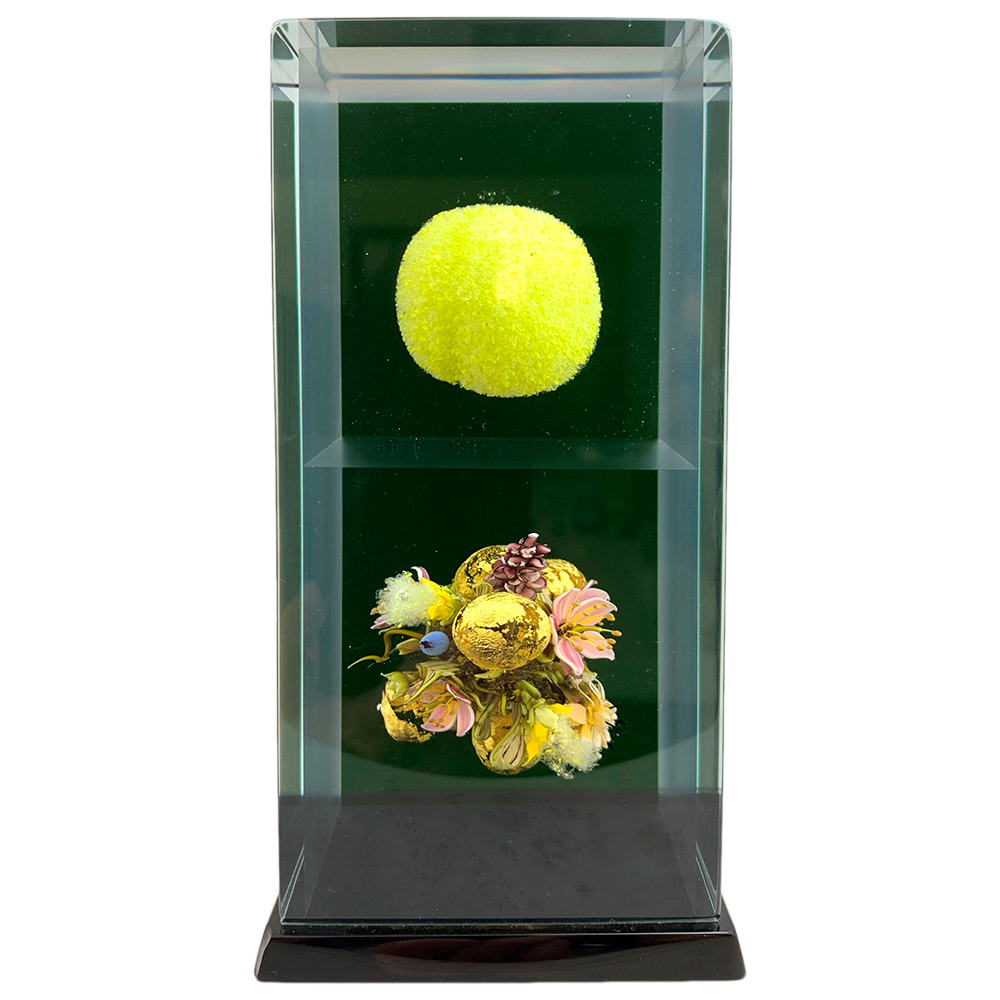
Experimental bouquet cluster with orb
“You would have this clump of roots, dirt, insects. Most of the time it was more interesting under the earth than above the earth. So clumps have been a fascinating area of exploration.”
Paul J. Stankard
The Root of the Matter
Sometimes, magical little people are entwined in the roots of Paul’s work, symbolizing the unseen energy present in the earth. As a child, Paul loved to explore under the ground by pulling out clumps of grass complete with roots and insects. His “earth spirits” were derived from Medieval herbals with woodcut illustrations of mandrake roots in human forms. Mandrake roots have long been associated with superstitious practices. So many people believed in their potency as an aphrodisiac that theft was discouraged by tales of its lethal scream when pulled from the ground, causing death to all within earshot. Fortunately, Paul’s root people are benign creatures and he jokes to fans that he gets up early to catch them and put them in the glass!
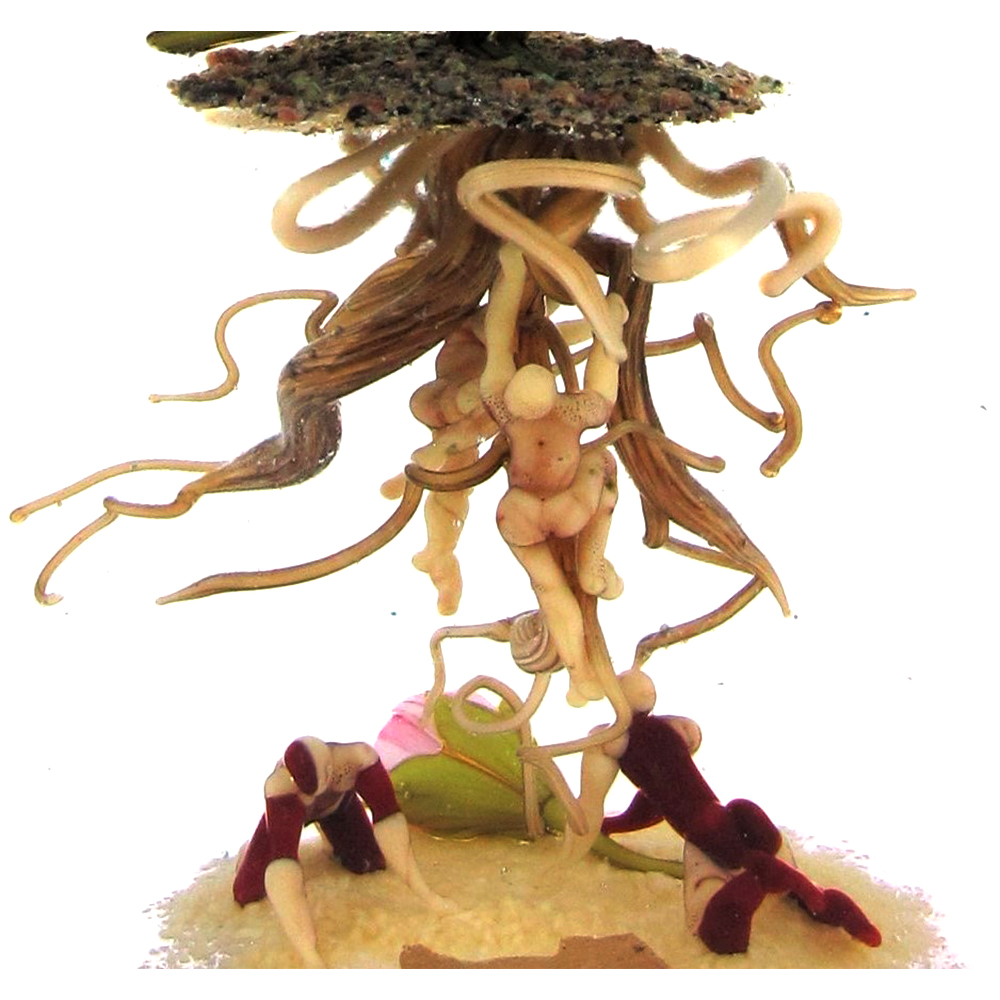
Detail of root people in a Botanical
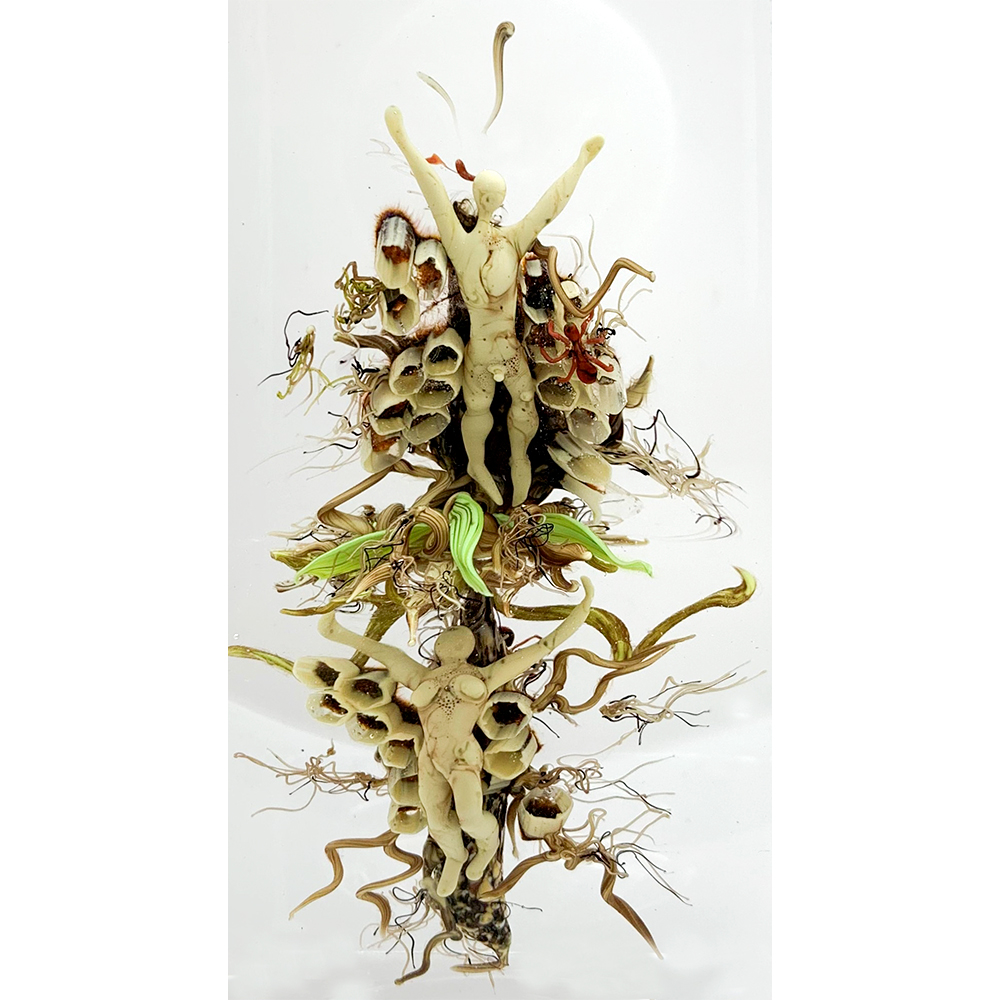
Detail of experimental Botanical with root people
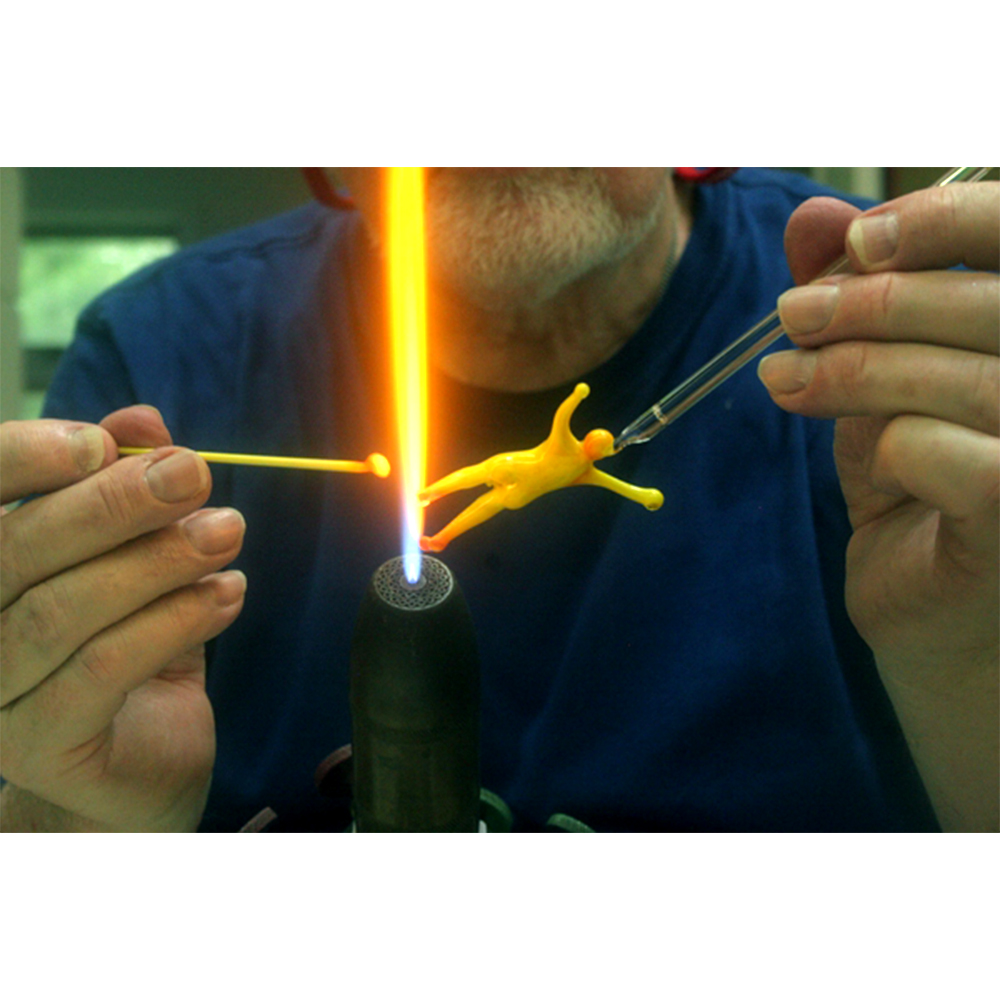
Making a root person
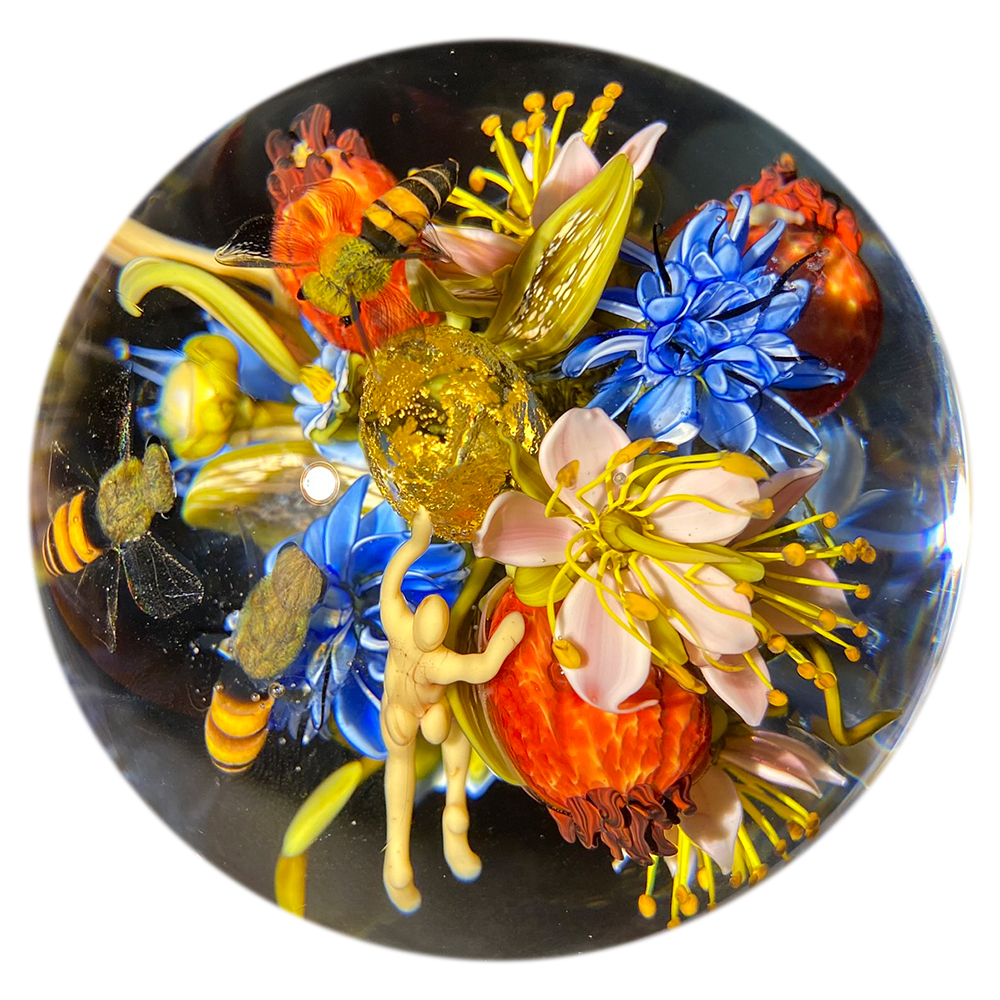
Floral cluster Orb with root person
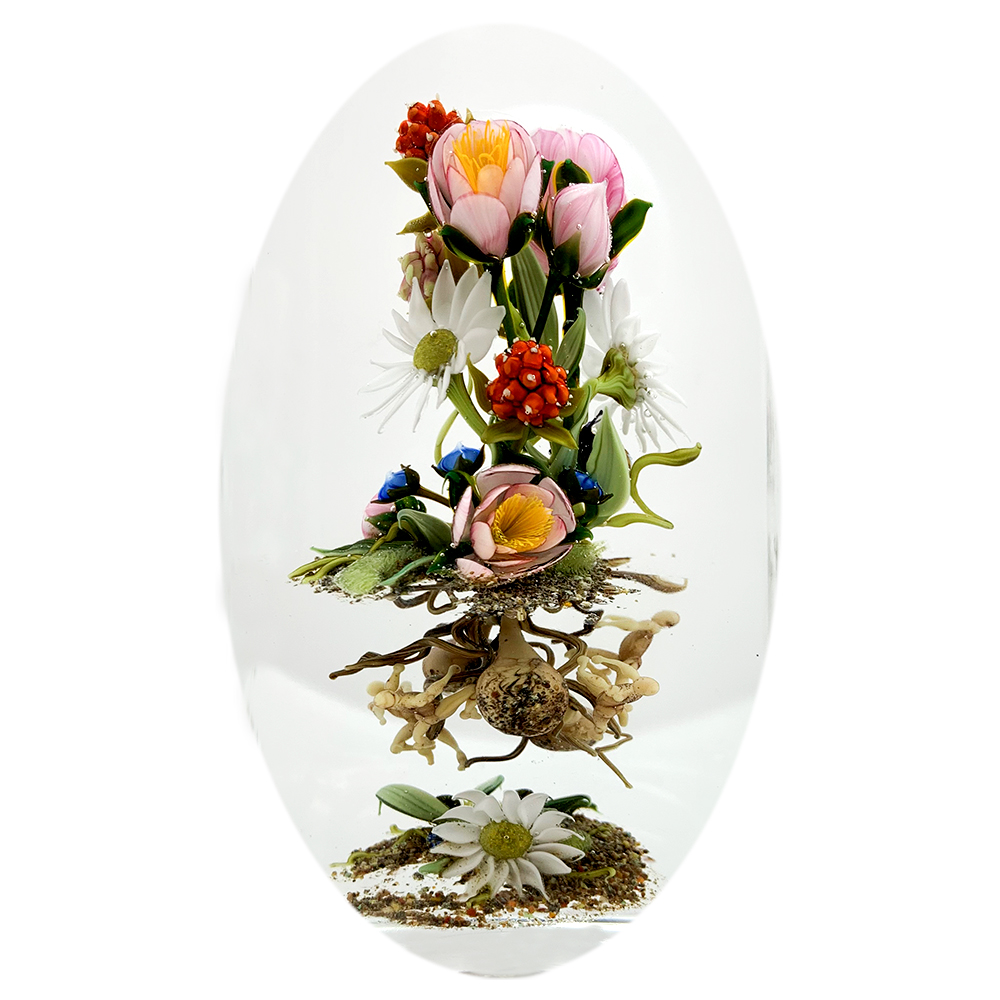
Detail of Pineland Bouquet
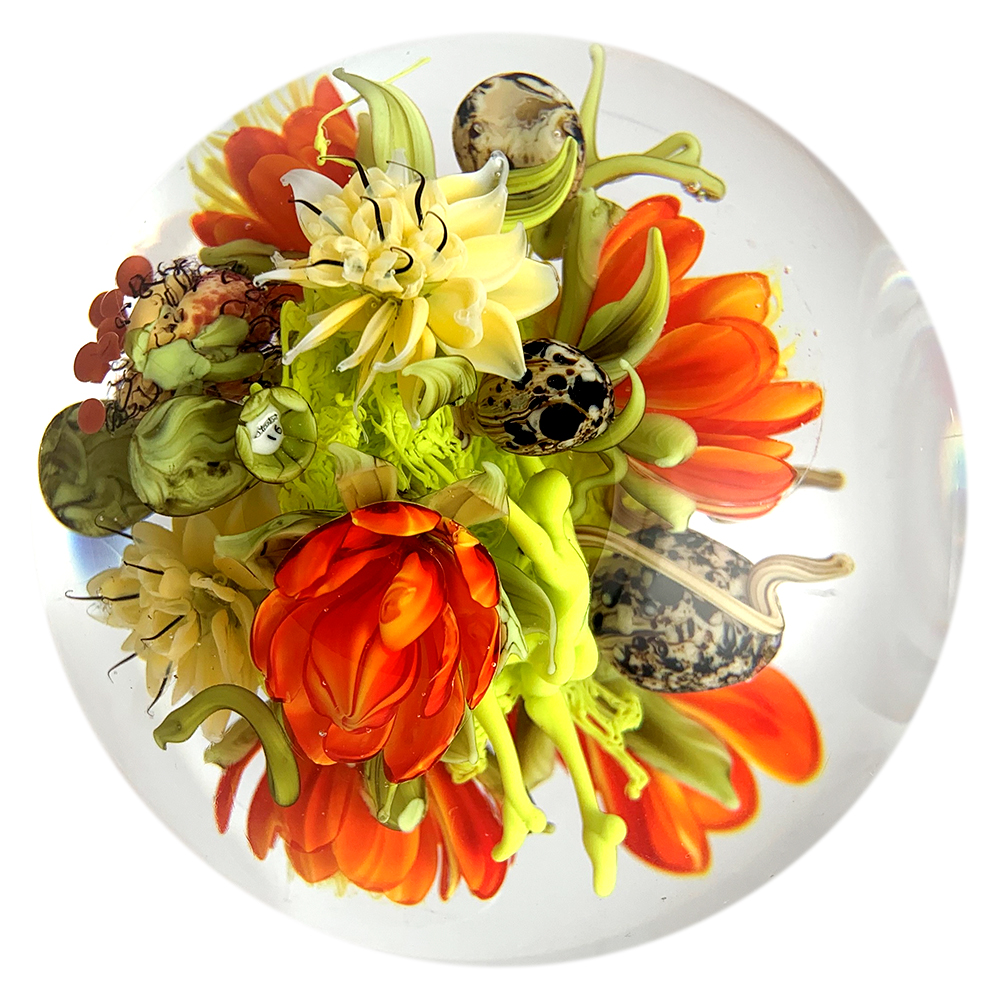
Cactus Blossoms with a root person
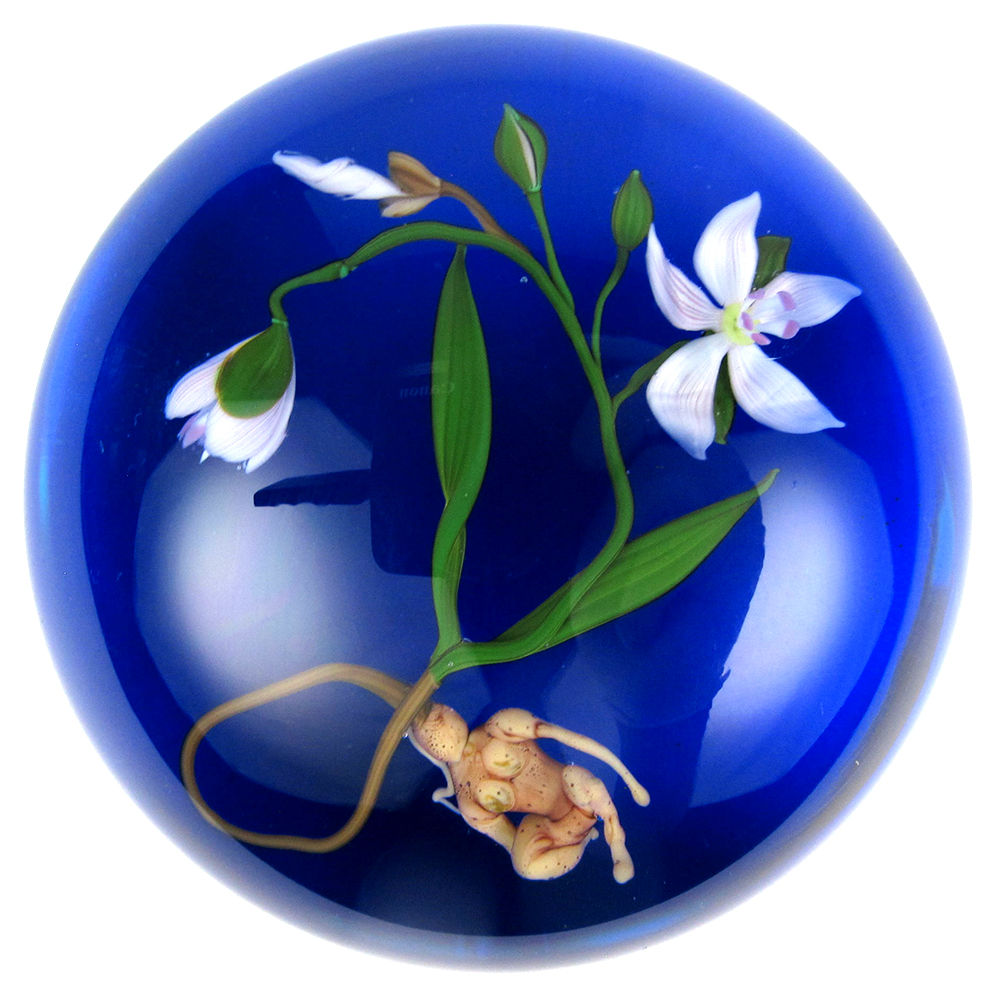
Spring Beauty paperweight with root person
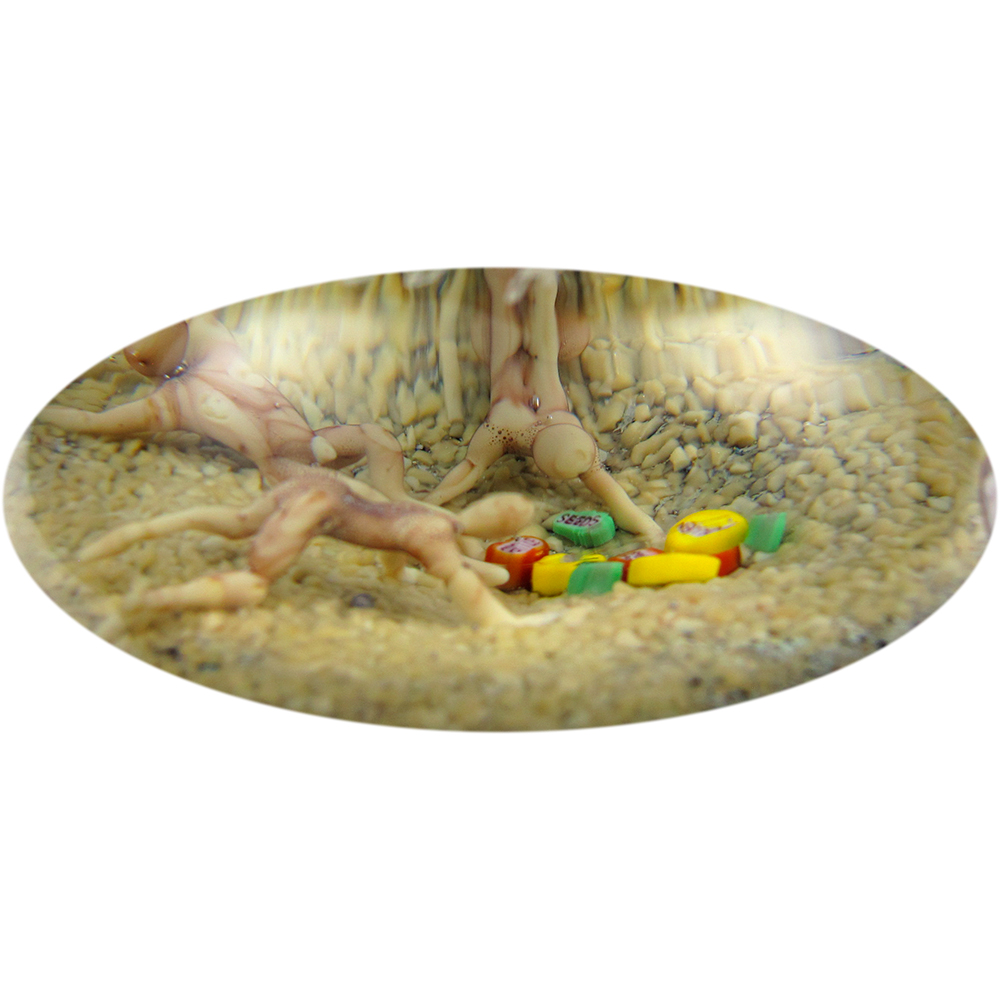
Detail of root people and word canes
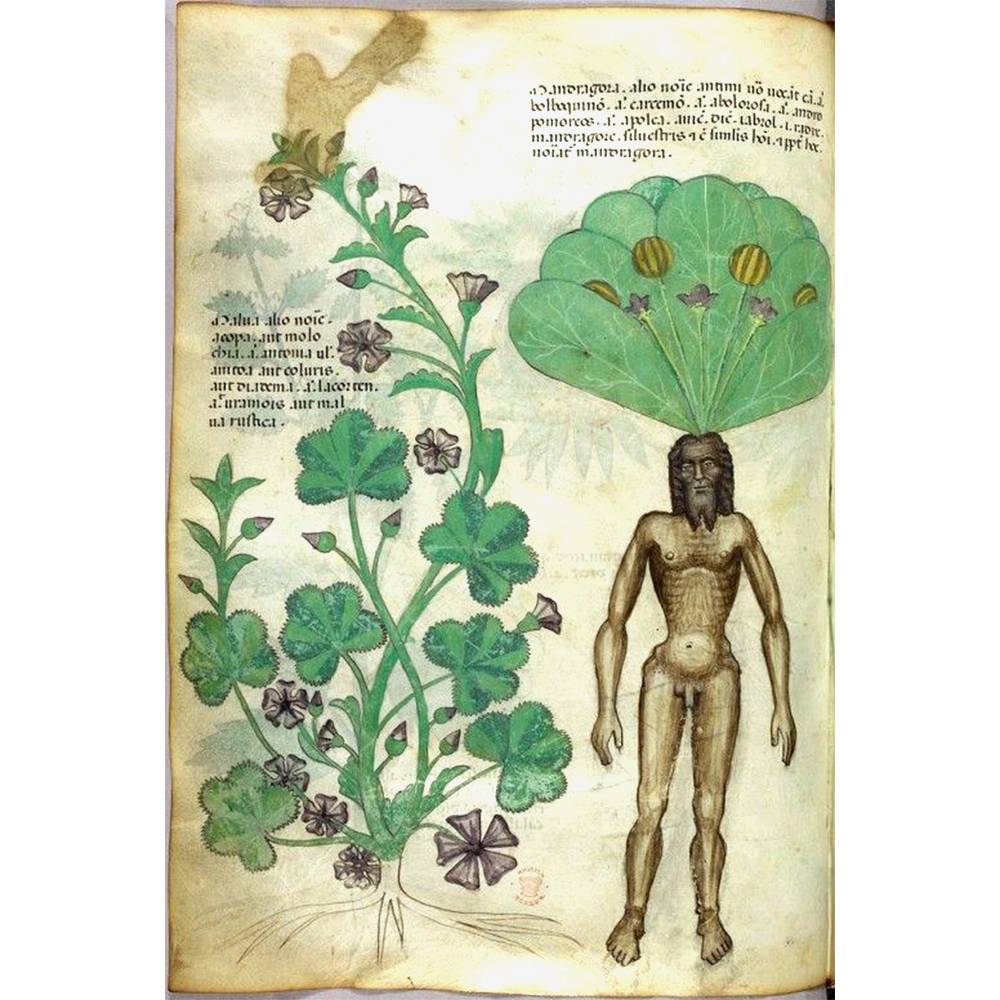
Mandrake root in Medieval herbal
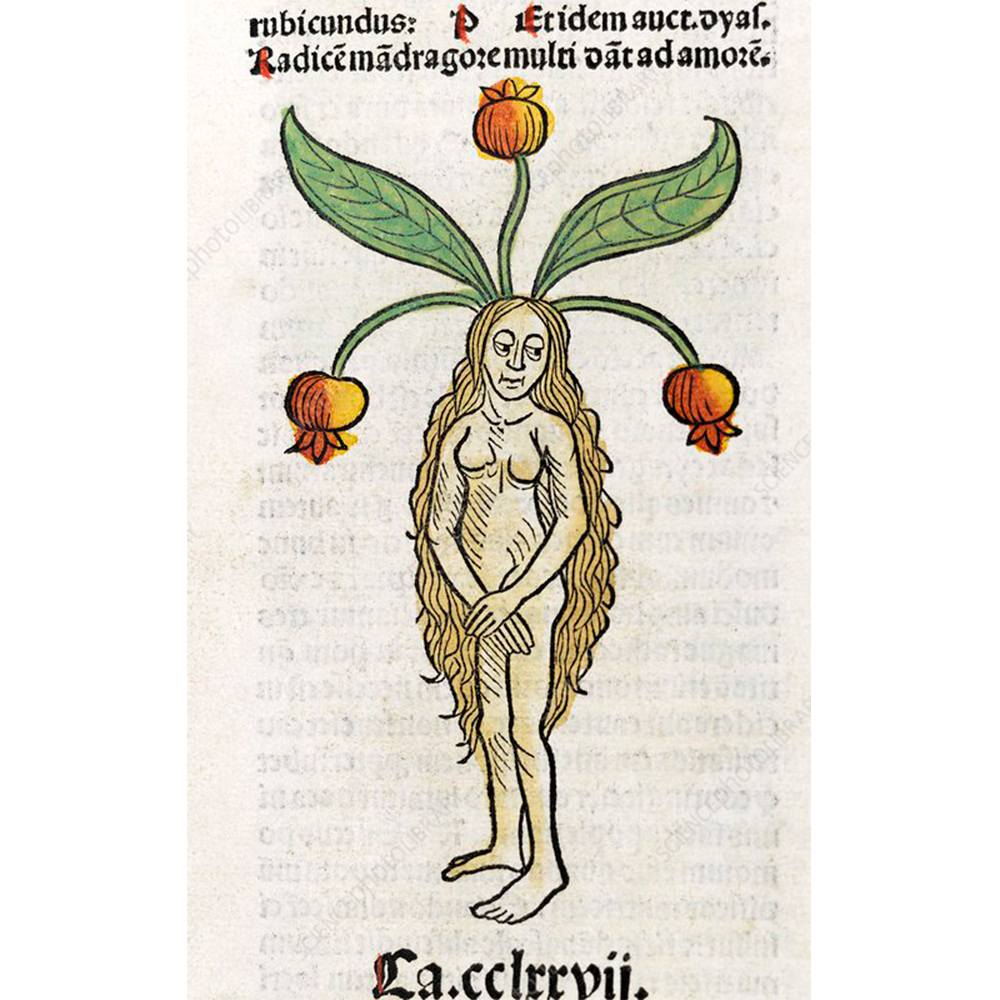
Female Mandrake root 15th century herbal
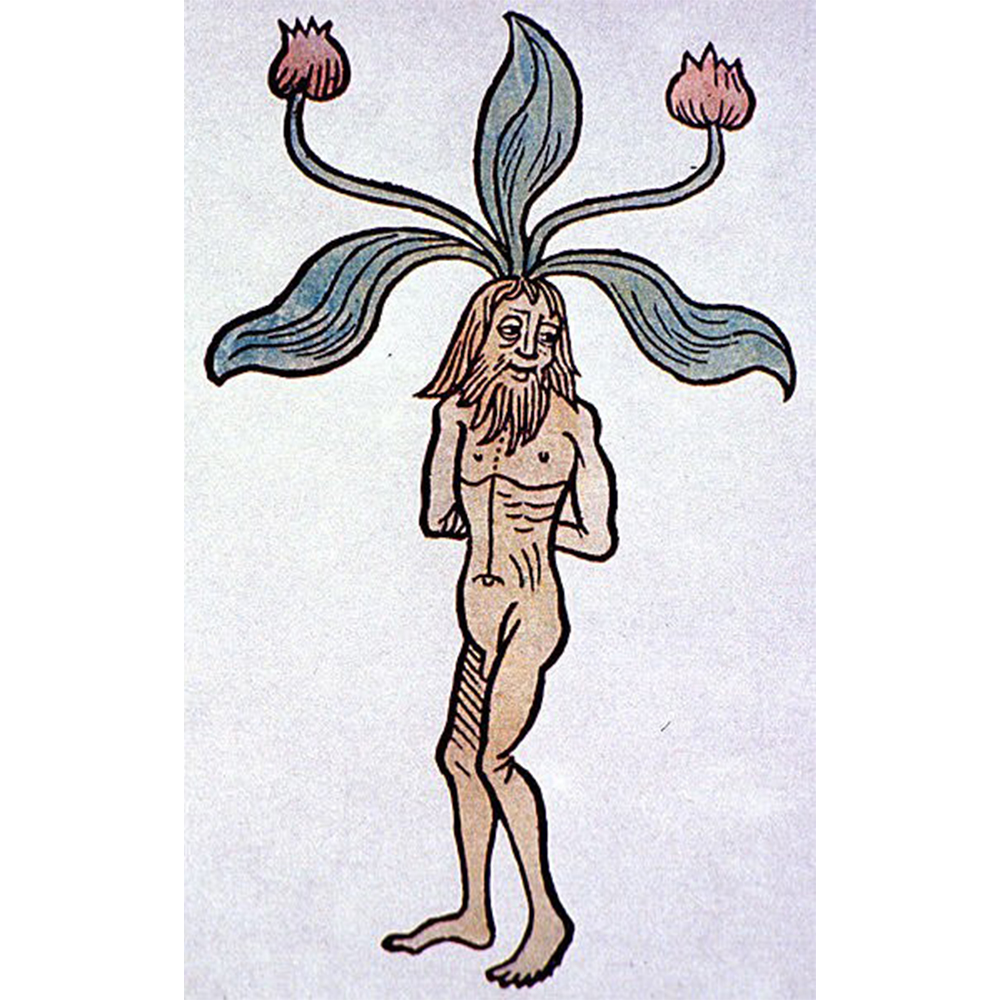
Male Mandrake root 15th century herbal
"I am interested in integrating mysticism with botanical realism, giving the glass organic credibility. Through the work, I reference the continuum of nature, by portraying and exploring the mysteries of seeds, fertility and decay."
Paul J. Stankard
Head and Heart
Paul’s wish to bring human elements into his paperweights once led to a heart transplanted underneath a bed of flowers in memory of a dear friend who died of a heart attack. He also incorporated little heads and face masks, which are reminiscent of the mythological Green Man. He made the masks using the pate de verre technique, which involves grinding glass into a fine powder and adding a binder to create a paste and a flux to facilitate melting. The tiny eyeballs were made separately using Paul’s more usual flame-working process. Some of Paul’s collectors found his face paperweights disturbing and one critic suggested they looked like death masks. In the end, he didn’t make many mask paperweights.
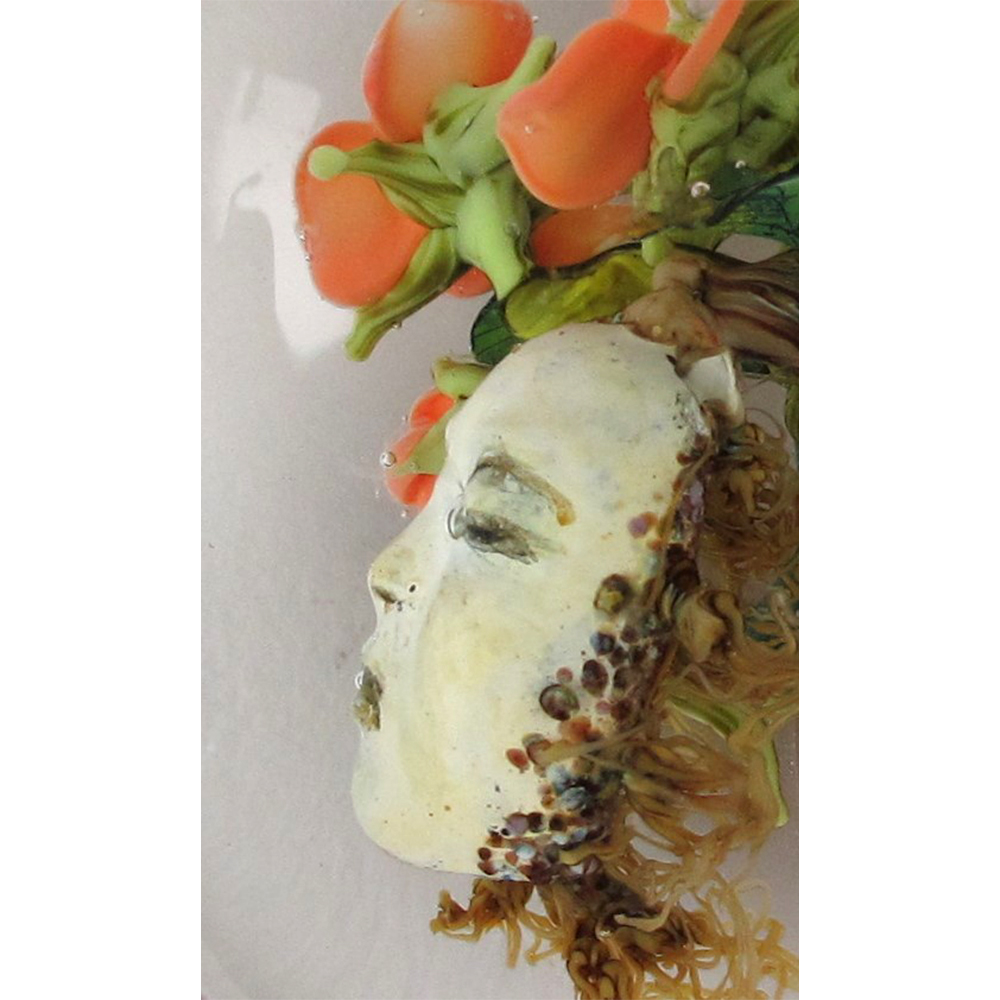
Detail of Mask paperweight
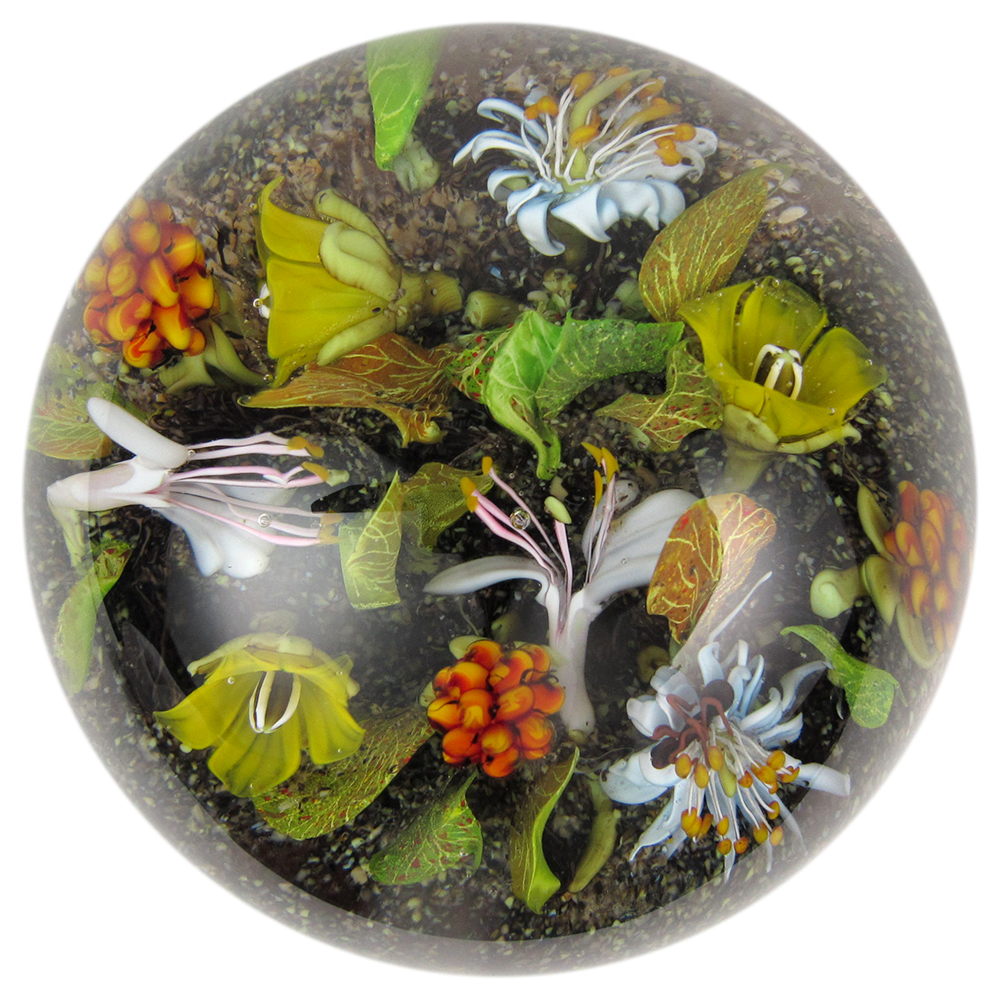
Environmental paperweight top with heart below
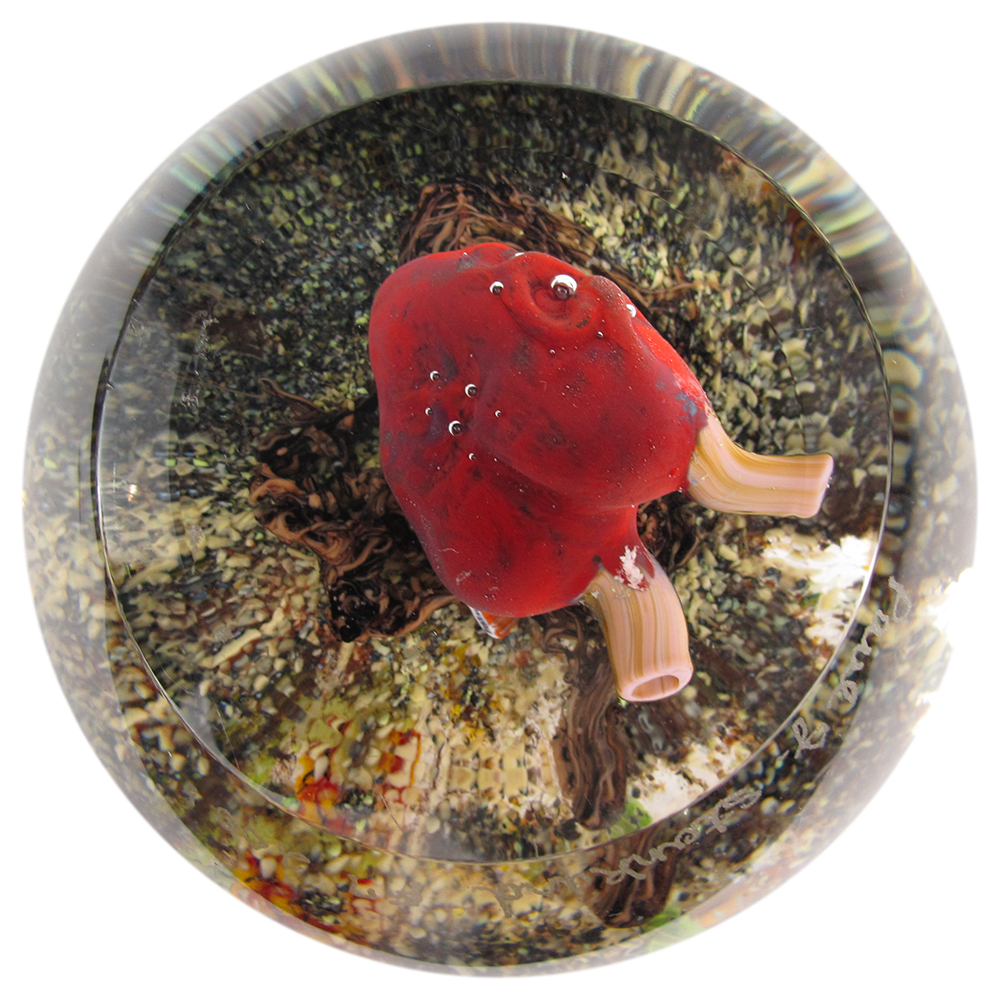
Environmental paperweight top with heart
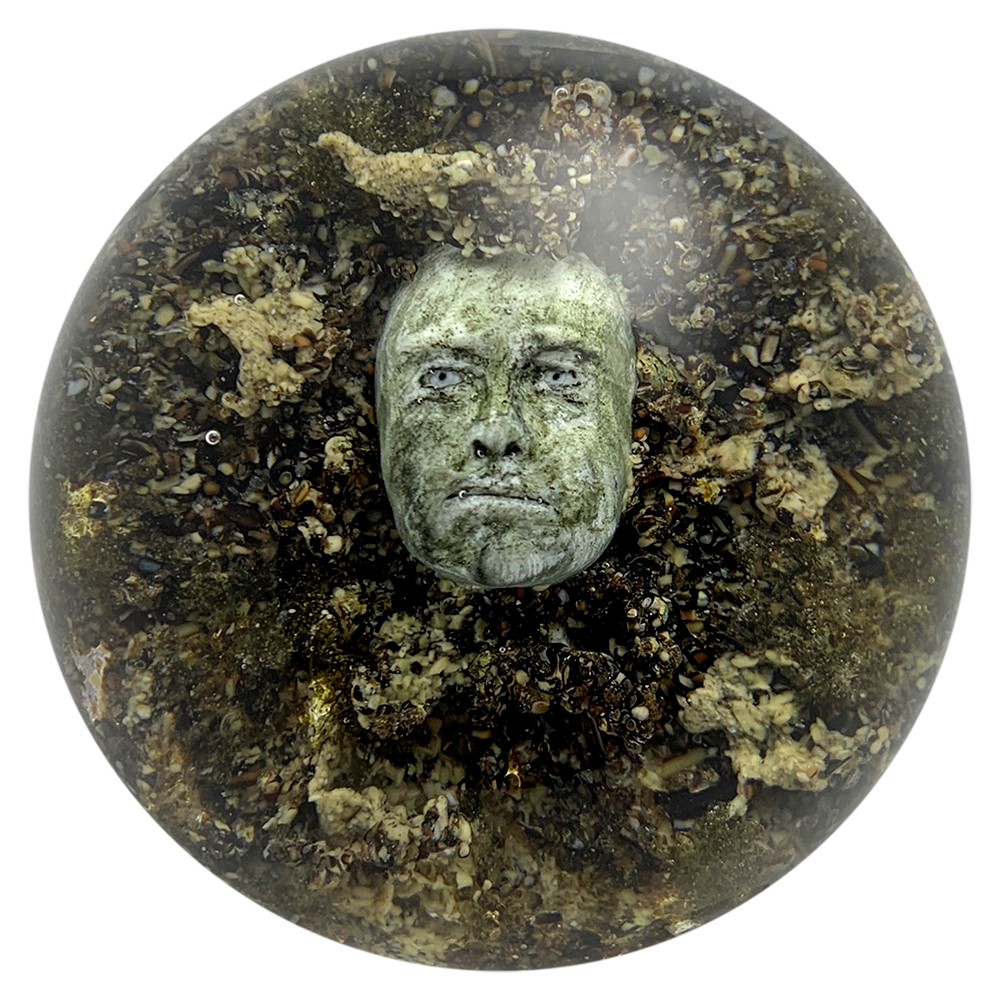
Mask paperweight in earth
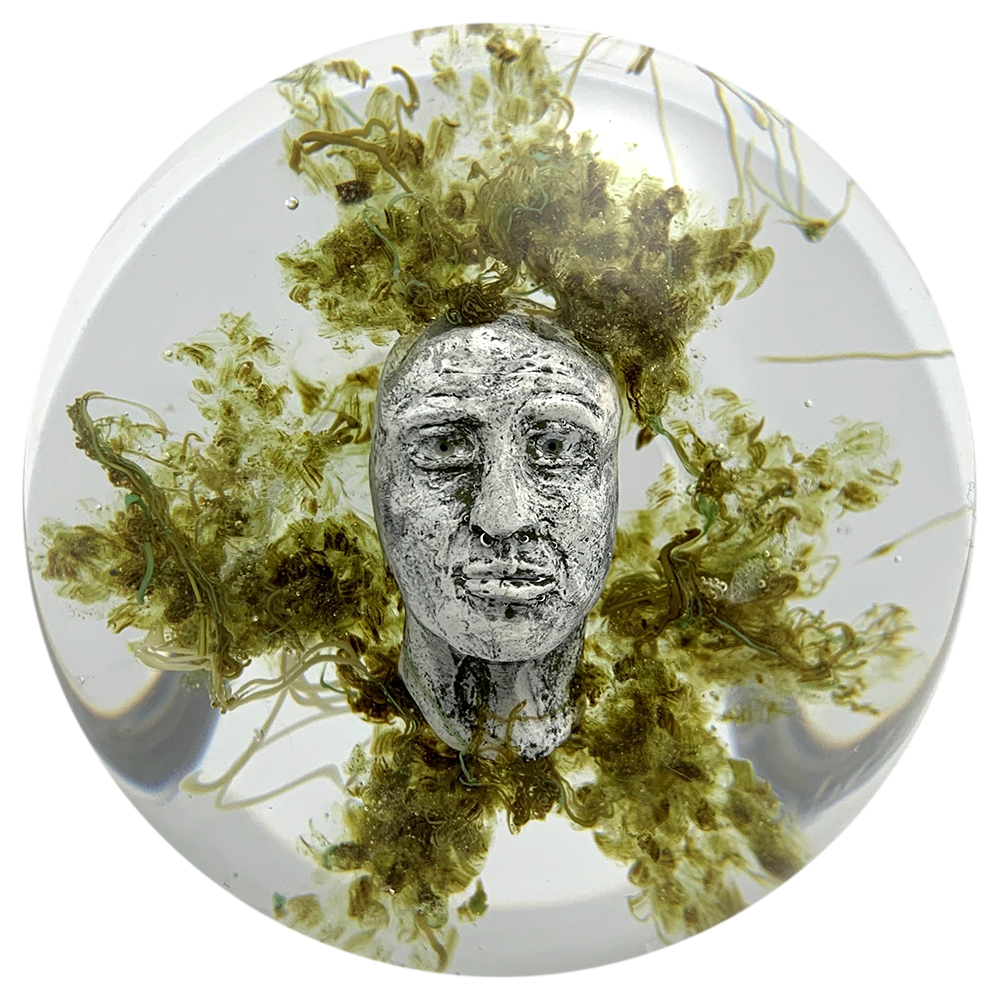
Mask paperweight in moss
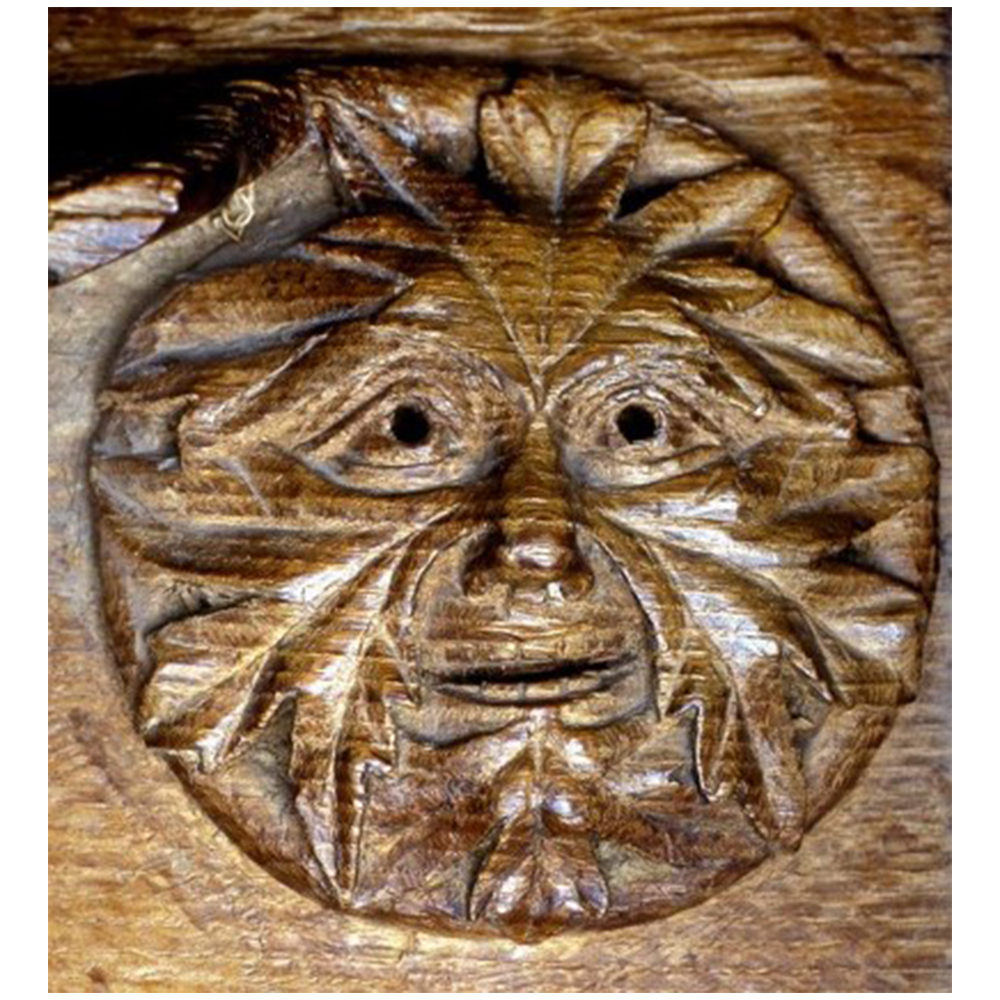
The Green Man wood carving
“With every stage the work is growing in depth of feeling, celebrating the mysteries of nature. It is not about skill, it is about magic.”
Paul J. Stankard
Narratives of the Soul
Throughout his career, Paul has continually pushed the limits of glass and taken risks as he moved from producing traditional paperweights to creating Botanical sculptures and then on to complex panels with several microcosms in a grid format. Typically, his paperweights take a day to make but his Botanical sculptures can take three or four days of intense work and creative energy. One of his most ambitious works is the Nantucket Bouquet with nine floating clusters of flowers, leaves, berries, insects, and root people encased in clear crystal. Over the years, he has added more depths of meaning to his forms. His lovingly rendered studies have been described as narratives of the soul and visual poems to the splendors and mysteries of the natural world.
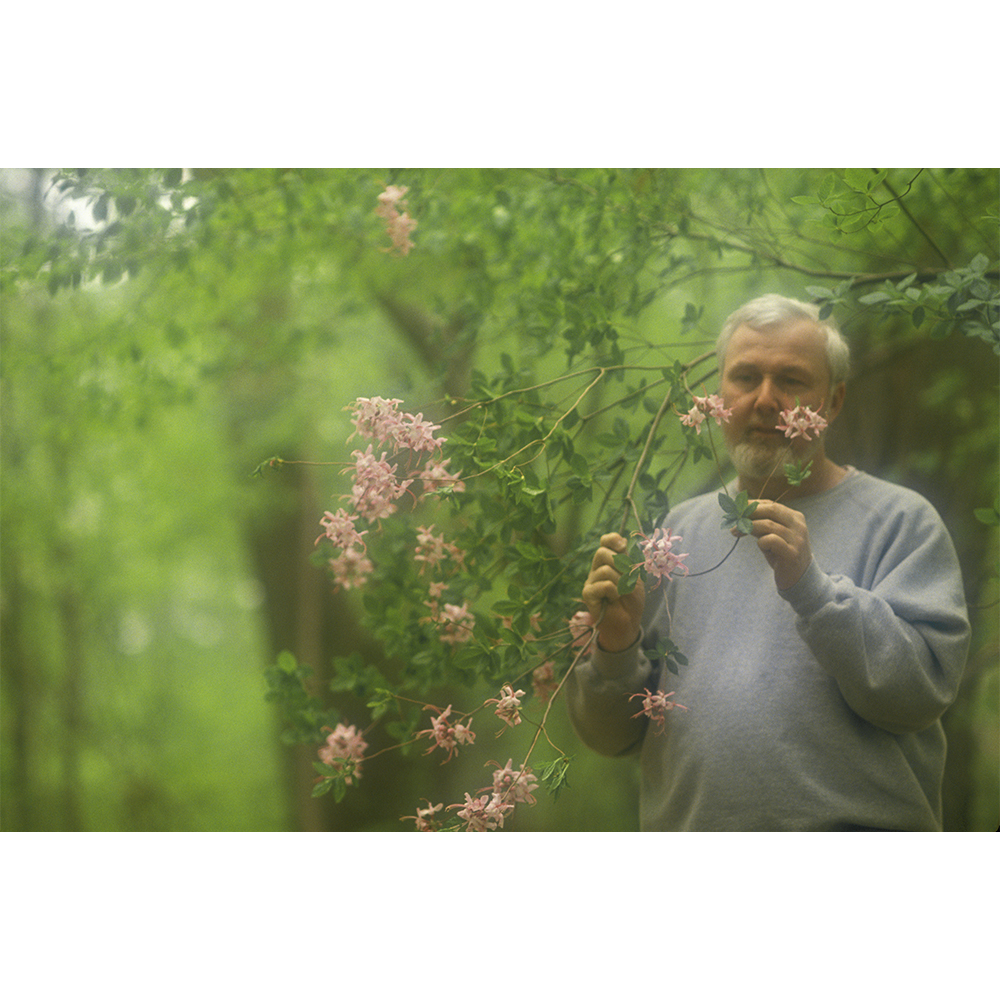
Paul Stankard
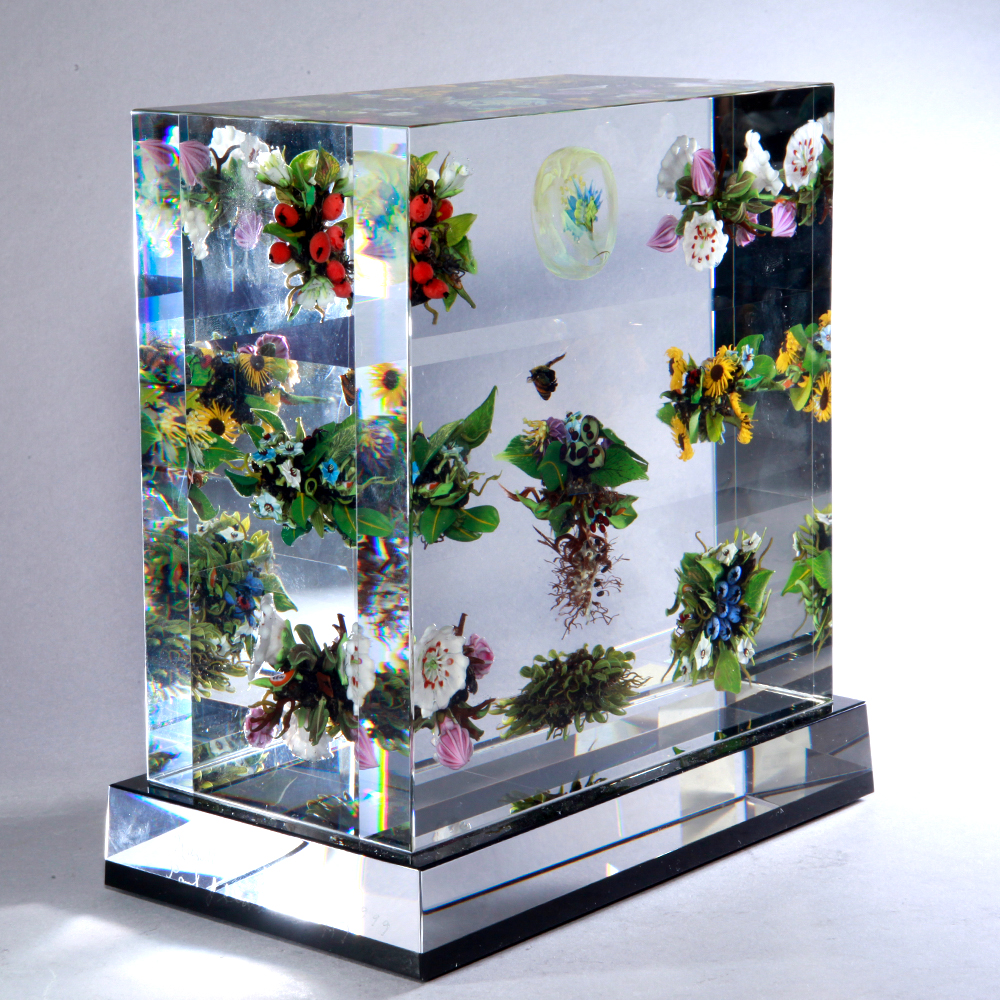
Nantucket Bouquet Assemblage
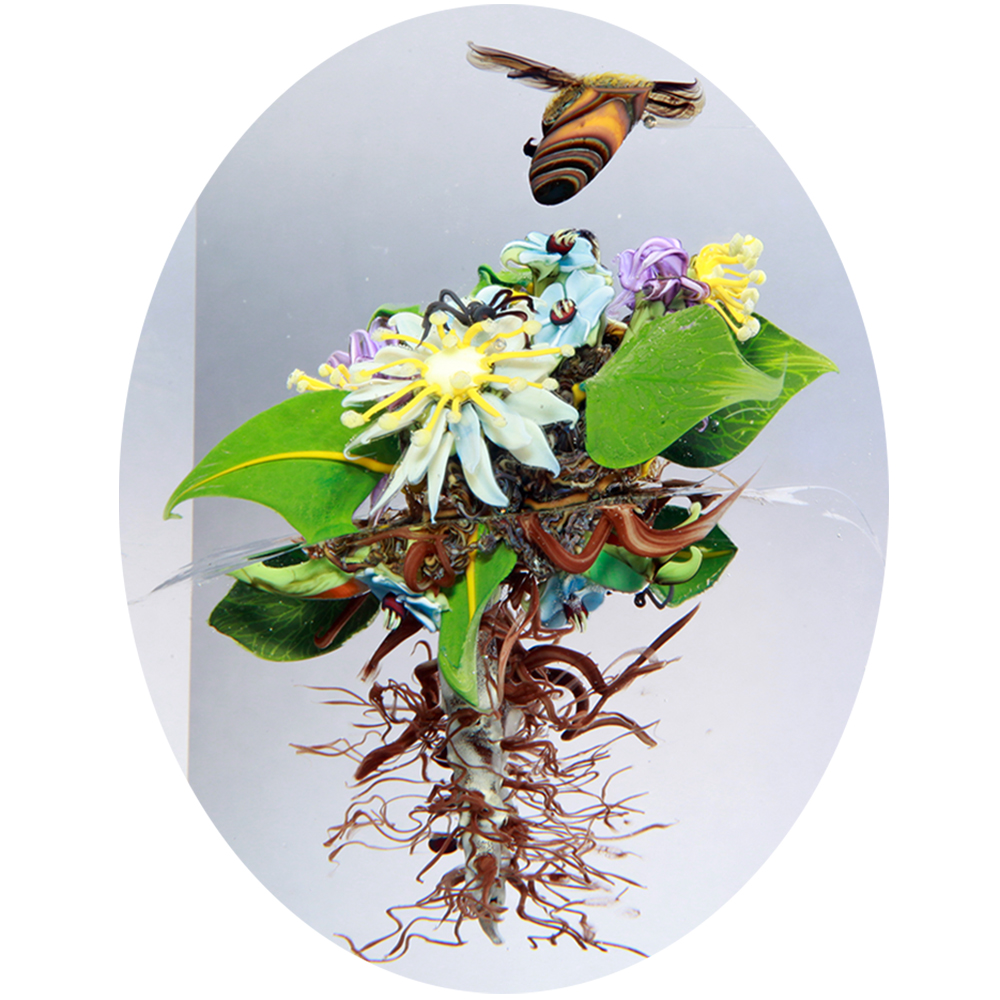
Nantucket Bouquet detail
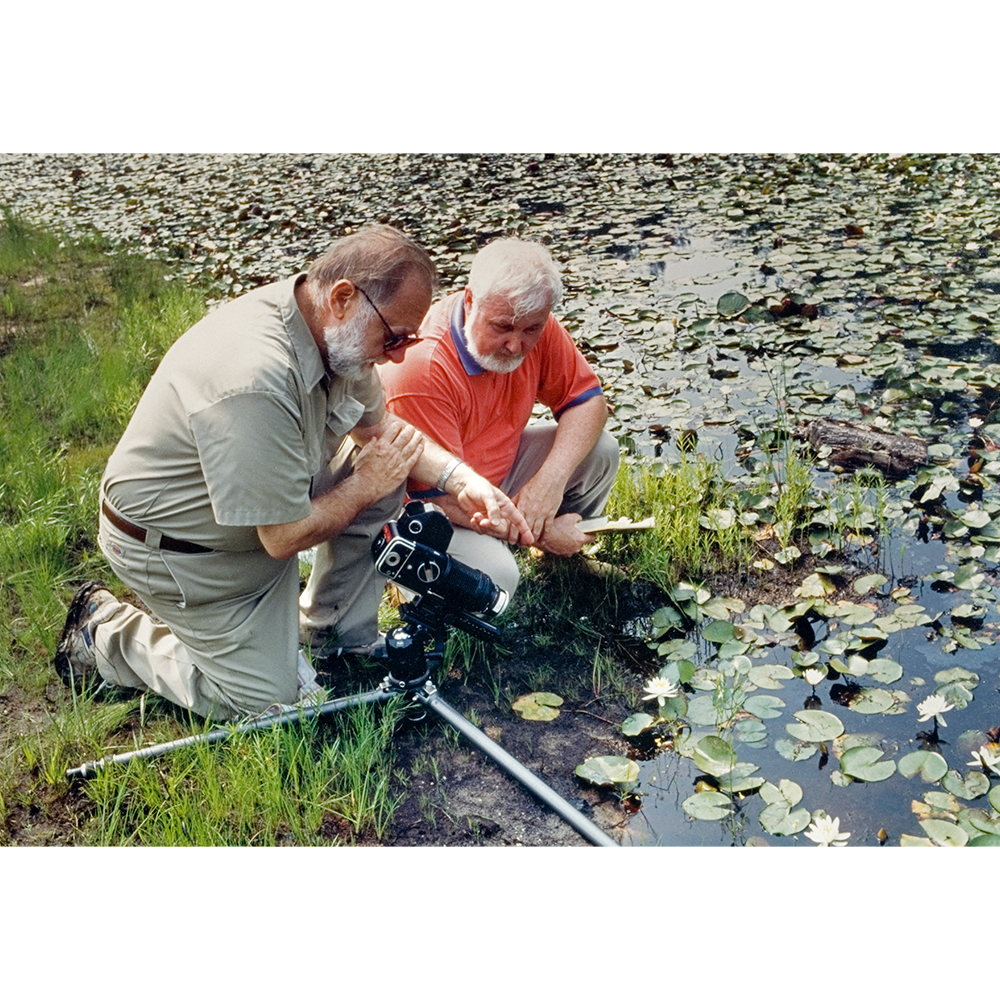
Paul Stankard and friend studying water lilies
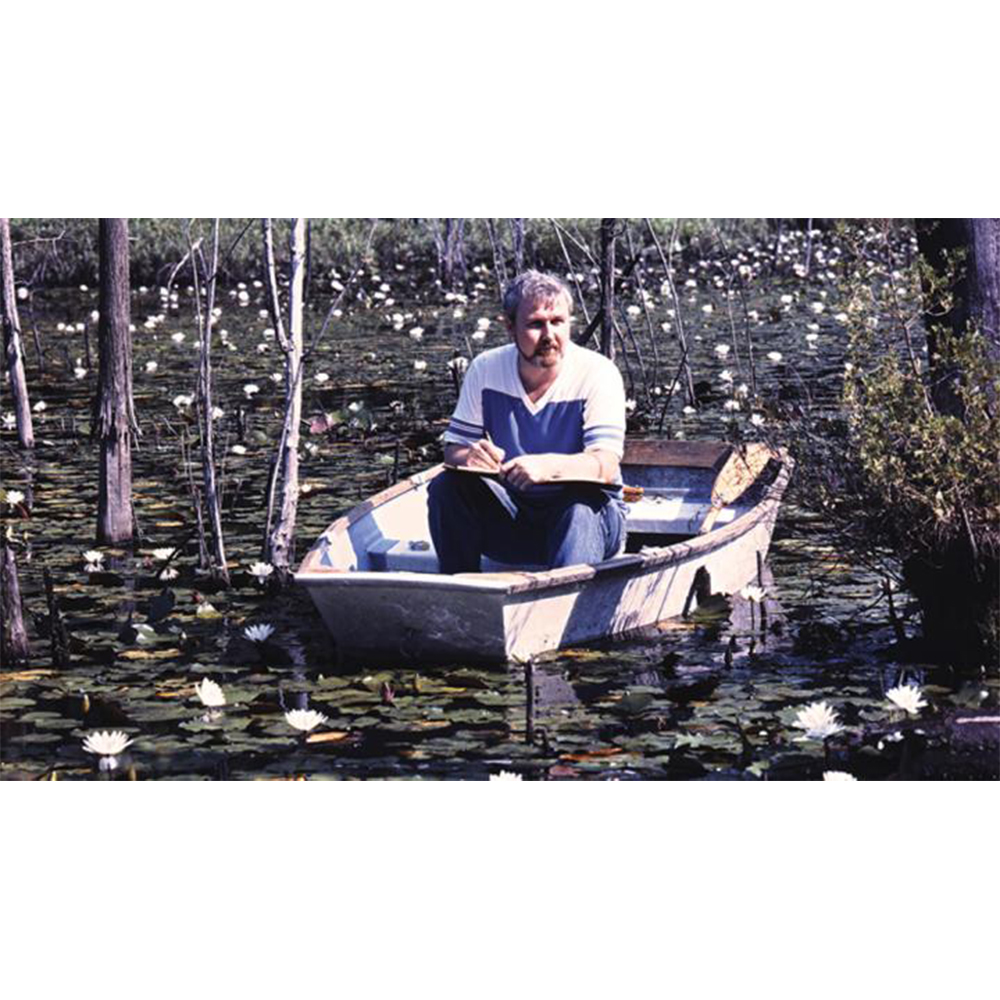
Paul Stankard
photo by Mike Diorio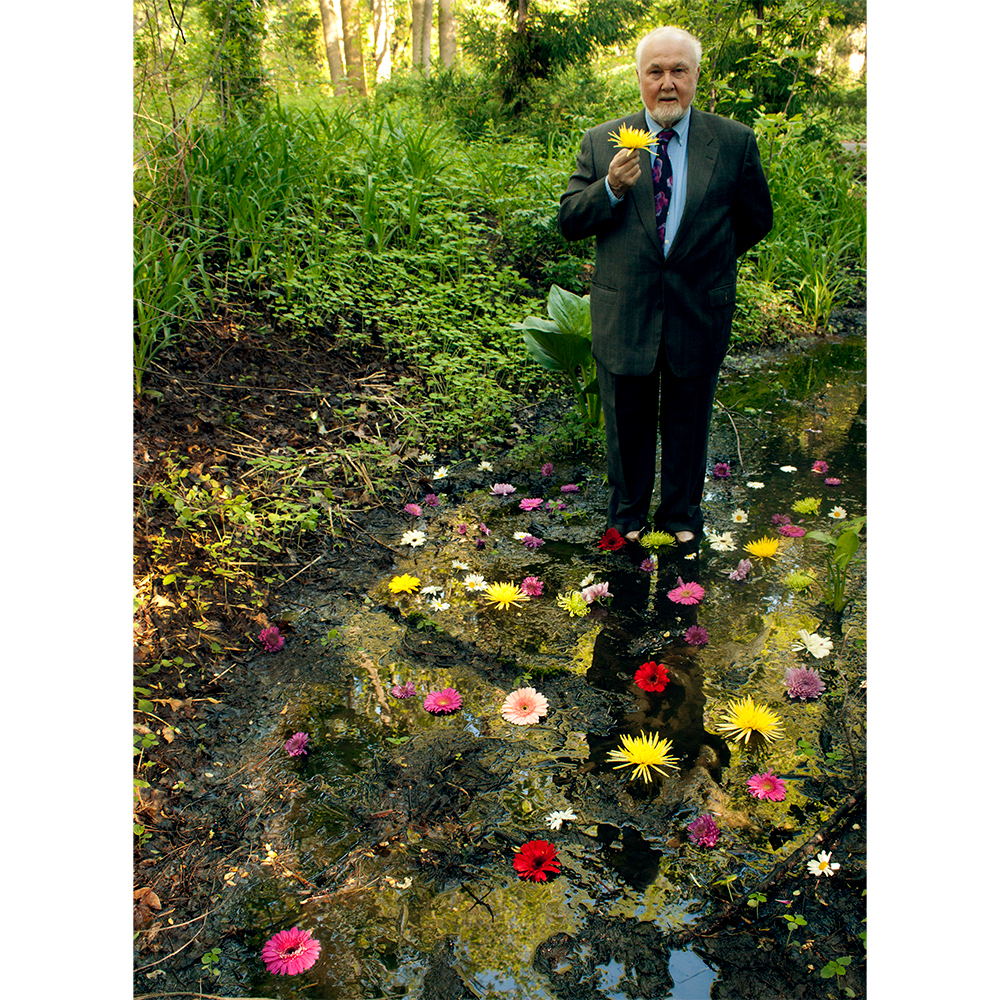
Paul Stankard communing with nature
photo by Lauren Garcia
''The art of art, the glory of expression and the sunshine of the light of letters, is simplicity.''
Walt Whitman
Poems of Glass
Paul is inspired by the poetry of Walt Whitman, who articulates a mystical depth of feeling bridging the earthly and the eternal. The effect of Whitman’s writing on Paul is visceral, and he refers to him as the patron saint of his studio. Like Whitman, Paul experiences the timelessness of nature when walking in the woods and wading through streams and swamps. He references the continuum of nature with poetic mosaic word canes, such as “seeds”, “fertility” and “decay” to create a visual dialogue with his audience. In his glass art and in his own poems, Paul endeavors to capture feelings about nature expressed by creative people who have touched his soul. A line (shown below) from Whitman’s Leaves of Grass resonates with Paul.
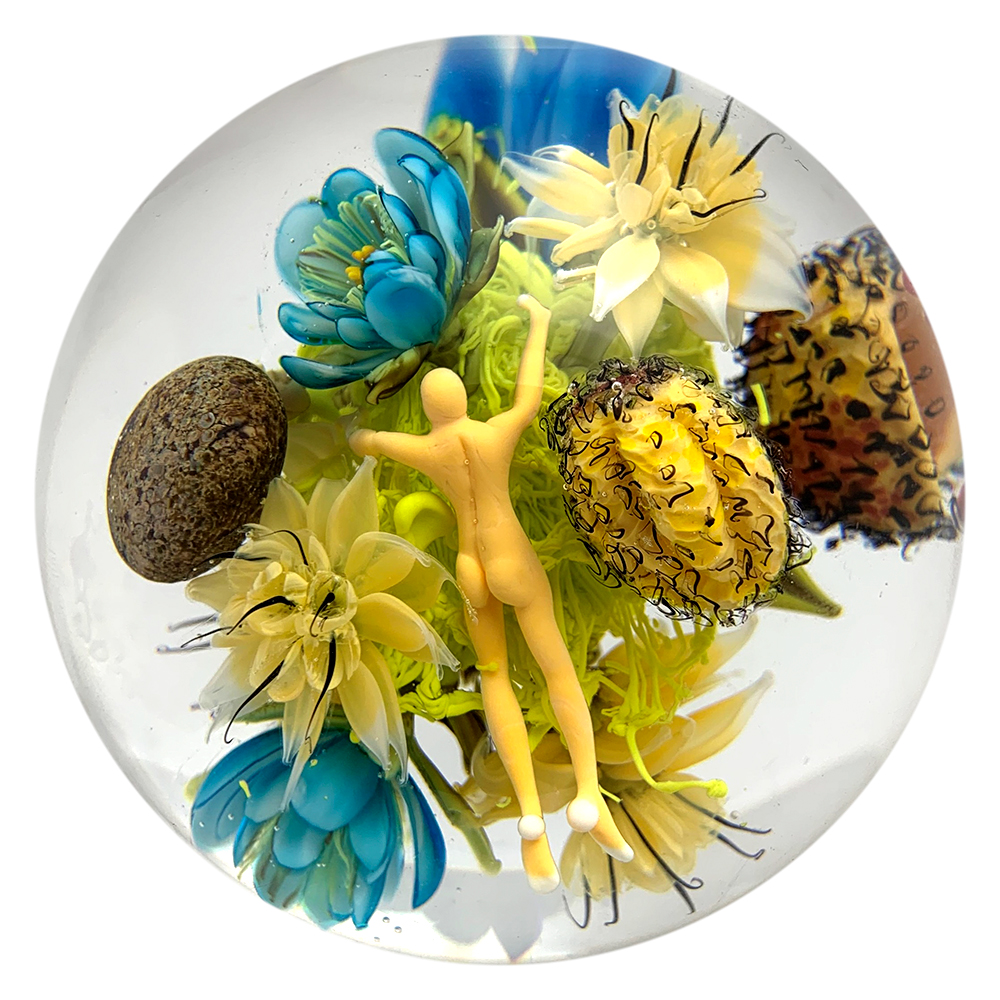
Walt Whitman’s Garden Bouquet Orb
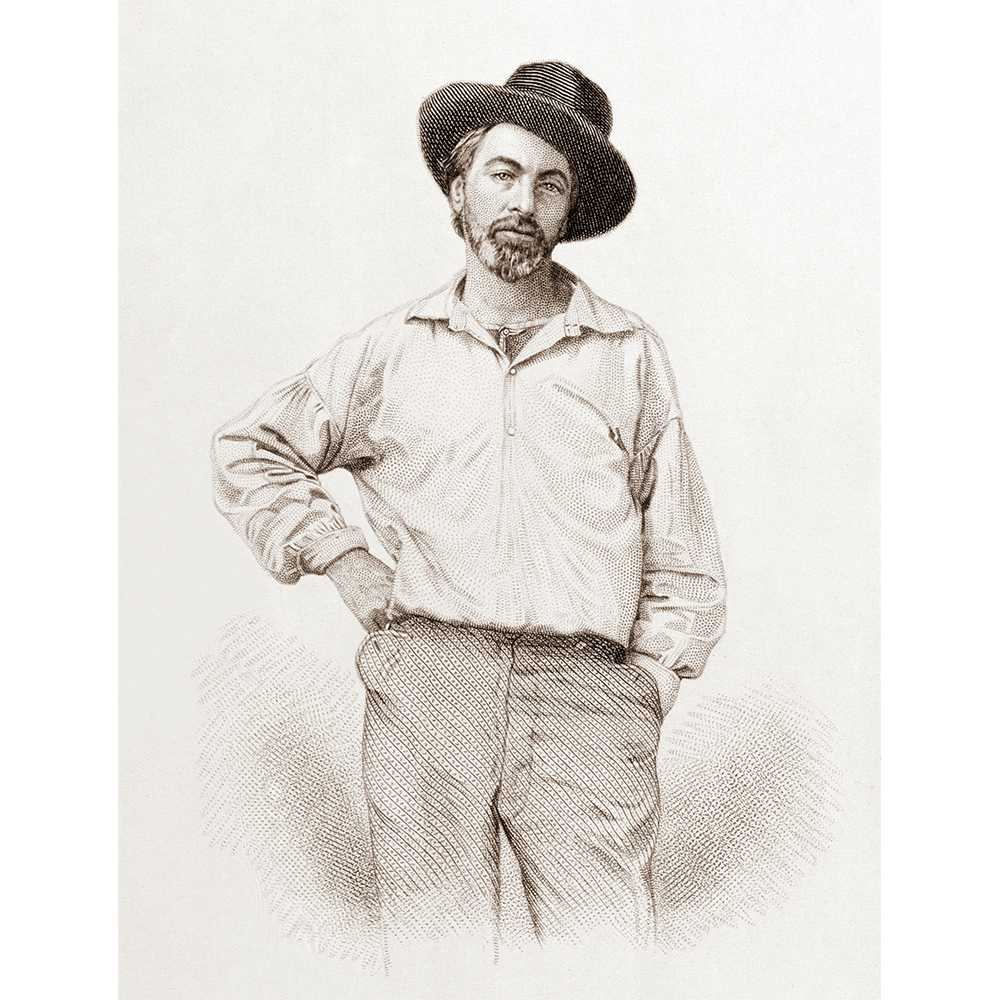
Walt Whitman
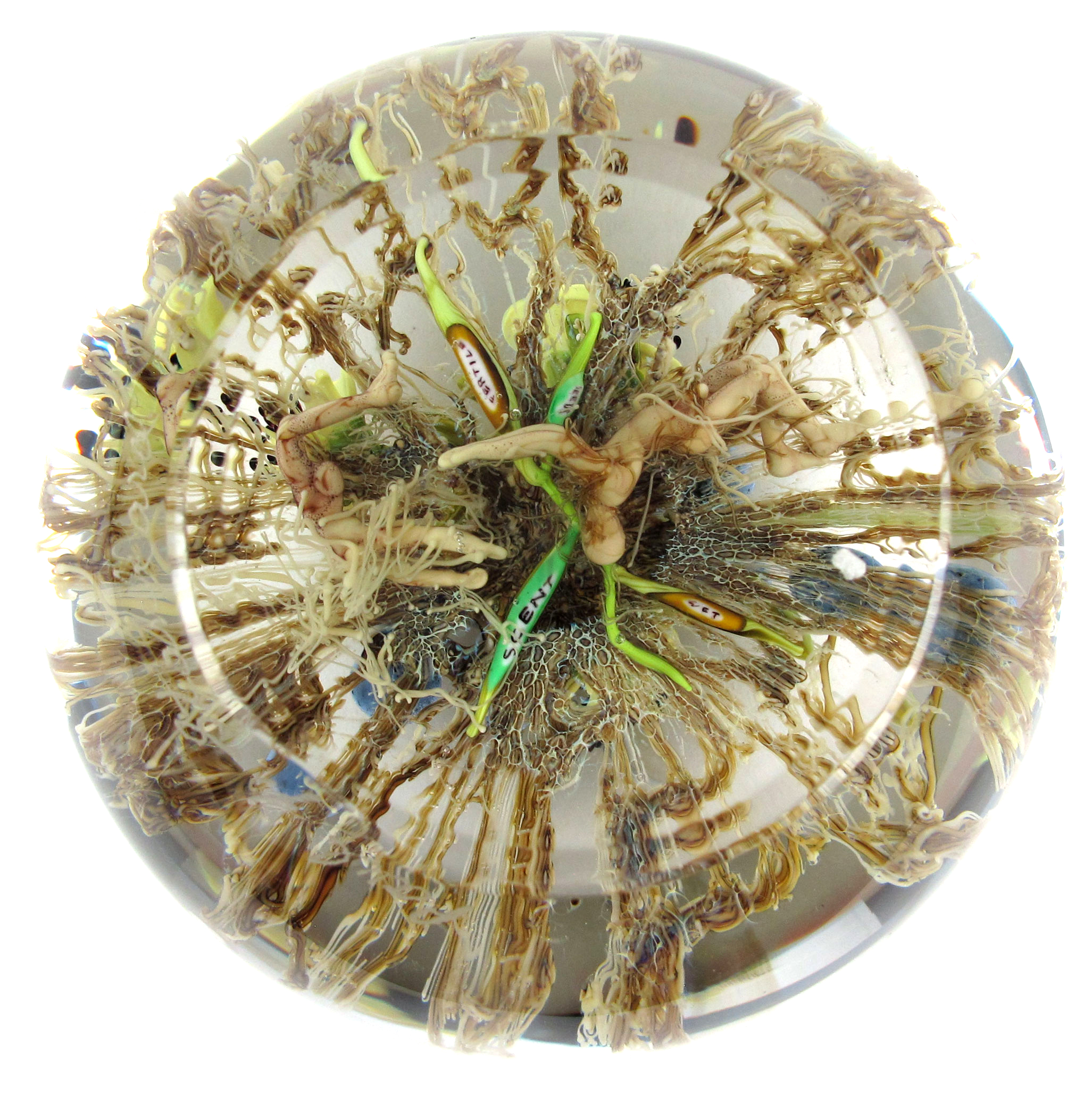
Word Canes
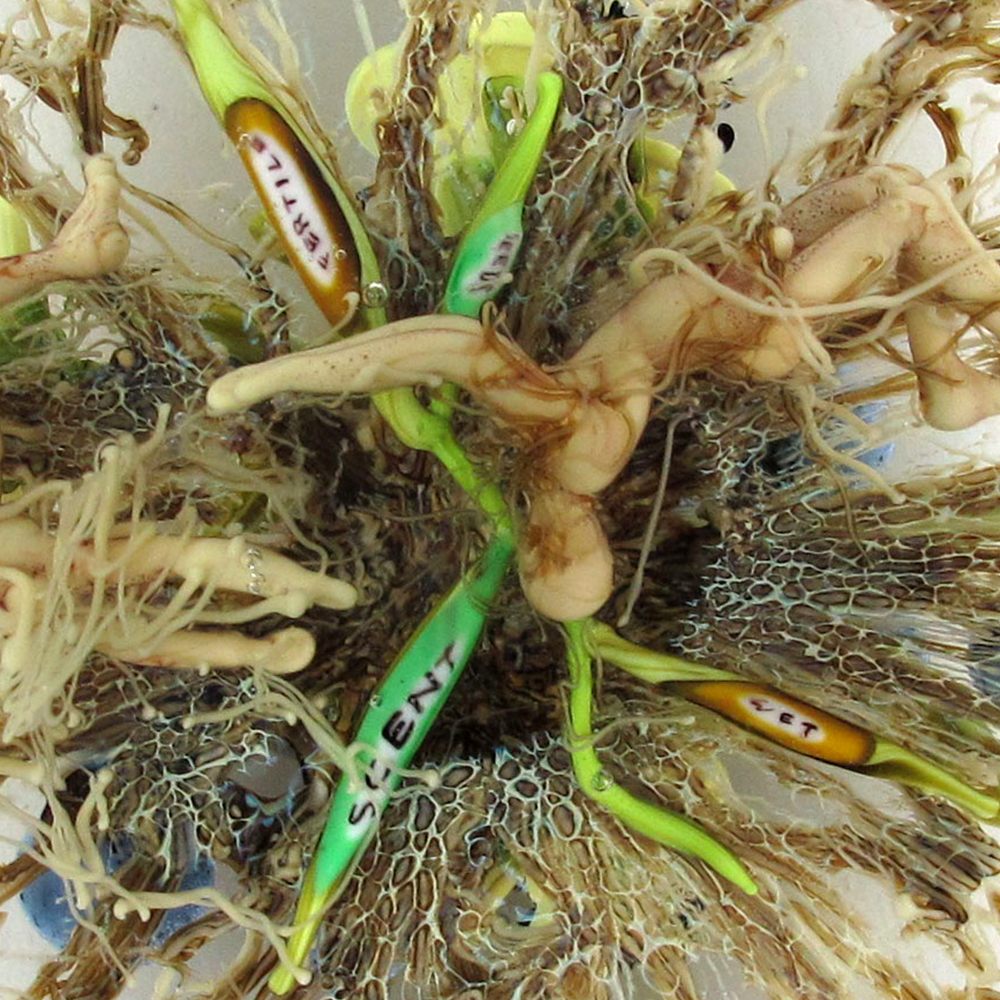
Word Canes detail
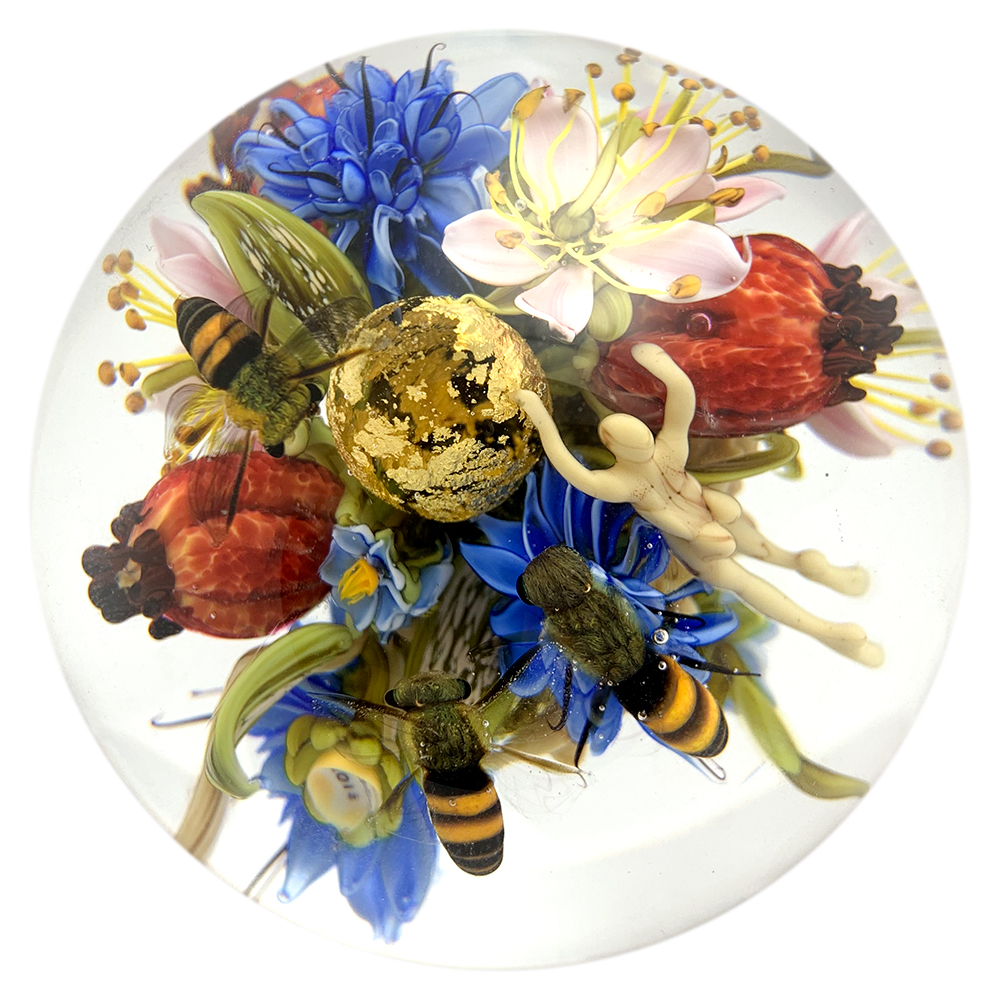
Homage to Walt Whitman Orb
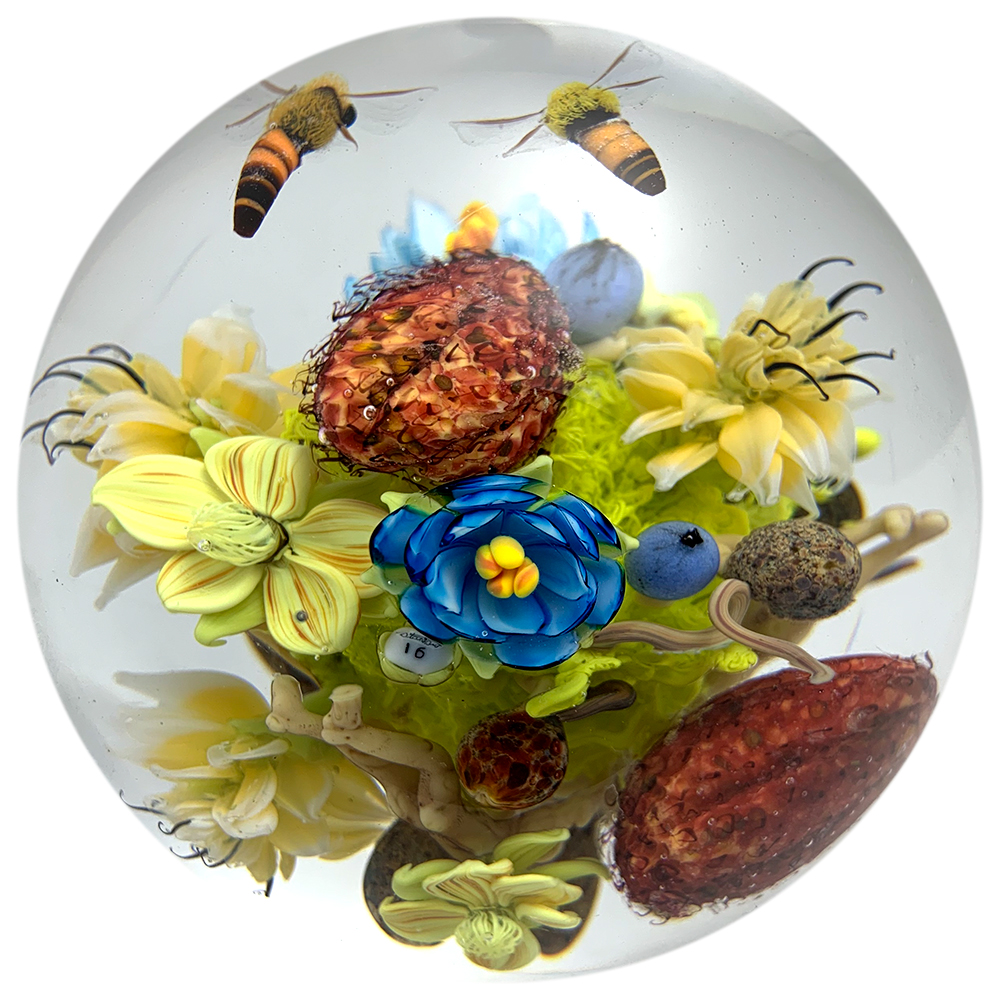
Walt Whitman’s Garden Orb
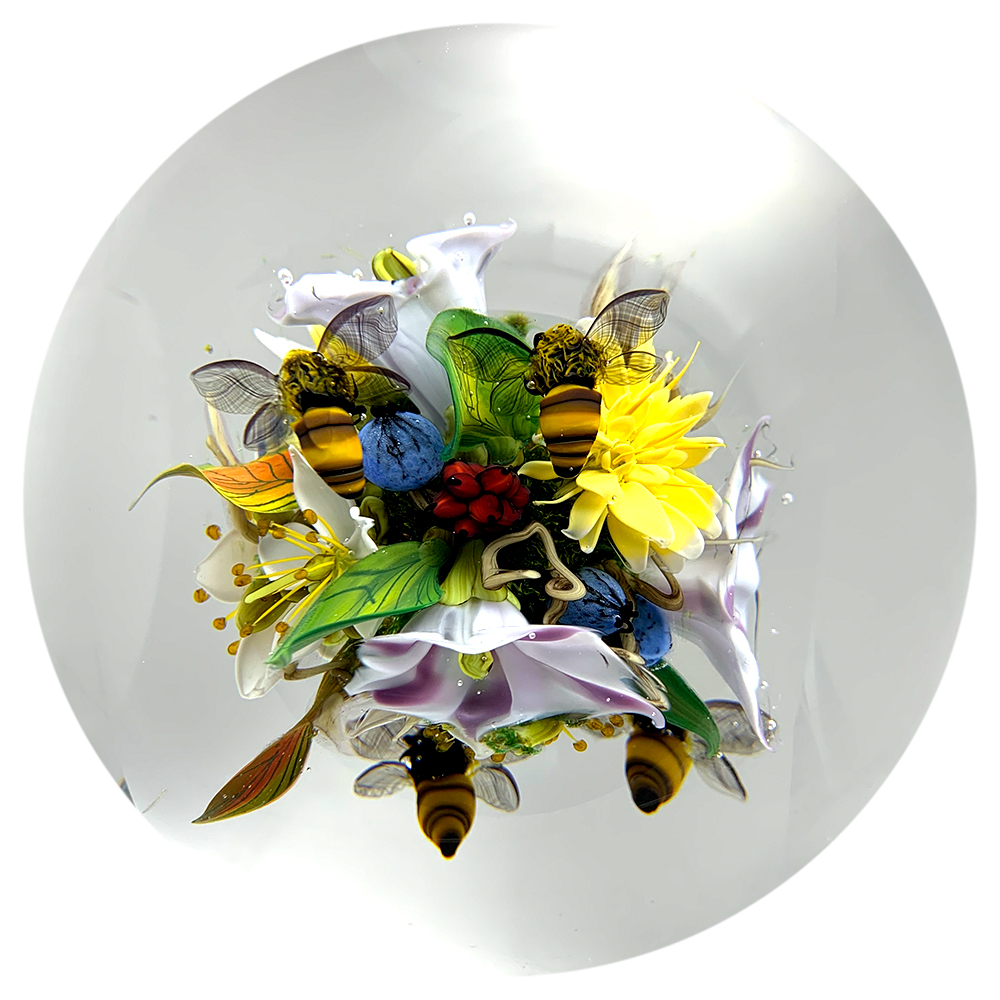
Morning Glory Bouquet Orb
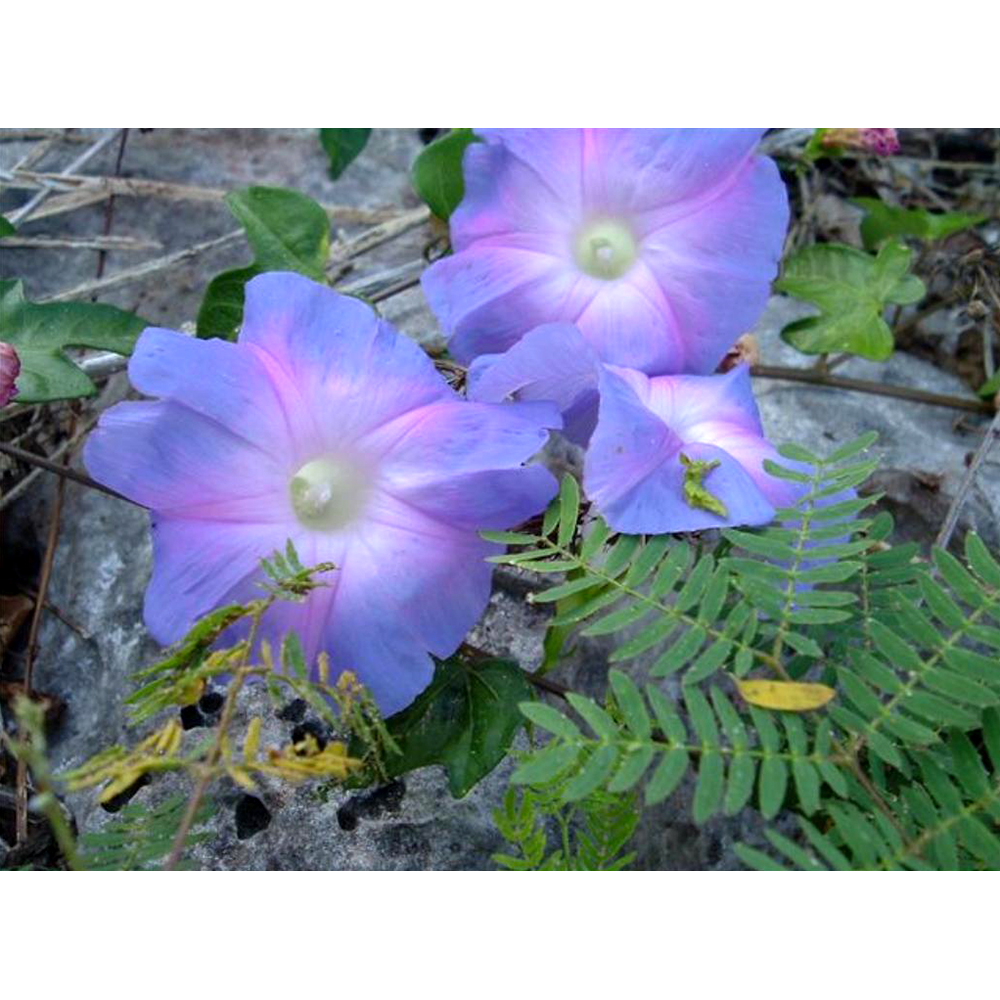
Morning Glories
“A morning-glory at my window satisfies me more than the metaphysics of books.”
Walt Whitman
Busy as a Bee
Honeybees often hover above Paul’s flowers engaged in pollination and the cycle of life. When he began to include bees in his work, he installed a hive outside his window so that he could watch them at work. He also wrote a poem celebrating this industrious insect. Bees have been declared the most important living being on the planet but sadly are now on the endangered species list. Other insects, such as spiders and ants, creep into Paul’s work occasionally and he began including damselflies when his daughter joined him as an assistant in his studio. Four of Paul’s five children have helped him with his work over the years, each contributing in no small way to the success of the Stankard Studio.
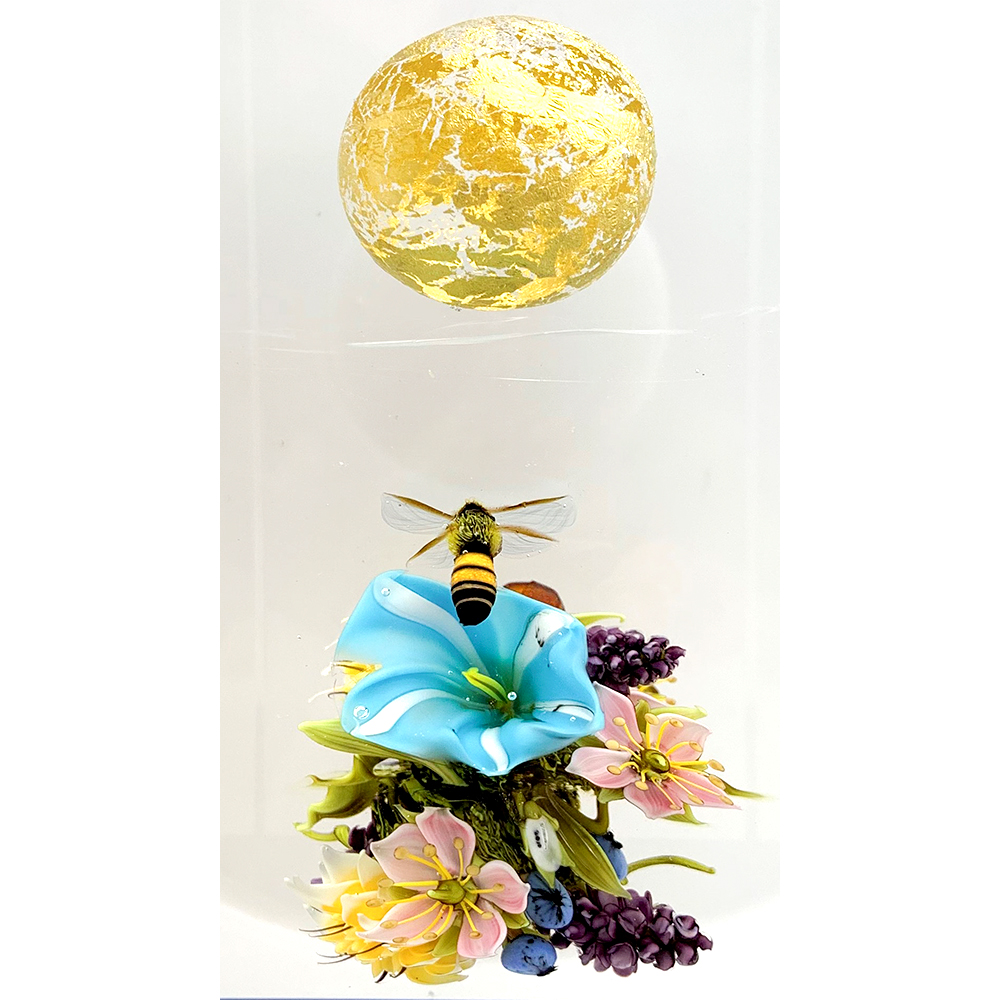
Morning Glory with Golden Orb detail
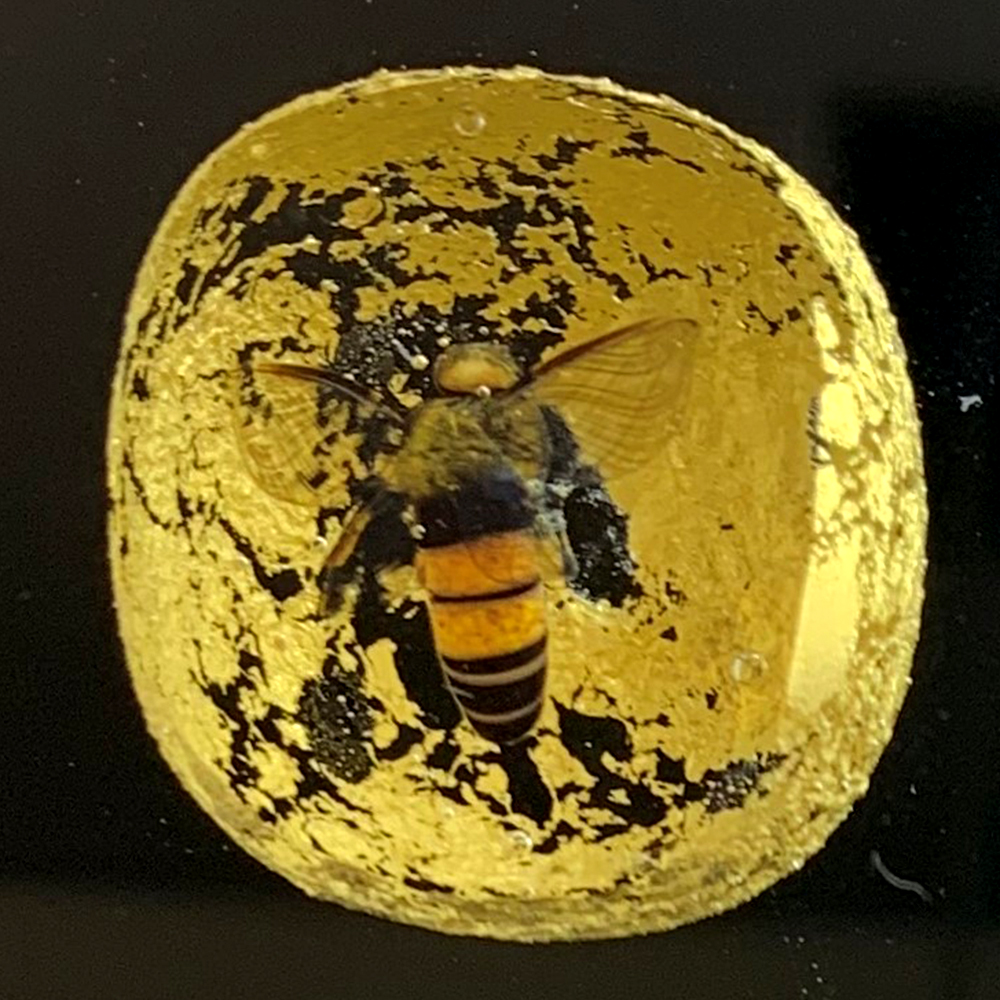
Homage to Walt Whitman Botanical Bee detail
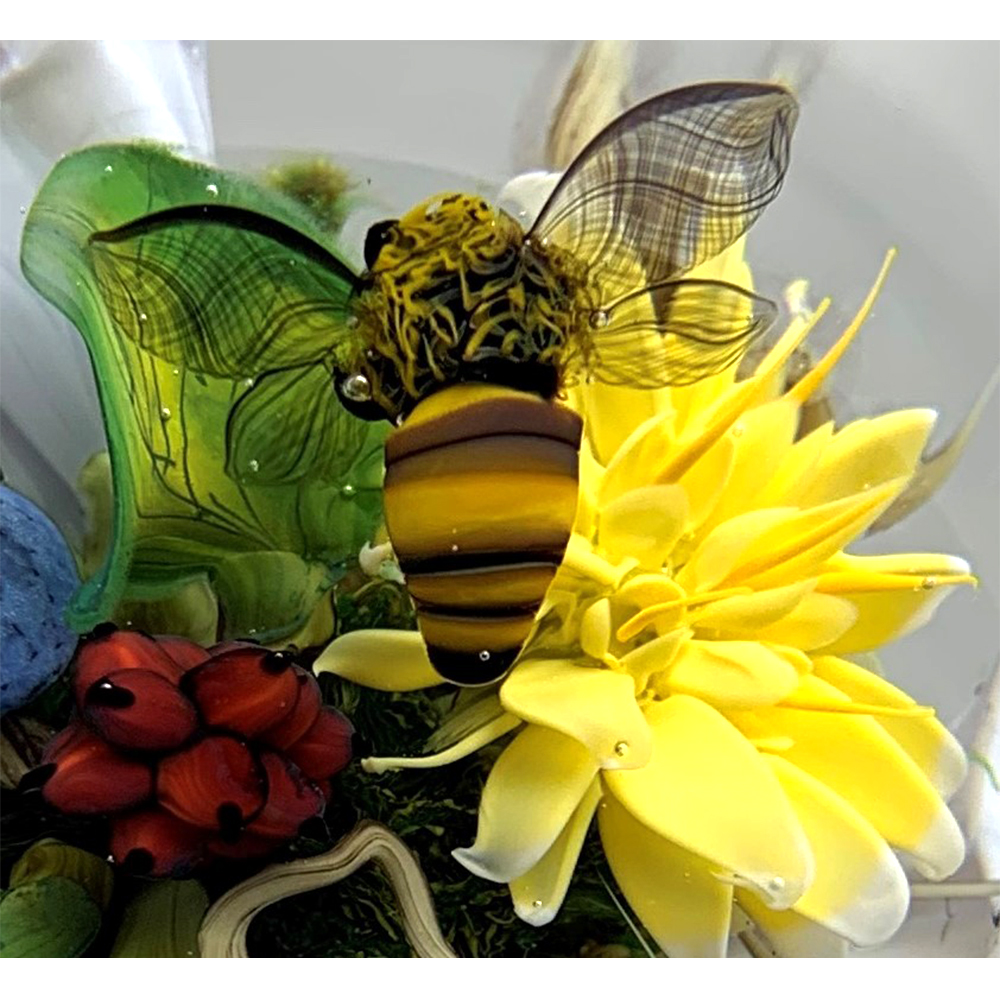
Morning Glory Botanical detail
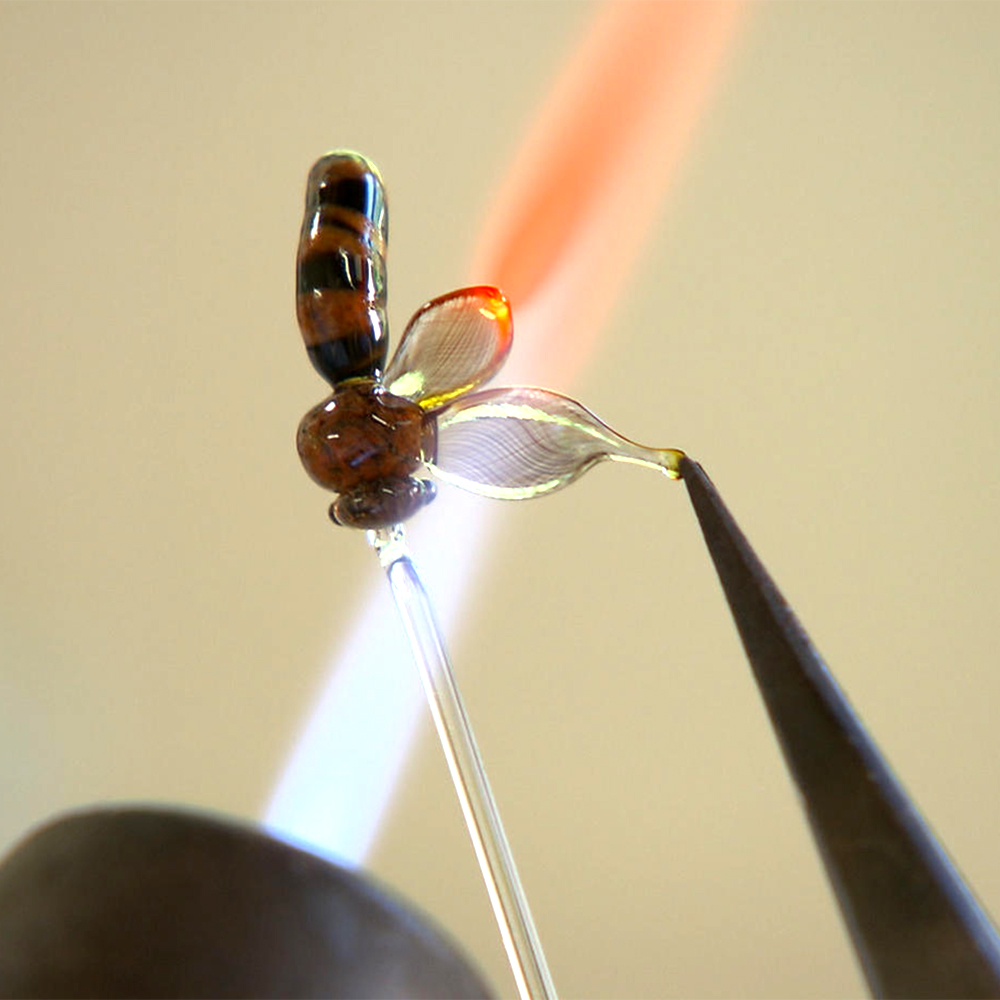
Making a bee courtesy CBS News
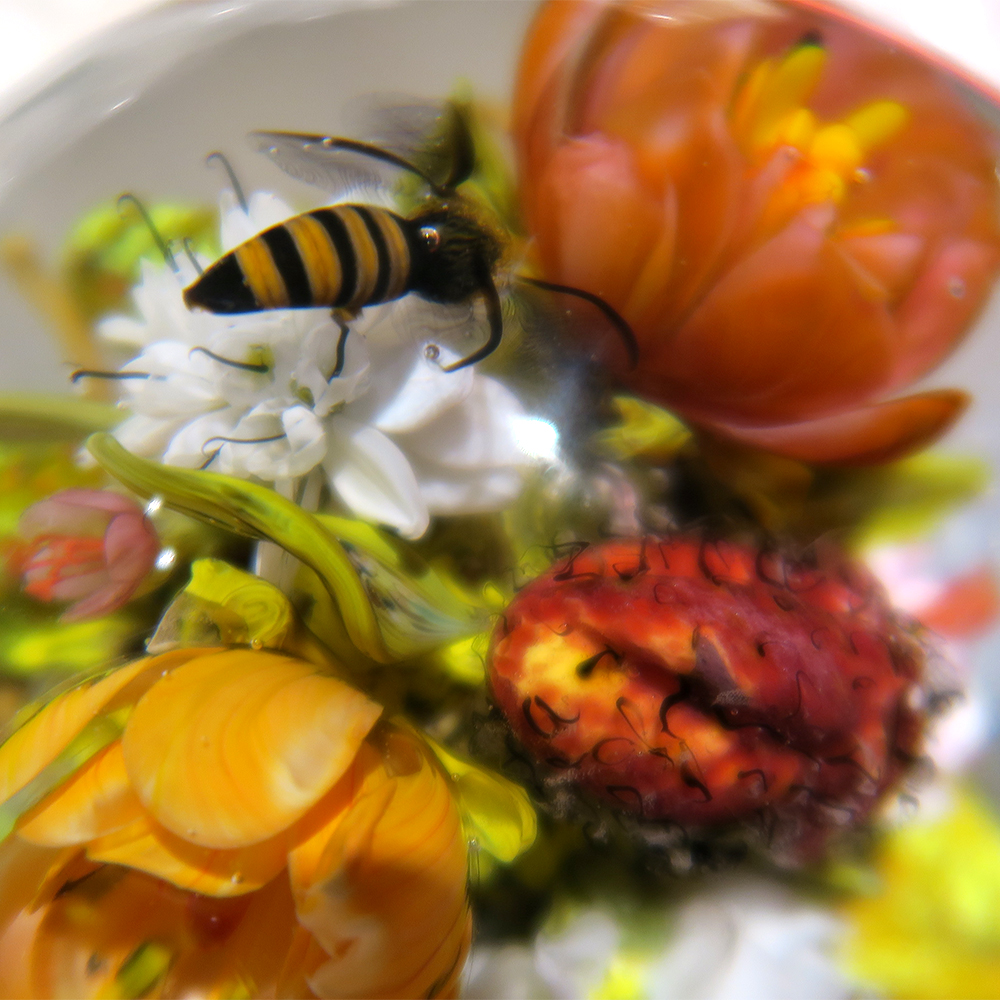
Emily Dickinson detail
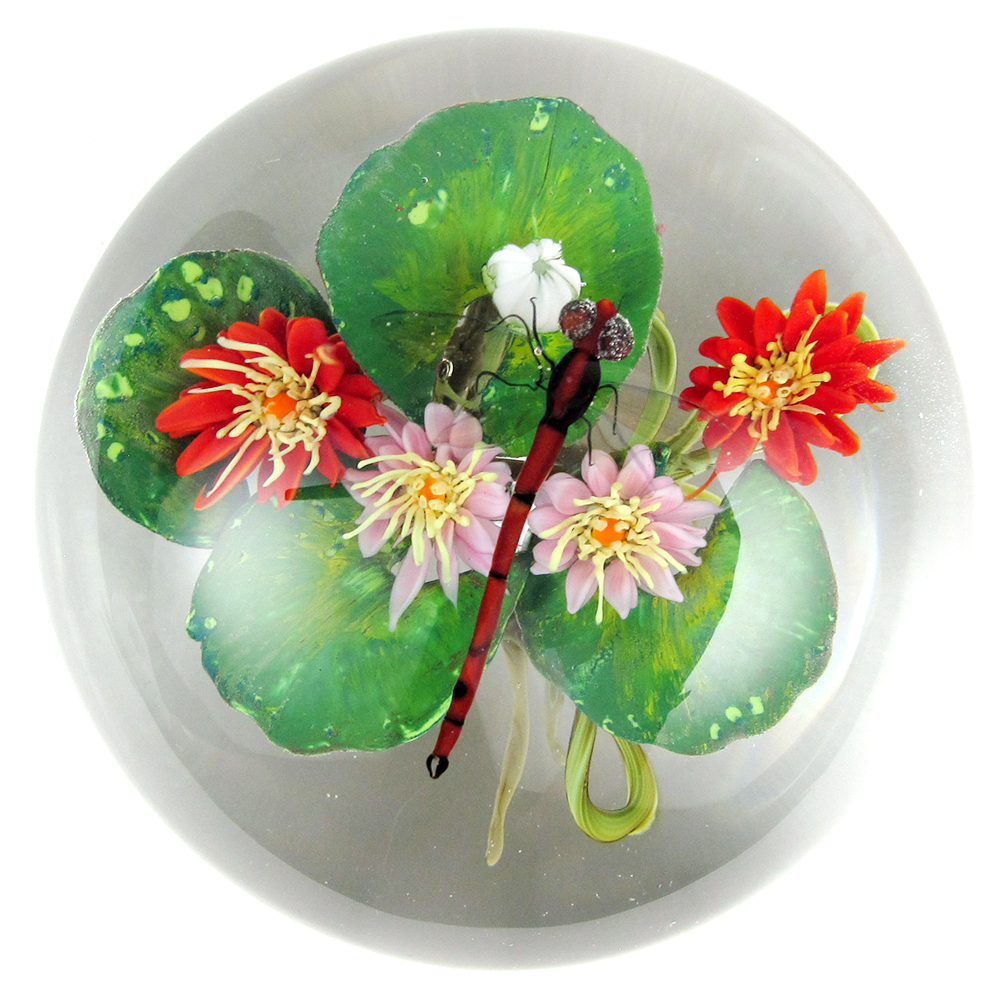
Waterlilies with Dragonfly paperweight
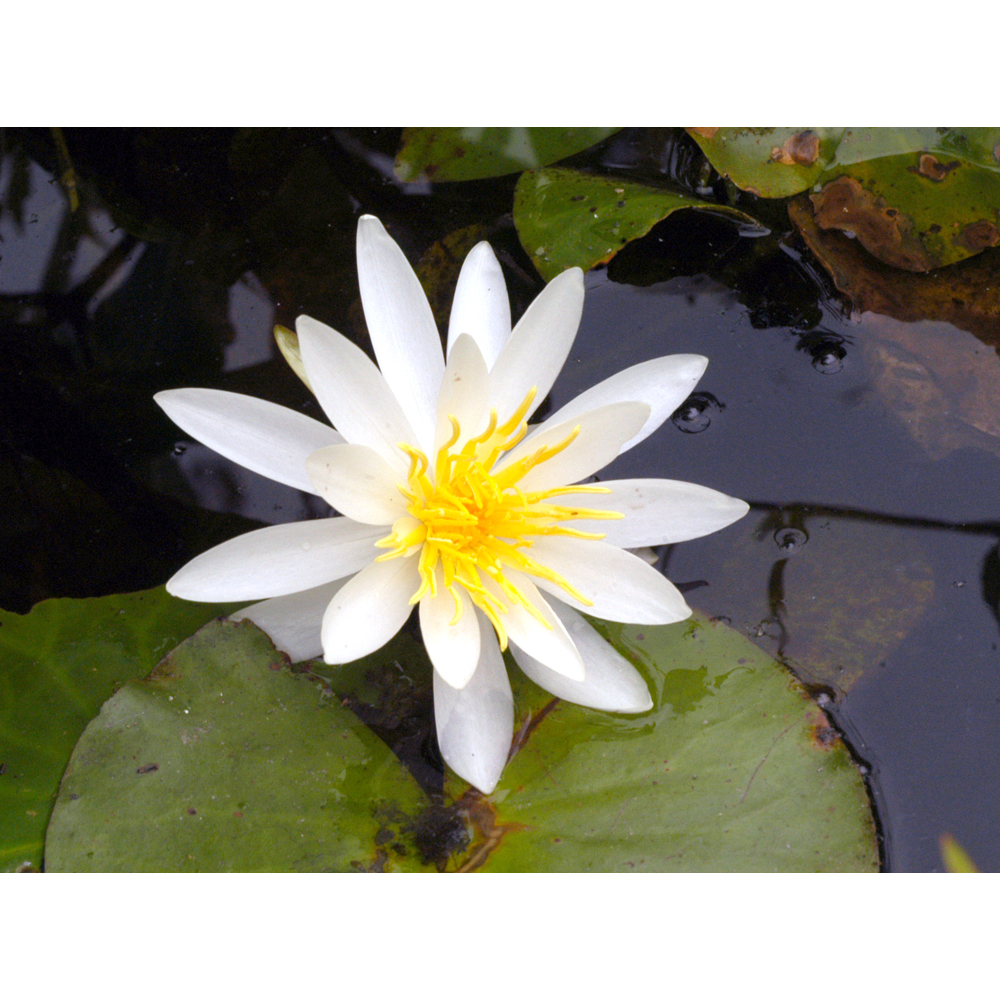
Waterlily
Read more about Bees...
Save the Bees
“It has been and still is a fantastic journey.”
Paul J. Stankard
Laborare est Orare
Paul is a very spiritual person and the motto of the Benedictine monks is inscribed in his studio - Laborare est Orare – Labor is Prayer. Underneath is written “Memento Mori” meaning “remember you will die.” Paul has shared his meticulous technical skills throughout his career and is an inspirational teacher of flameworking. He founded the innovative glass program at his alma mater, Salem Community College and has demonstrated internationally at prestigious art schools. His glass art is in many private collections and in more than 50 museums around the world. He has won countless accolades, honorary degrees, and more recently lifetime achievement awards from the glass community. Paul has written several books, including one about his personal odyssey as a glass artist No Green Berries or Leaves.
The Art of the Flame exhibition.

"Laborare est Orare" on wall of studio
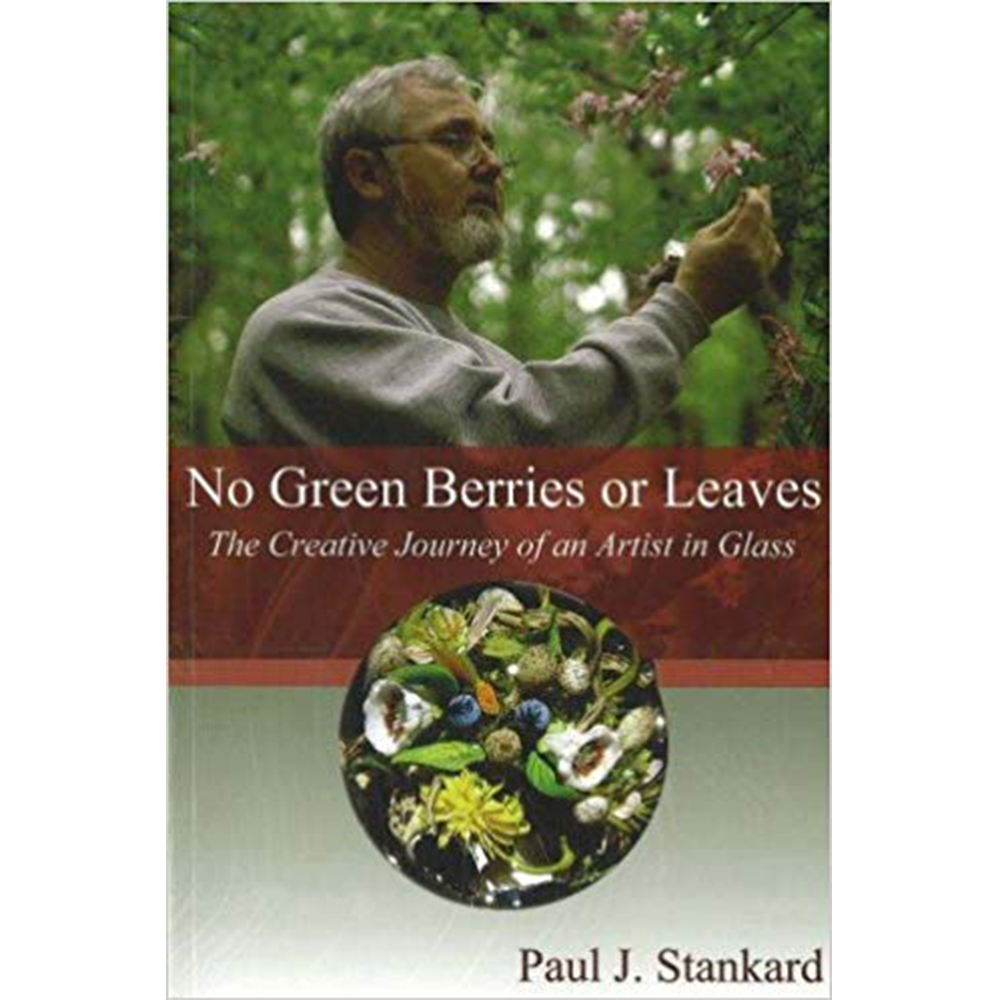
No Green Berries or Leaves
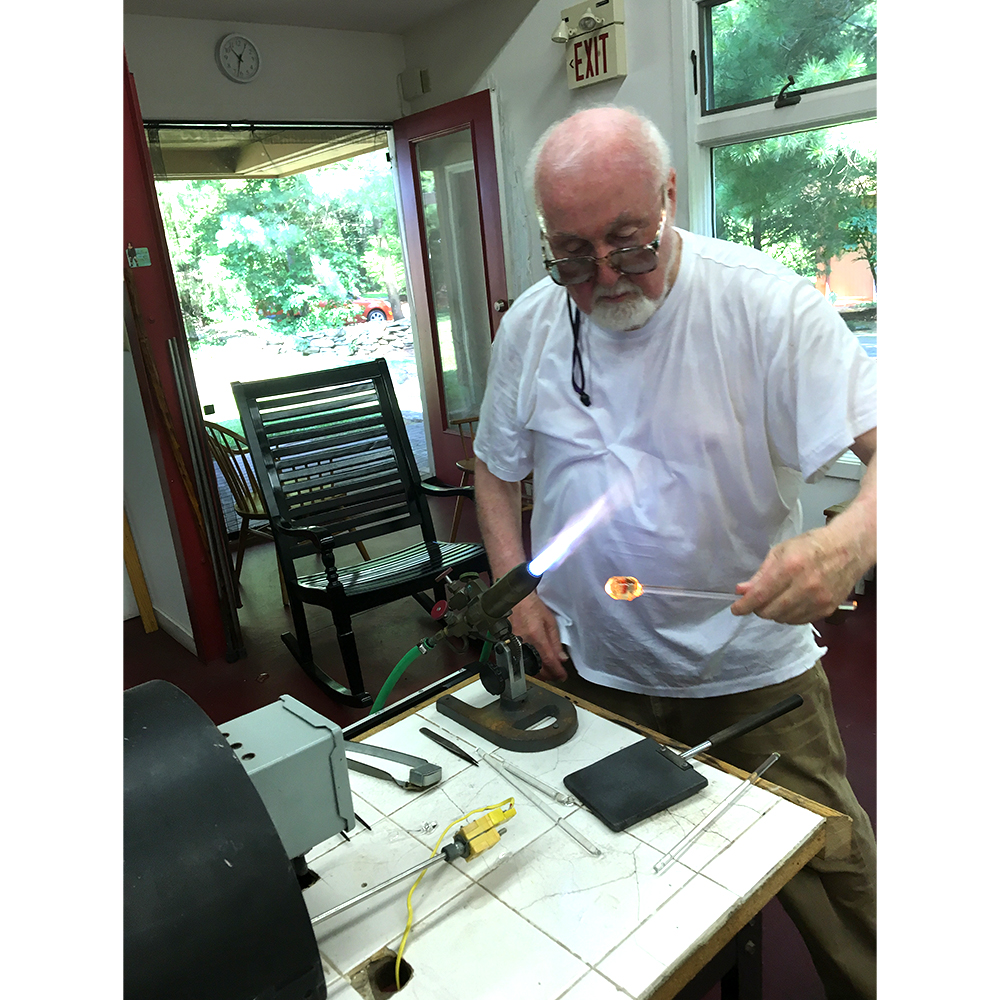
Paul Stankard working in his studio
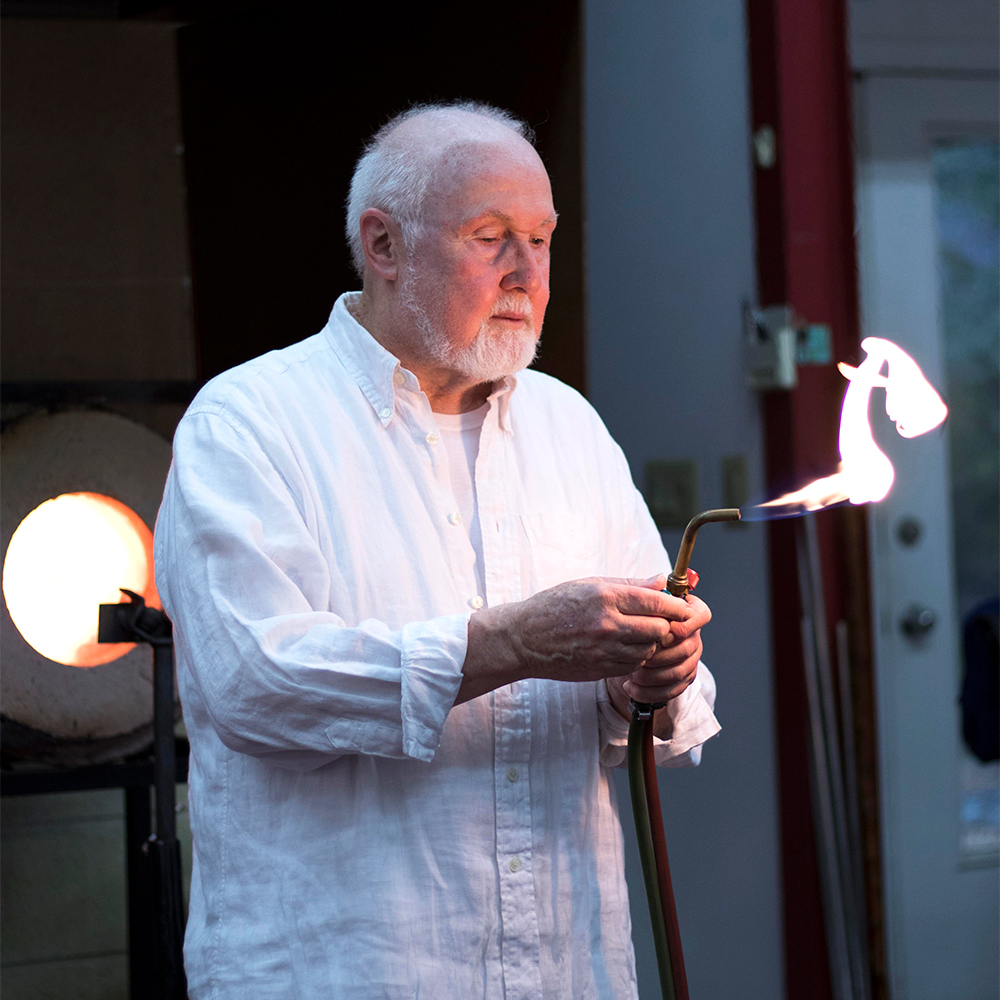
Paul Stankard with his creative flame
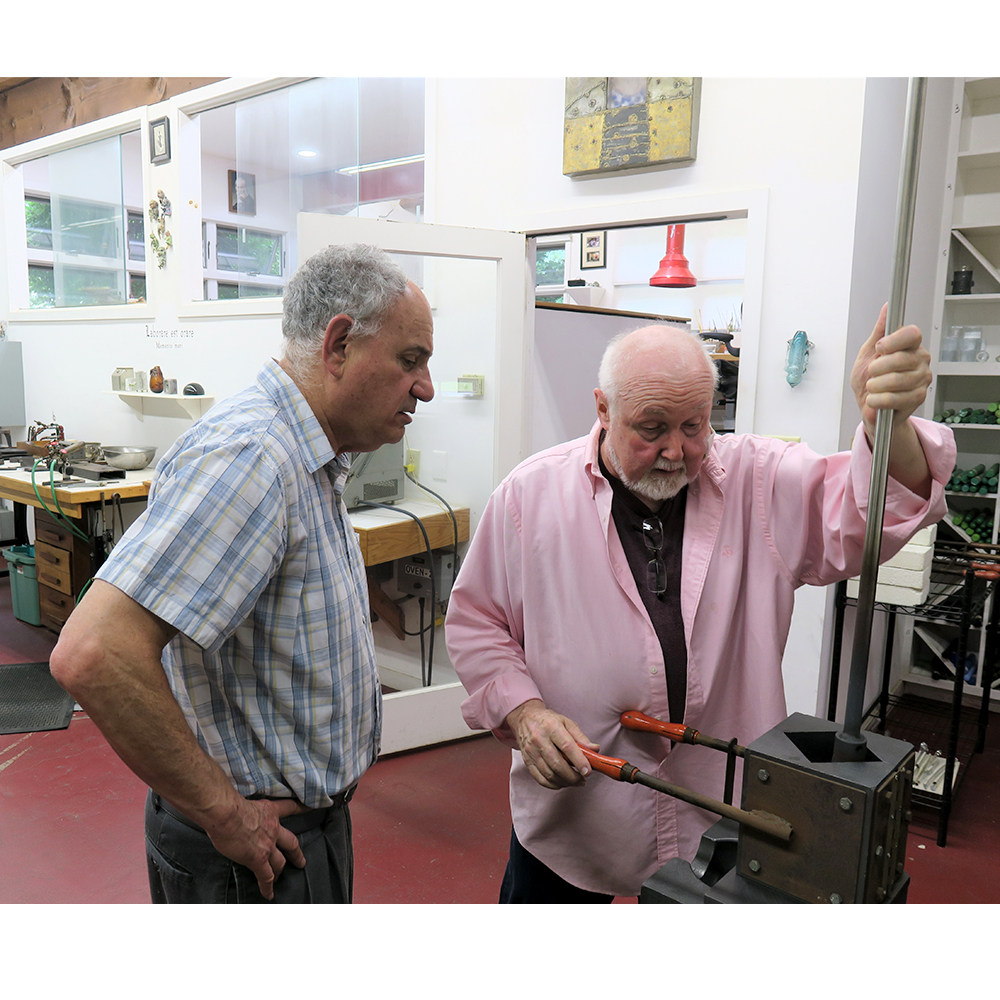
Paul Stankard and Arthur Wiener
Acknowledgment
Many photographs are courtesy of the artist
"Whether one is self-taught or a graduate of a formal arts program, rising to the top of your field and being recognized for doing significant work is difficult. It’s a major accomplishment."
Paul J. Stankard
Listen to Talking Out Your Glass podcast featuring Paul Stankard
Read more about Paul J. Stankard...
Paul J. Stankard - The Art of the Flame
Paul J. Stankard - Golden Orbs
Paul J. Stankard - Poetry in Glass
Paul J. Stankard - Gardens of Glass
Paul J. Stankard - Orchids Celebration
Paul J. Stankard - Brilliant Botanicals
Paul J. Stankard - Beauty Beyond Nature

